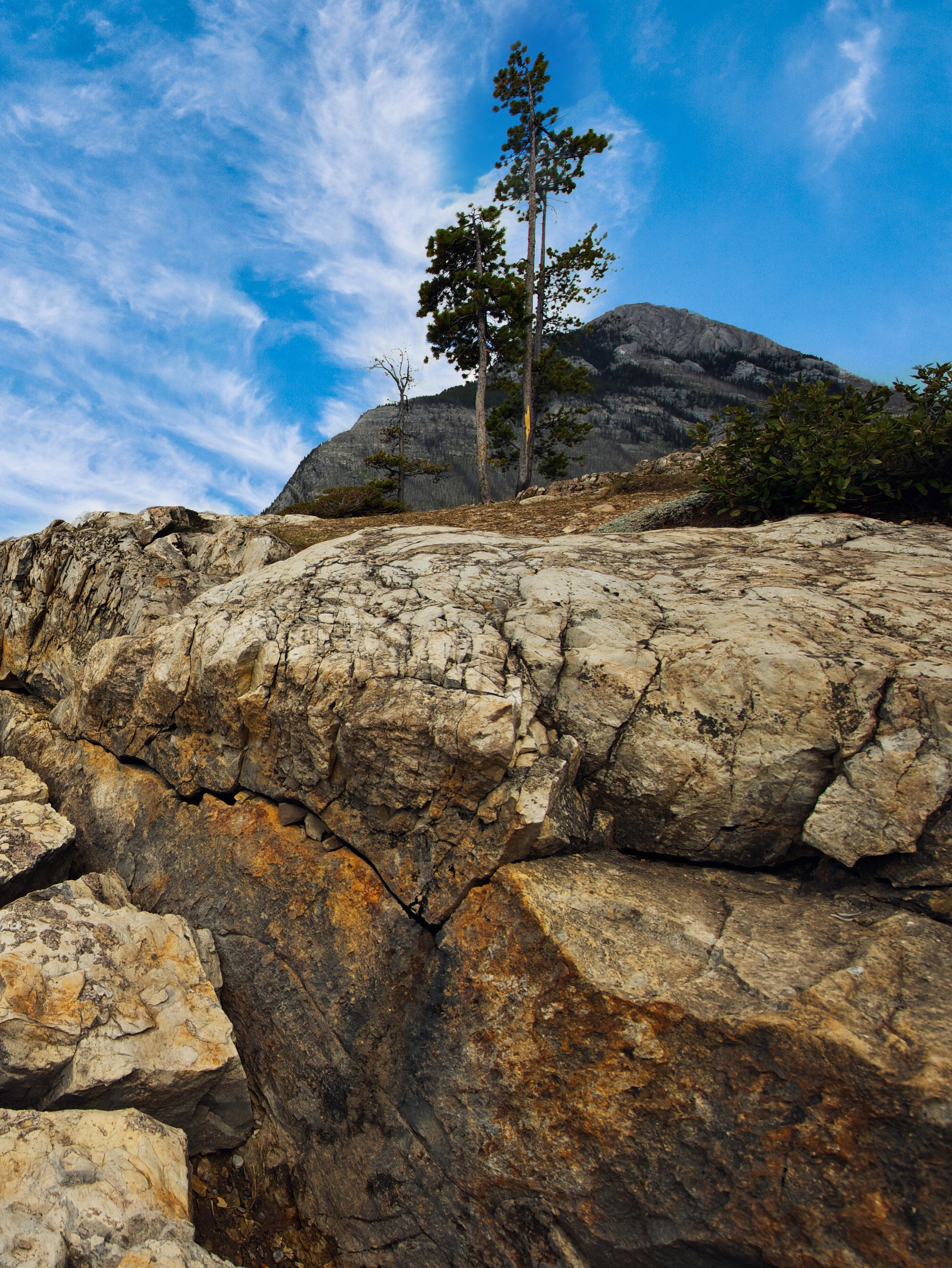PDAC IN THE NEWS
INDIGENOUS AMBASSADORS
MINERAL FINANCE
S-IMEW 2025 IN PICTURES RESTOR-ACTION IN THE NORTH
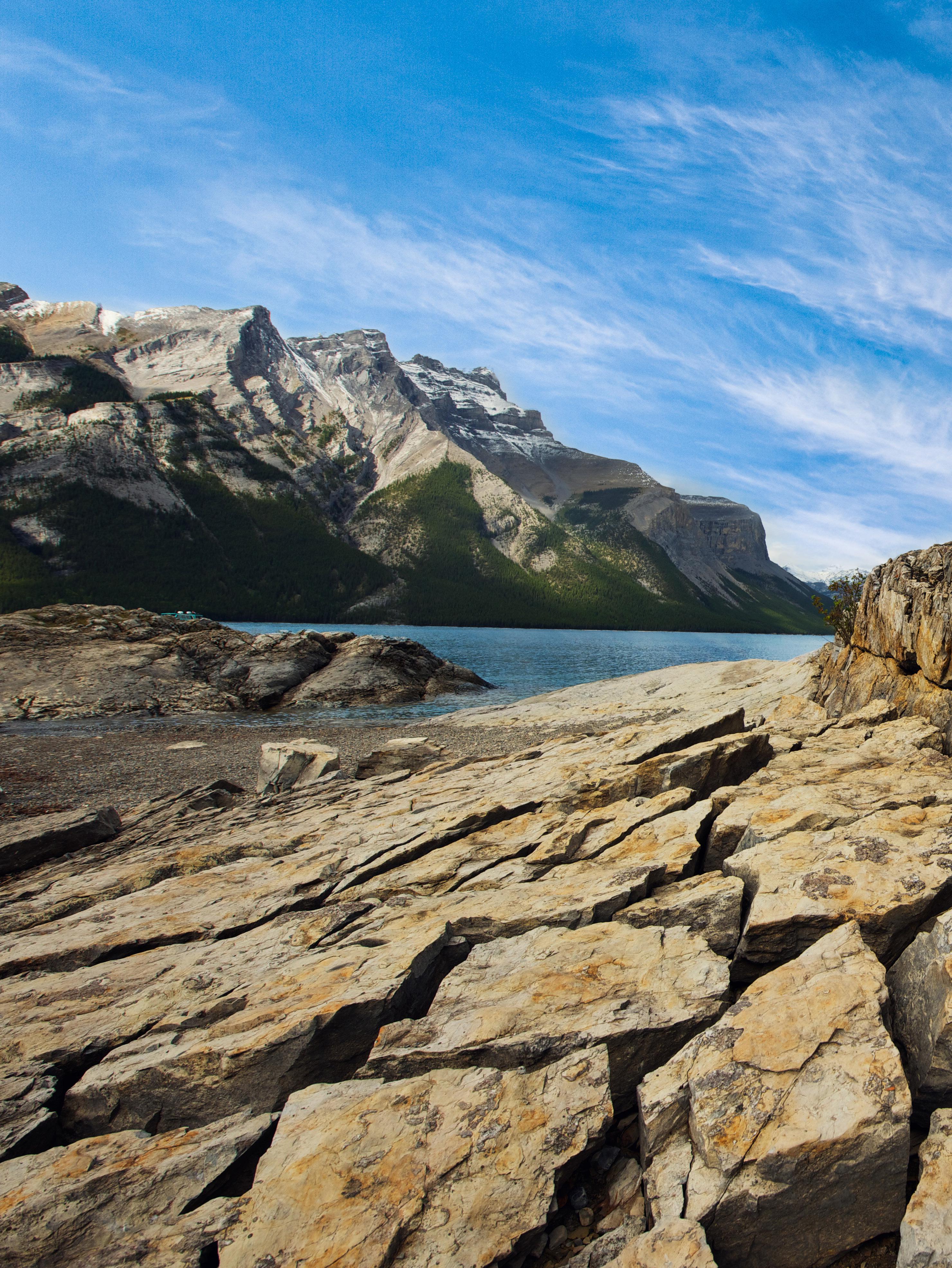
THE VOICE OF MINERAL EXPLORATION

PDAC IN THE NEWS
INDIGENOUS AMBASSADORS
MINERAL FINANCE
S-IMEW 2025 IN PICTURES RESTOR-ACTION IN THE NORTH

THE VOICE OF MINERAL EXPLORATION
THE MEMORABLE MOMENTS, EVENTS & EXPERIENCES FROM THE WORLD’S PREMIER MINERAL EXPLORATION AND MINING CONVENTION IN TORONTO, CANADA
PDAC respectfully acknowledges that we gather today on the traditional territory of many nations including the Mississaugas of the Credit, the Haudenosaunee, the Wendat-Huron, the Chippewa and the Anishnabeg, and all of the Indigenous Peoples that have lived on these lands over the centuries.
As the voice of Canada’s mineral exploration community, the Prospectors and Developers Association of Canada acknowledges the sacred land we walk upon and all First Nations, Inuit and Métis peoples across Canada. We are committed to reconciliation through meaningful and mutually beneficial partnerships between the mineral sector and Indigenous communities.
We recognize that, as a global industry, we engage with organizations and individuals from around the world. We encourage you to reflect upon the traditional lands and the Indigenous Peoples of wherever you call home.
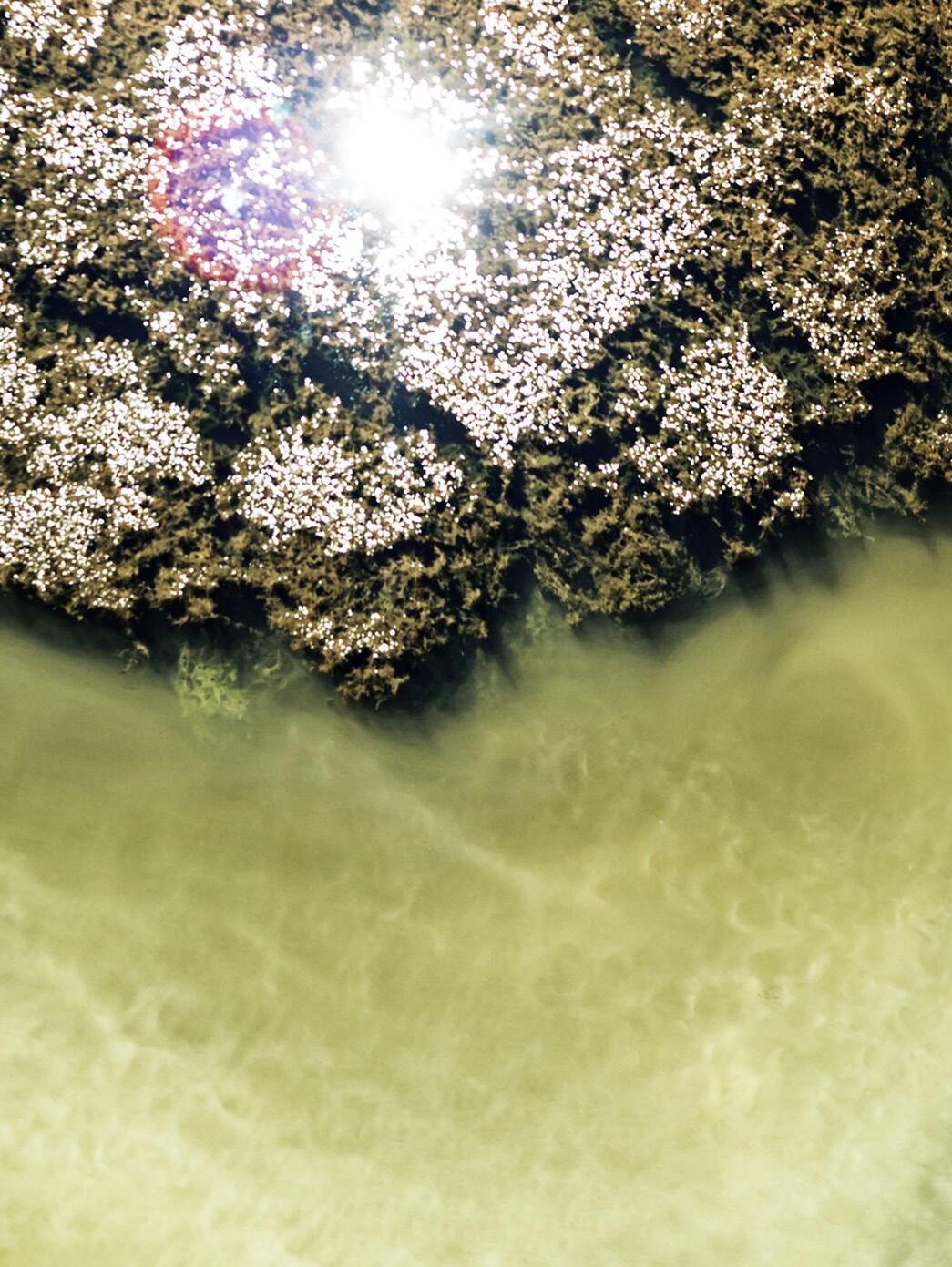
SUMMER 2025
PRODUCED & PUBLISHED BY PDAC’s Communications Dept.
800-170 University Avenue Toronto, Ontario
M5H 3B3 Canada
416.362.1969
PUBLICATIONS EDITOR & DESIGNER
Andy Stanleigh
PUBLICATION DATE
JULY 10, 2025
CONTRIBUTORS
Ariya Andrighetti
Alex Armstrong
Scott Barber
Lynn Bodwell
Jeff Killeen
Nicole Kulp
Ran Maoz
Florence MacLeod
Krishana Michaud
COPYRIGHT ©2025 PDAC
PHOTO CREDITS
PDAC Archives
FOLLOW PDAC
Page 50 Adario Masty, Abandoned Mining Exploration Sites Clean Up Coordinator, CNG. Used with permission. All rights reserved. thePDAC thePDAC the _PDAC ThePDAC PDAC_official
A roundup of key milestones, updates, and PDAC-related coverage – featuring events, announcements and association accomplishments.
Get to know Karen Rees, PDAC’s new president, as she reflects on nearly four decades of exploration work in Canada
Highlights from the award-winning industry showcase in Toronto, including the Dr. Donald M. Leishman Student Convention Experience, the inaugural Indigenous Youth Ambassador Program, and the debut of PDAC's new land acknowledgment artwork.
Recapping S-IMEW in Sudbury, Ont., with daily photos and captions covering the industry-renowned two-week annual event.
An in-depth examination of the minerals and exploration financial market, including data, graphs and insights into 2025 trends.
Spotlighting the successful completion of the Nunavik Abandoned Mineral Exploration Sites Restoration Project and the ongoing Abandoned Exploration Sites Clean-Up James Bay project in northern Québec. 34 40 46 4 8 1 2 4 54 54 THIS MONTH IN HISTORY
Born in the summer of 1881, Dr. Alice Evelyn Wilson overcame cultural barriers and chronic illness to earn national and global recognition as Canada's first female geologist. 46 12

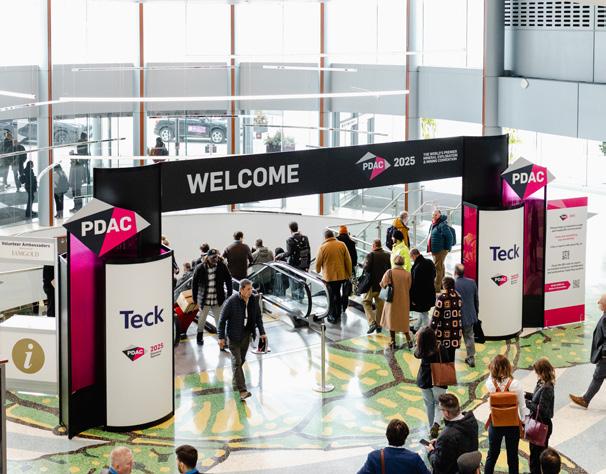
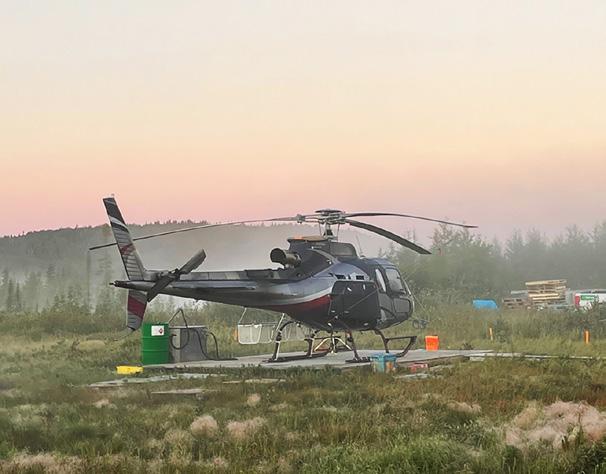
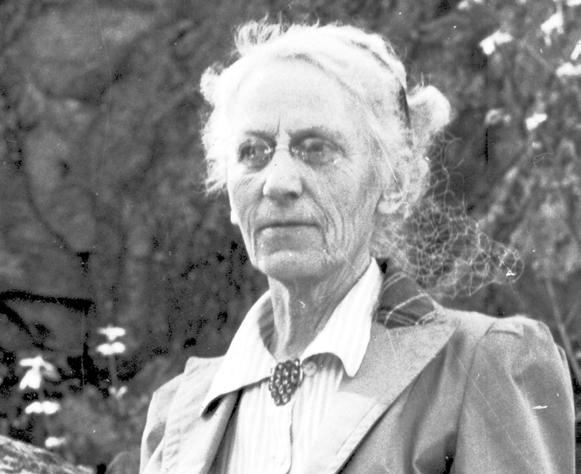
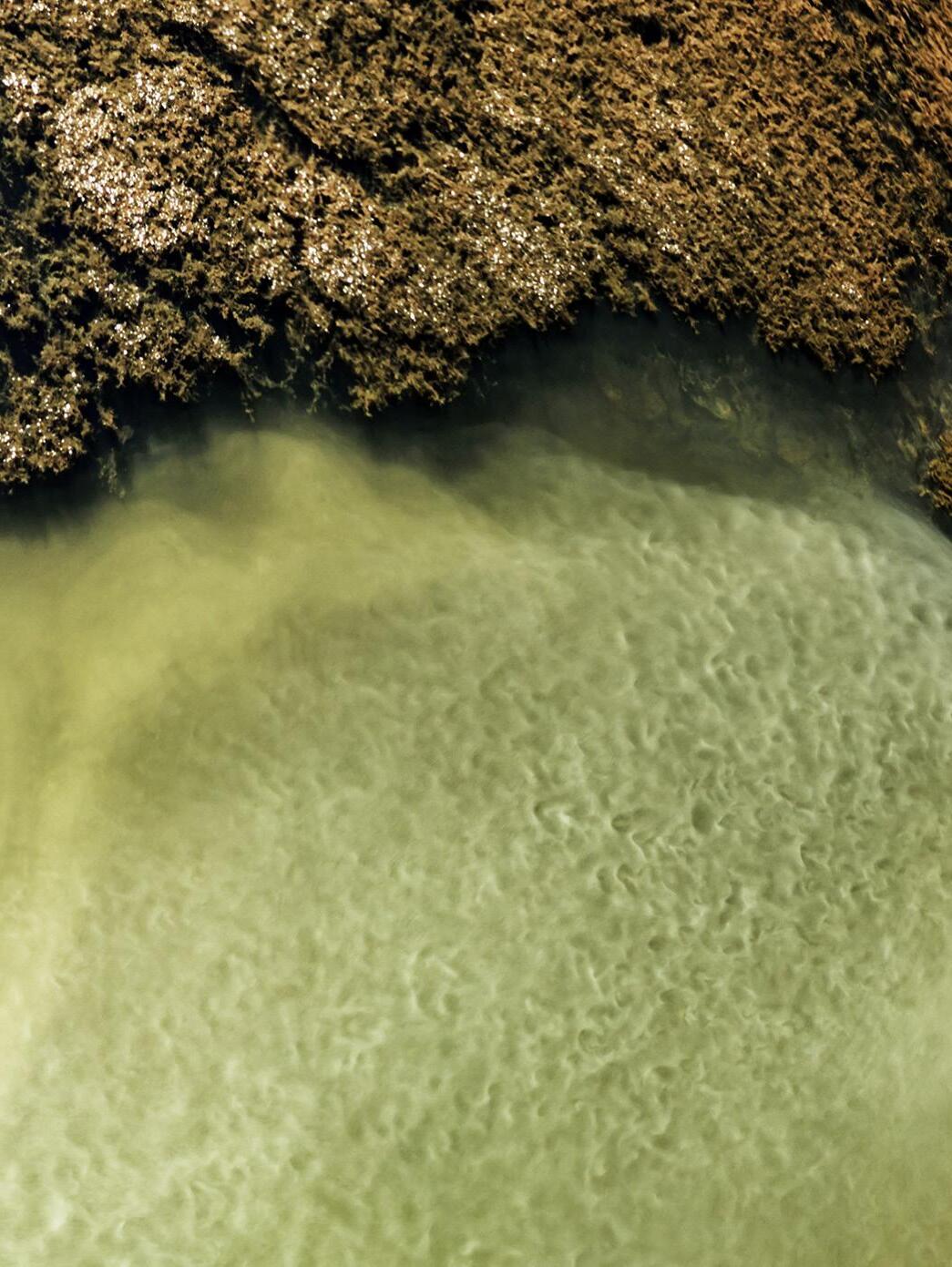
SUMMER 2025
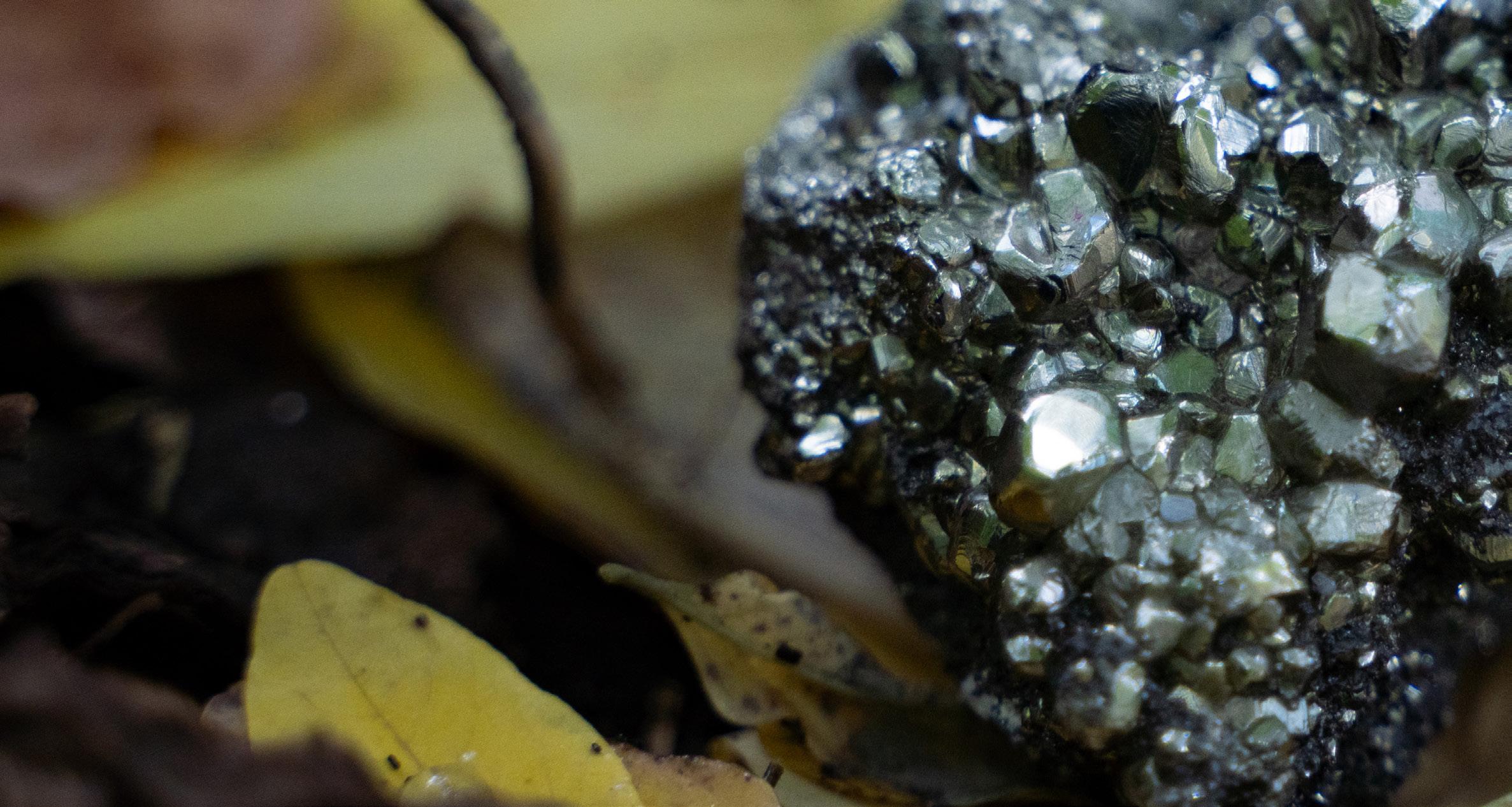
| Proposed Amendments to NI 43-101
On June 12, 2025, the Canadian Securities Administrators (CSA) published proposed amendments to National Instrument 43-101 (NI 43-101) Standard of Disclosure for Mineral Projects. The proposed changes introduce elements that could have detrimental effects for the Canadian mineral industry, such as the removal of the term “material” and replacing it with “relevant,” and applying disclosure requirements to nonmaterial projects. Another concern is that structuring the Disclosure so that Qualified Person (QP) status can only be obtained five years after registration as a professional geologist or engineer is a change that is expected to significantly limit the pool of available QPs in Canada. Additionally, significantly expanding the scope of required data verification, and increased prescriptiveness around disclosure of mineral resource estimates, is expected to add cost and complexity.
In PDAC’s view, these changes alter the intent of NI 43-101 and will neither enhance the competitiveness of Canada’s financial markets nor provide improved investor protection or alignment with key international mining disclosure standards. Visit pdac. ca/access-to-capital regularly, where the association will provide comments to the CSA on the proposed amendments to convey our concerns on behalf of our members.
A British Columbia Supreme Court ruling may significantly impact the Canadian Exploration Expense (CEE) rules under the flow-through share regime. The case involved an initial denial of tax credits to an issuer for noncompliance with CEE rules. However, a judge recently ruled that expenses contributing to assessing a mineral resource’s economic viability fall under the definition of “quality” within the CEE purpose test, and are therefore eligible. This includes factors such as operational and capital costs, grade, accessibility, chemical composition and environmental risks.
Although the ruling relates to provincial credits, it is administered by Canada Revenue Agency (CRA), and the interpretation is expected to have implications for federal CEE rules. PDAC will be engaging with the government to clarify the ruling’s implications for mineral explorers and developers in Canada.
Despite a two-year extension announced in early March, the Mineral Exploration Tax Credit (METC) technically expired on April 1, 2025, due to the dissolution of Parliament. As of March 19, the CRA confirmed it cannot publicly administer the METC based solely on ministerial announcements. With the establishment of the new government, PDAC is calling on the federal government to immediately put forward legislation to renew the METC for a minimum of two years – through 2027 – in line with its stated commitment.
Going back to 1982, Indigenous communities across Canada called for the creation of a day that would recognize, reflect and celebrate the culture, language, traditions and contributions of Indigenous Peoples. In 1996, "National Aboriginal Day" was declared by Governor General Roméo LeBlanc, which was renamed to "National Indigenous Peoples Day" on June 21, 2017 by then-Prime Minister Justin Trudeau in a statement that included, "No relationship is more important to Canada than the relationship with Indigenous Peoples."
June is also National Indigenous History Month, though PDAC’s Indigenous Affairs Program works all year to support the development of positive relationships between communities and mineral exploration and mining companies. This includes dedicated advocacy work to promote increased participation by Indigenous Peoples in the economic opportunities generated by our industry, plus special programming at the association's annual convention and more.
This issue of CORE magazine features an article on the first ever Indigenous Youth and Early Career Ambassador Program, and the unveiling of an original illustration that PDAC commissioned from an Indigenous artist to accompany the association's land acknowledgment statements. To read more about how PDAC supports Indigenous participation in the Canadian mineral exploration and mining development sector, visit pdac.ca/programs-and-advocacy/indigenous-affairs
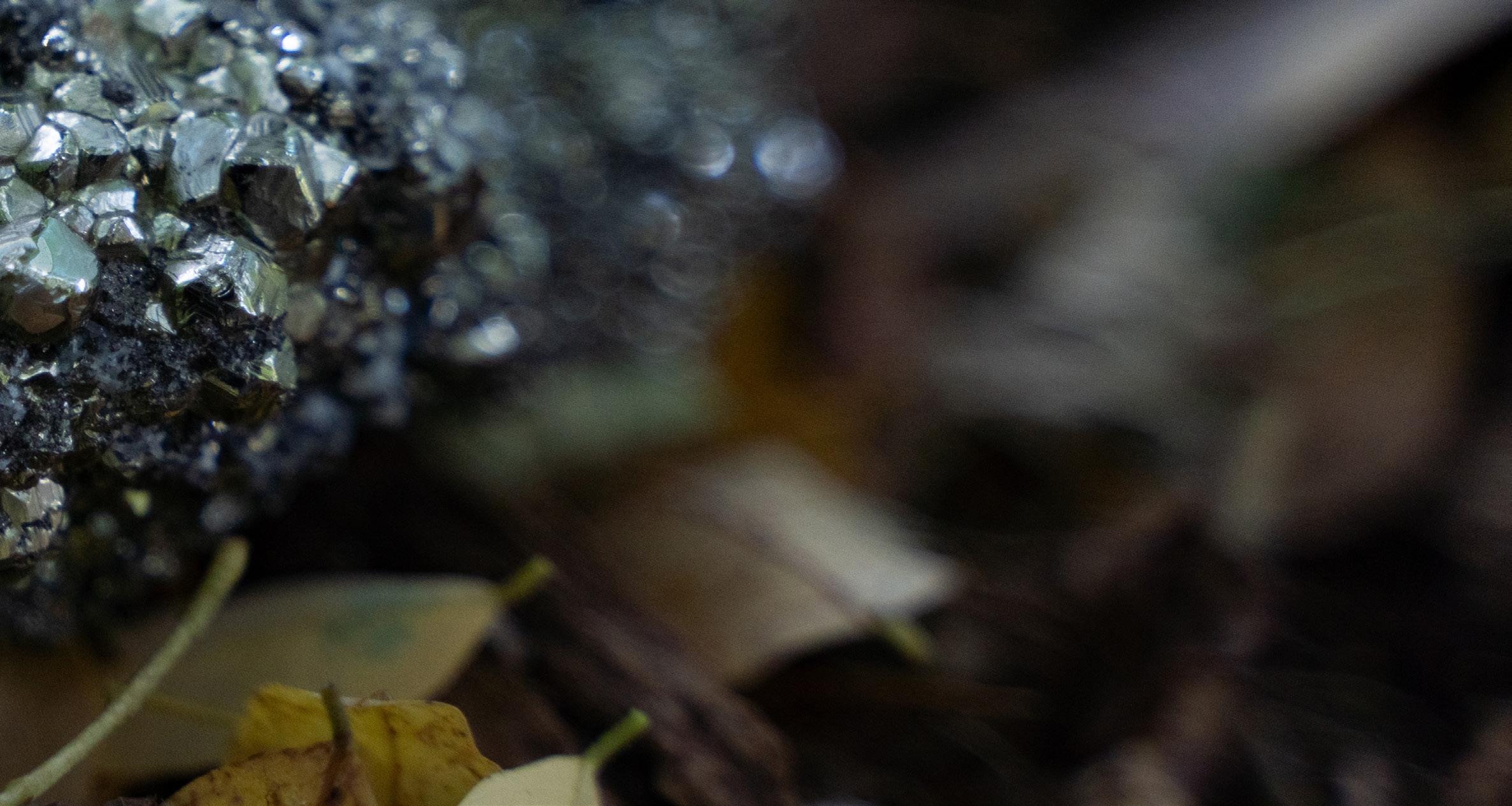
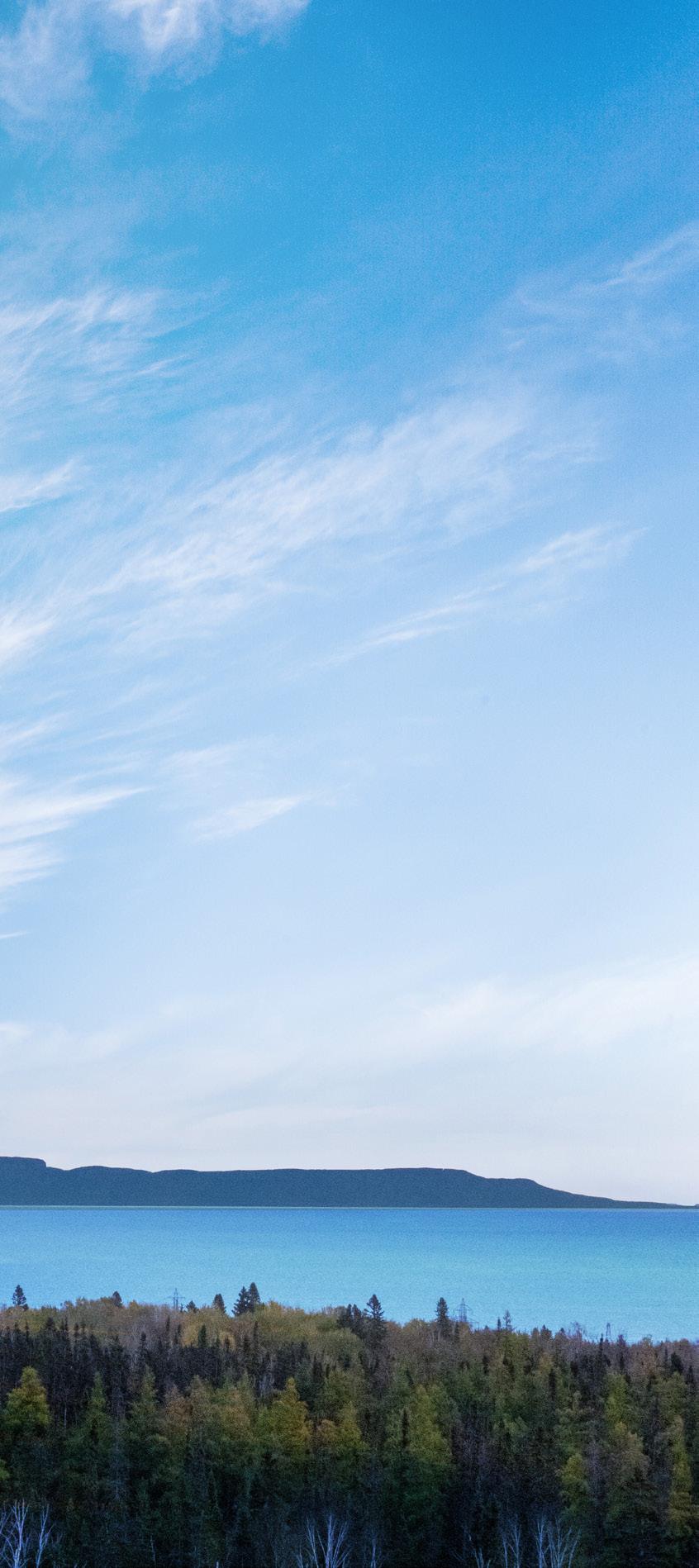
Networking, whether in symposium halls or at social events, is not just about sharing information; it is critical to mentoring the next generation, sustaining our sector, and building new relationships that will drive our industry forward.
- Karen Rees PDAC President
Networking is vital for fostering collaboration and knowledge-sharing for all stakeholders within the minerals industry. As the sector evolves, connecting is also essential for navigating challenges and seizing new opportunities. Industry events, conferences, and informal gatherings serve as invaluable platforms for individuals to exchange ideas, discuss trends, and forge relationships that can lead to innovative solutions and partnerships.
Once again, PDAC proudly exhibited at this year's Ontario Prospectors Association Symposium (OPAS) in Thunder Bay, Ont., reaffirming our commitment to connect with mineral industry professionals from Northwestern Ontario. By promoting active participation in networking events, PDAC ensures that its members stay informed and engaged, ultimately strengthening the community and nurturing the next generation of leaders in the minerals sector. During OPAS, PDAC hosted a networking event at the Sleeping Giant Brewery on April 15. This gathering brought together over 30 members, providing a unique opportunity to connect with PDAC President Karen Rees – who attended her very first event in this new role. “I lived and worked in the vibrant exploration community of Thunder Bay and northwestern Ontario over 20 years ago. It is invigorating to see the community come together at the OPAS and I am delighted to see many at our PDAC event," Rees remarked.
Looking ahead, PDAC will be welcoming members back at our next event: the annual PDAC Open House in Toronto on September 23. For more information on upcoming member events, visit pdac.ca/members
SUMMER 2025
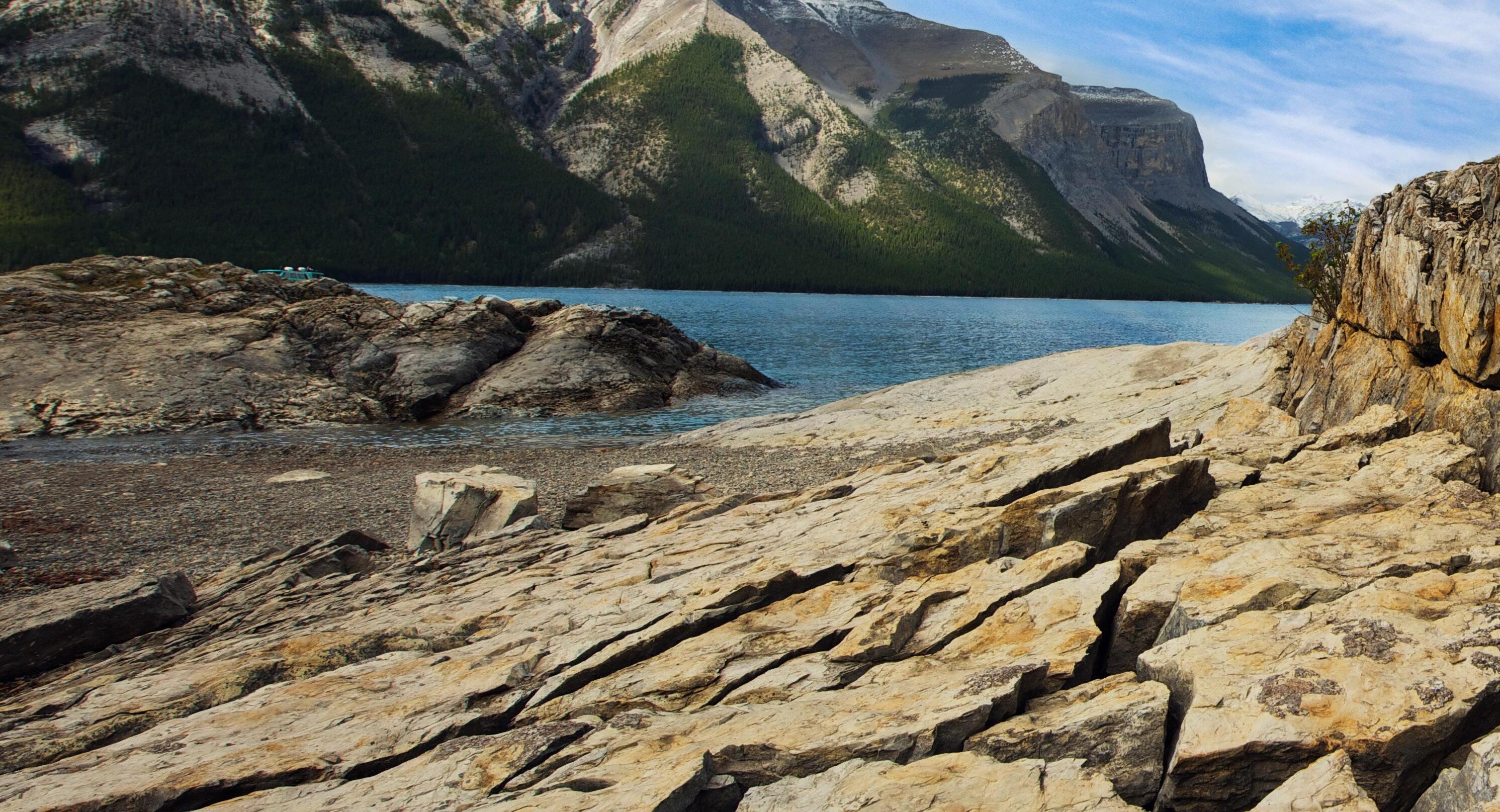
In May, PDAC’s Director, Policy and Programs, Jeff Killeen, was part of a delegation of 40 Canadian business leaders who travelled to Washington, D.C. for the Canadian Chamber of Commerce’s third U.S. Critical Minerals Mission. The purpose of the mission is to create an ongoing dialogue between major Canadian and U.S. entities about our mutual priorities related to critical minerals, and advocate for North Americans becoming reliable partners in energy, prosperity and security. This trip – and its ultimate mission – was especially timely, given the new U.S. administration's current focus on critical minerals and national security.
The group of key Canadian industry stakeholders held discussions with high profile U.S. government and private organizations, including the White House, the U.S. Chamber of Commerce, the State Department, Congressional and Senate office members, the National Defense Industrial Association, the Center for Strategic and International Studies, the Departments of Energy and Defense and more.
With this goal in mind, Killeen – who went to Washington on behalf of PDAC and the association's more than 8,200 members – said of the trip, “I used this opportunity to flag that issues extend beyond mining, processing and valueadded activities downstream, and how mineral exploration and investment at the beginning of our industry’s ecosystem are vital for both the U.S. and Canadian governments."
Held every year on June 15, International Day of Women in Mining – first launched by Women in Mining (IWiM) in 2022 – celebrates the important role of women in the mineral exploration and mining sector. PDAC is a regular campaign supporter of IWiM, whose organization includes current and past members of our association.
IWiM hosted a global live event for International Day of Women in Mining 2025 on June 17, which included interactive activities, guest speakers from the industry, keynote addresses, exclusive videos and more. This annual campaign encourages the mining community to acknowledge the contributions of women in the industry by providing an international venue to "connect, celebrate, and reflect on the impact of women in mining worldwide."
As the leading voice of the mineral exploration and development community, PDAC is proud to incorporate diversity, equality and inclusion into our values, and we support programs that advocate for positive change in the industry.
To learn more about IWiM, its initiatives and annual events, visit internationalwim.org .
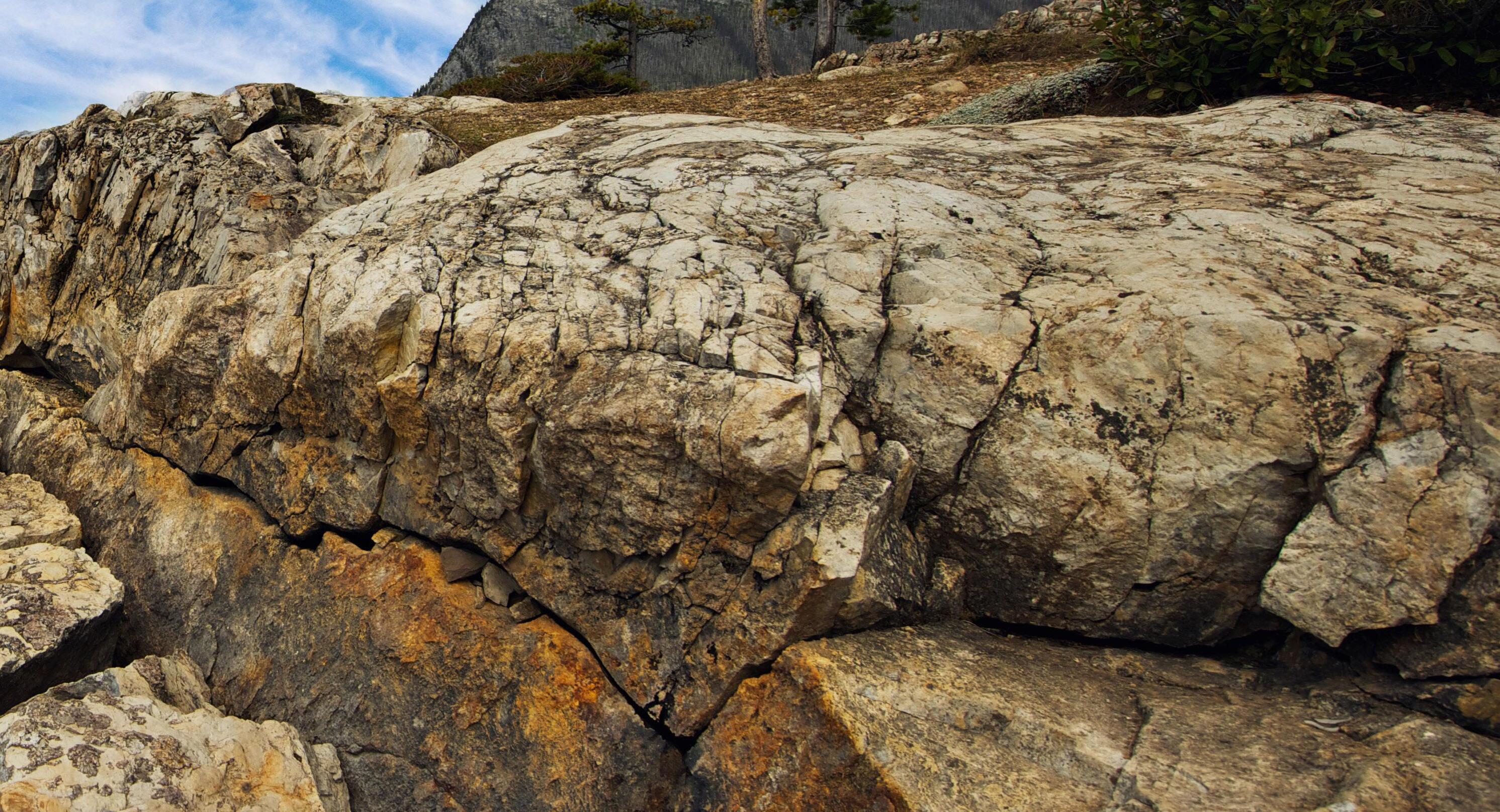
PDAC was honoured by PRNEWS with a 2025 Nonprofit Award for our Annual Report. Published in the spring of 2023, the 2022 Annual Report received the top award for “Annual Publication or Brochure” in the Communications & Campaigns category. The 2022 Annual Report represented a new direction in our yearly reporting, and was the first published by PDAC that featured all-original content directly related to the activities of the association, reports on our progress in key areas of advocacy and responsibility, committee goals and accomplishments, EDI summaries and a new design with visual accessibility given priority.
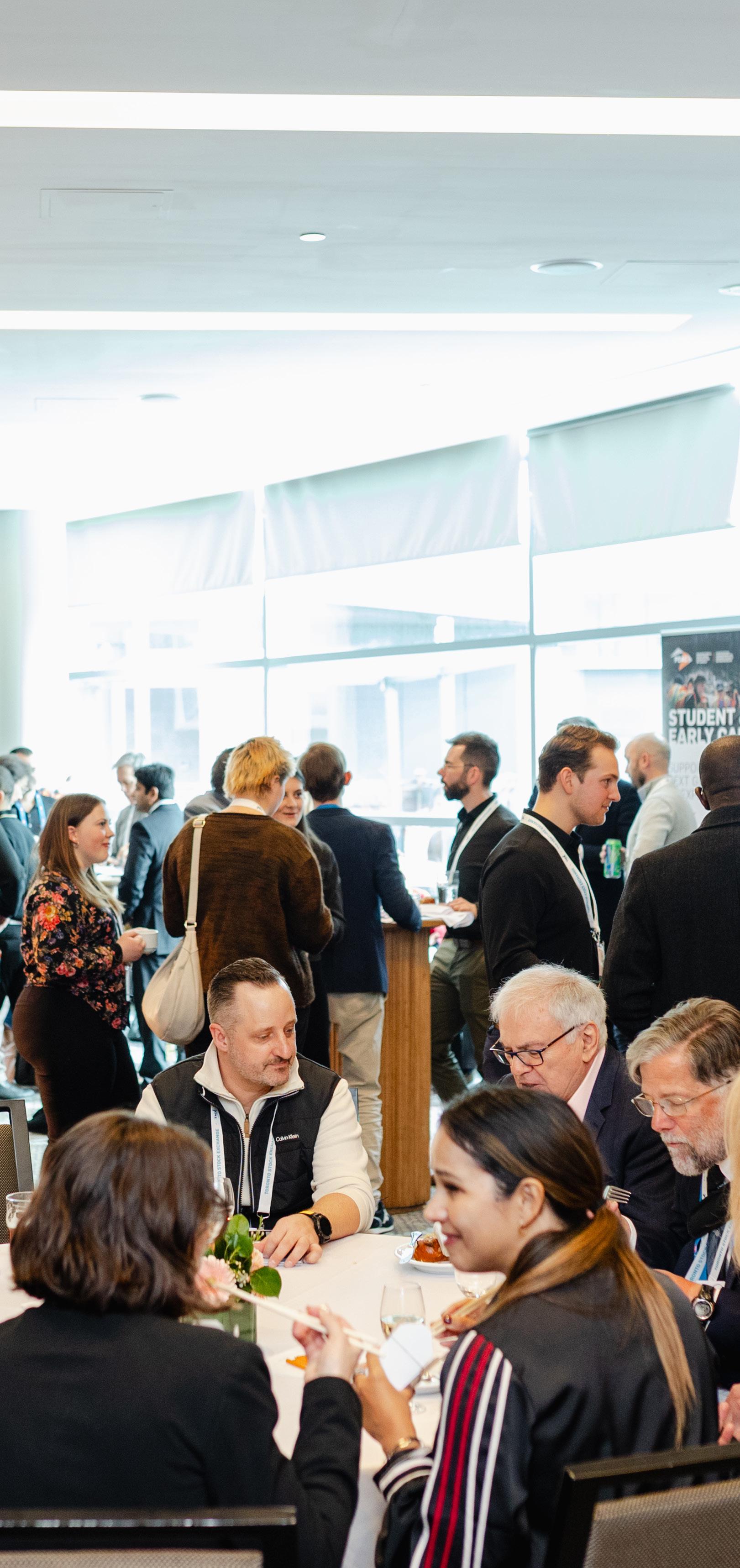
PRNEWS's Nonprofit Awards are open to organizations across the world including associations, government organizations, universities, agencies and more. Kaylee Hultgren, Content Director at PRNEWS, had this to say about the awards, "Our Nonprofit Award winners spotlight the critical impact that communications has on myriad issues facing the world today. From successful advocacy and fundraising campaigns to work that creates more inclusive opportunities for underrepresented groups their demonstrable success...deserves to be celebrated."
On behalf of the association and our 8,000+ members, we greatly thank PRNEWS for this 2025 Nonprofit award, and congratulate everyone involved!
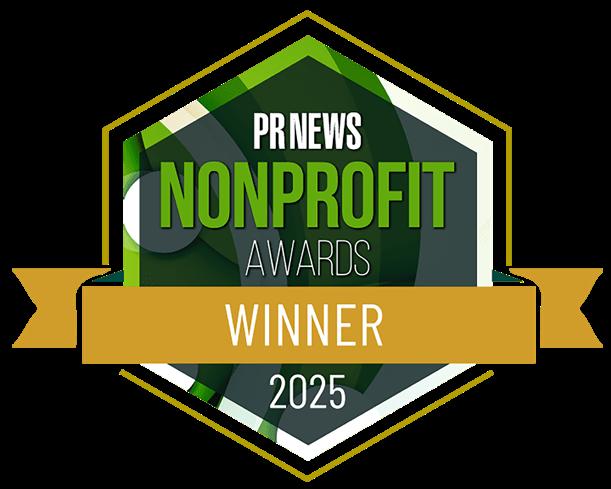
For the third consecutive year, our Membership Referral Program has achieved record success, thanks to the support of over 270 members from 28 countries. This initiative has welcomed more than 490 new members, bringing our total to over 8,200 individual and corporate members for 2025. “As we grow, our collective voice becomes stronger in advocating for the mineral exploration and development industry,” commented Lisa McDonald, Executive Director.
This year, PDAC was pleased to announce the inaugural first-place recipient, Cindy Vasquez from Peru, who won a complimentary booth at PDAC 2026. "Thank you for this extraordinary honour! We are thrilled to be the first ever firstplace winners of this incredible initiative," Vasquez shared. Wayne Floreani from Mine Africa took home the second grand prize of golf passes to the RBC Canadian Open, while Isabela Storni from Brasil Pavilion claimed the third prize – an iPhone 16. For a complete list of grand prize recipients and monthly winners, visit pdac.ca/members/referral-program
The next Member Referral Program challenge will kick off October 1, 2025, featuring exciting updates to the Leaderboard and new prizes across various categories. We invite all members, especially our new ones, to participate by logging in to the Members Portal and access the ‘referral dashboard’ in October. A heartfelt thank you to all participants this year – your involvement is vital to the continued growth of our association.
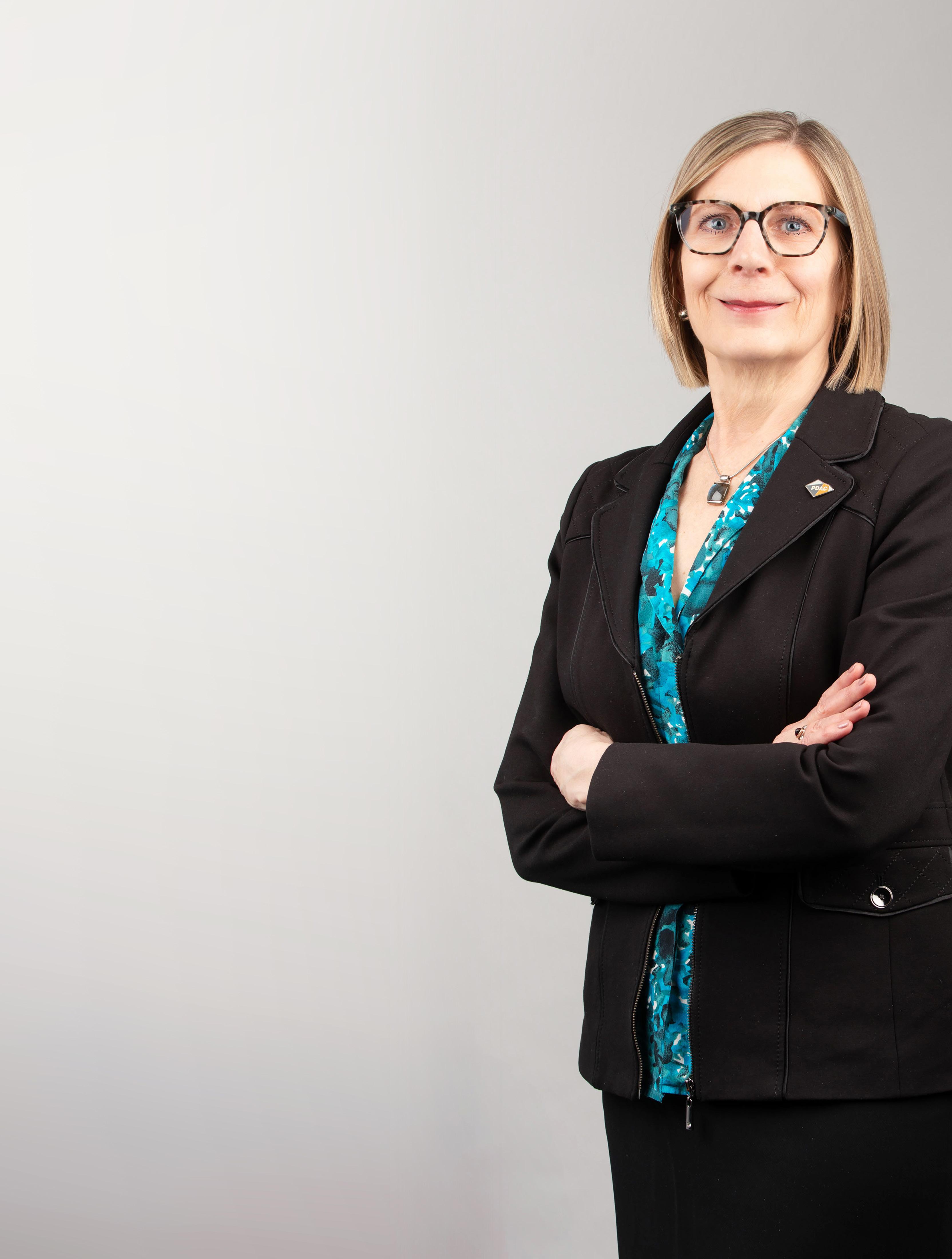
PDAC President Karen
Rees began her two-year term on March 5, 2025. In this interview, she shares insights from her decades of experience in the mineral exploration industry and offers her perspective on the future of the sector in Canada.
With 37 years in the mineral exploration industry, Karen began her geoscience career as a field and project geologist in northwestern Ontario, northern Manitoba and Saskatchewan. As her career progressed, she became a manager of teams exploring multi-commodity projects across northwestern and northeastern Ontario.
Karen serves on the boards of three junior exploration companies with mineral properties in Ontario, Québec and Manitoba. An enthusiastic proponent of the minerals sector, she began volunteering with PDAC in 2011. Elected to the board in 2018, Karen continues to be an active member of PDAC committees including Executive, Human Resource Development, and the StudentIndustry Mineral Exploration Workshop (S-IMEW) – a flagship program of PDAC that celebrated its 15th anniversary in 2024. Prior to being appointed president, Karen also served on the Governance and Nominating Committee.
What was it about mineral exploration and the mining development sector that sparked your interest, and made you want to pursue a career in this industry?
As a high school student, I was not really aware of the minerals sector. However, with strengths in science and math, I selected three programs (biology, math and geology) to visit at the University of Saskatchewan. I got value from learning about all of the programs but the presentation given by the geology prof was captivating and the interest in a career in geoscience was ignited!
You have been active in the industry for nearly four decades as a geologist, a communications practitioner, exploration manager, vice-president of exploration, corporate secretary, independent consultant, and exploration company board member. But what was your very first job within the industry?
My first job in the industry was as a field geologist in Red Lake, Ontario. It was a fantastic experience, working in a beautiful location, under the supervision of an experienced geologist to gain practical field skills in prospecting, geological mapping, sampling, running a diamond drill program and logging core. Our office work included compilation and interpretation of data, preparation of maps and reports. This was 1987 and all of our work was done by hand.
While my first jobs helped to establish an excellent geoscience foundation, over the years I was afforded opportunities to work with management to coordinate teams, build project portfolios, and to learn the financial and corporate aspects of the business. From there I grew a very strong interest in best practices in communications, public disclosure and governance, and that ultimately led to my director positions on exploration company boards and PDAC.
You have been PDAC’s First Vice President and enthusiastically involved with PDAC committees, including the Human Resource Development (HRD) and Awards committees, and our Student-Industry Mineral Exploration Workshop (S-IMEW). What do you see/what would you like to see for the future of our sector and the next generation of explorationists?
I began volunteering with PDAC in 2011 with HRD and a few years later with S-IMEW, and much has changed over that time. Students and early-career professionals have witnessed the cyclical nature of our business, as I did when first starting out. We learn to add other skills to our tool kit and perhaps pivot to adjacent or peripheral industries.
One of PDAC’s key priorities in our Strategic Plan is to ensure that the Canadian mineral exploration
and development industry actively develops an inclusive, diverse and skilled workforce. The programs operated under the Student & Early Career program support these objectives. The students who participate in the flagship S-IMEW program, Convention programs, and other outreach events, have expressed their gratitude for the opportunity to be exposed to the various facets of the mineral exploration industry. I see our role as a critical one to encourage and prepare our future leaders – they are key to a competitive Canadian mineral exploration and development industry that operates responsibly in Canada and around the world.
PDAC’s presidency is a two-year term. What changes or advancements do you hope to see in the industry by 2027 – technological, government support, investment, education, etc?
Change happens as needs dictate and technological advancements drive more efficient and cost-effective operations.
In exploration, we still need “boots on the ground” to find those mineral showings, conduct the necessary work, over years, to develop a project that has sufficient size, grade, and accessibility to be economically viable. In order for any of those stages to happen, there needs to be strong support and fiscal incentives to encourage investment in the mineral exploration sector.
As projects become advanced, greater clarity and certainty around permitting requirements and timelines is required. We support the reinforcement of a single-process approach to project assessments. Provincial and territorial regulatory regimes must be prioritized in order to develop mineral resource projects in a timely manner.
Education and public information campaigns are also key. They connect the importance of our minerals industry with the hearts and minds of the public, to maintain a strong industry that safeguards Canada’s economic resilience and provides an environment that fosters innovation and growth for generations to come.
What do you feel about the Canadian mineral exploration sector that makes us unique in the global community?
Canada has a vast land mass with robust mineral wealth that is vital to our daily lives. The minerals industry is a cornerstone of Canada’s economy, contributing over $150 billion – or 6 per cent – to Canada’s total GDP. The mineral exploration and mining industry benefits all Canadians, from facilitating regional development and infrastructure, supporting Indigenous communities and partnerships, to providing employment in urban, rural and remote regions.
What makes Canada stand out globally is our strong commitment to responsible and sustainable practices, a stable legal and regulatory environment, and a focus on environmental, social and governance standards.
Do you have a favourite Canadian region that you’ve explored? Is there any region (whether in Canada, or overseas) that you have not explored that you’ve always wanted to?
My industry experience is firmly rooted in Canada across Saskatchewan, Manitoba, Ontario and Québec. The vast majority of my career has been spent on exploration projects in northwestern and northeastern Ontario exploring for a wide variety of commodities. Any other regions that I explore in Canada – and across the globe – will be to experience landscape, architecture, art, history, food and music.
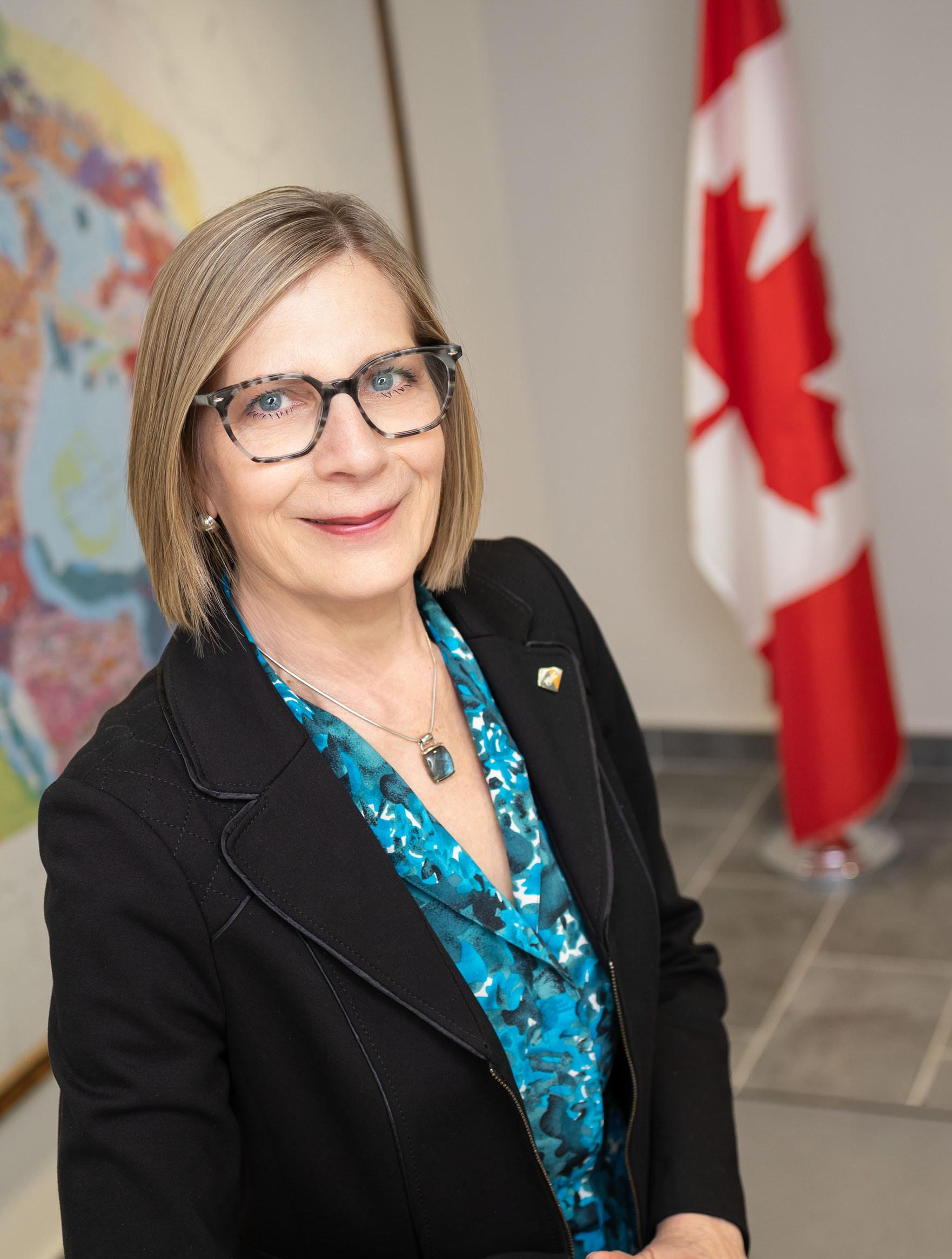
To learn more about Karen and read the PDAC president's blog, visit pdac.ca / presidents-office .
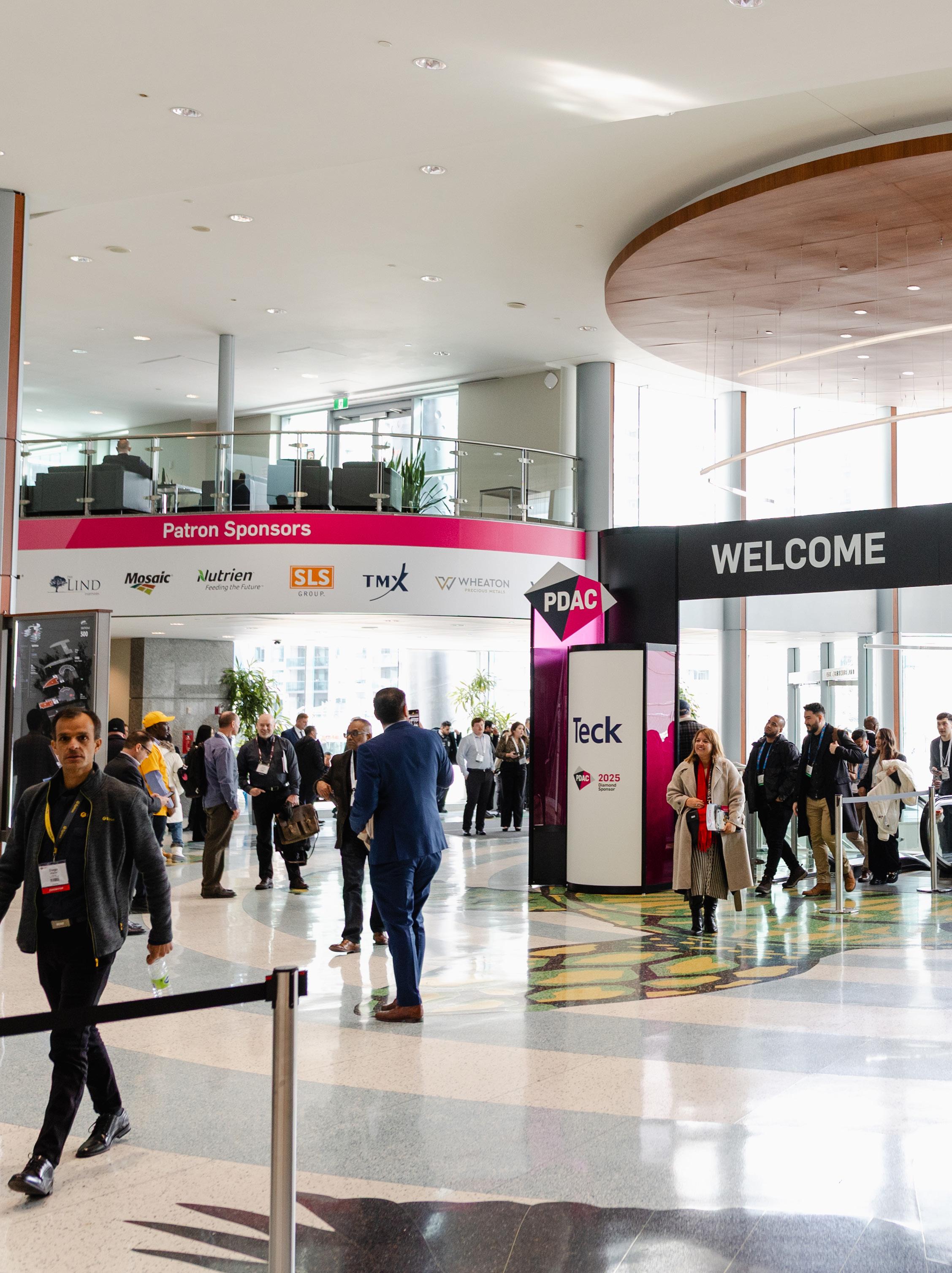
DRAWING 27,353 ATTENDEES AND SPREAD ACROSS BOTH THE NORTH AND SOUTH BUILDINGS OF THE MTCC, PDAC'S ANNUAL CONVENTION UPHELD ITS POSITION AS THE INDUSTRY'S LARGEST & MOST INFLUENTIAL EVENT
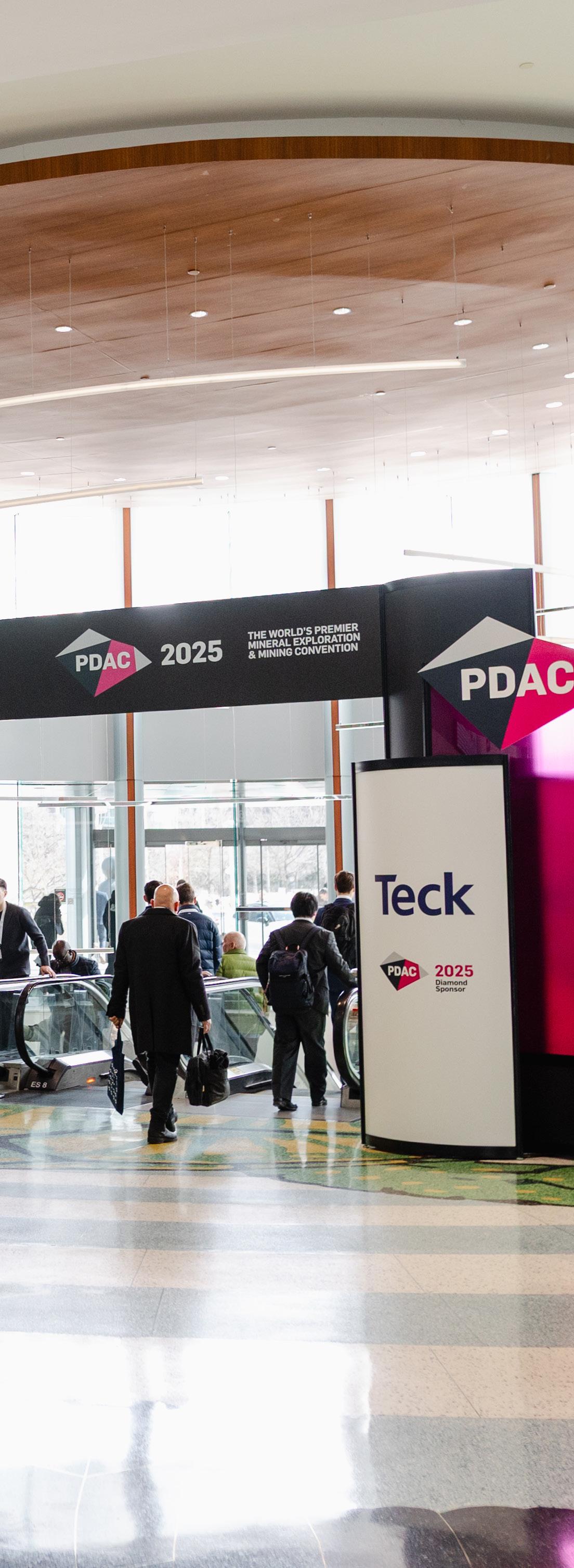
Year after year, the PDAC Convention is the place to be for unveiling the latest market insights, advances in technology, and for fostering essential partnerships.
- Raymond Goldie PDAC Past President
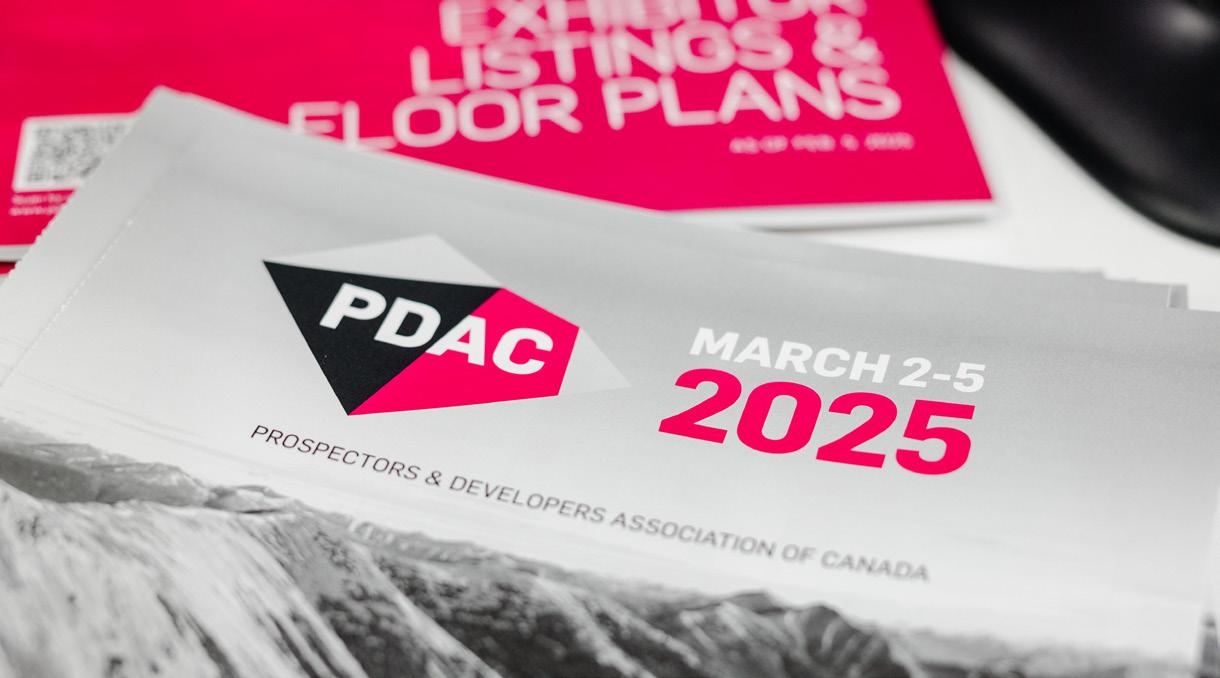
• Showcased more than 1,200 exhibitors – including government representatives, corporate leaders, and technical specialists from across the world.
• Extensive programming covered current topics focusing on capital markets, critical minerals, Indigenous relations, student and early career development, and sustainability.
• Keynote speakers included Mike Henry, BHP; Eric Sprott, Eric Sprott Family Office; Flavia Tata Nardini, Fleet Space Technologies; and David Burt & Bede Evans, the Onto Discovery Team.
• PDAC 2025 provided a vital platform for dialogue between industry stakeholders and government officials. PDAC’s leaders used this forum to emphasize the impact of forward-looking public policy on maintaining Canada’s competitive edge in the mineral sector.
• Five of the industry’s top performers were honoured at the PDAC 2025 Awards Gala at the Fairmont Royal York Hotel.
The following pages are a collection of photos and stats that showcase the energy, programming and people that made PDAC 2025 a success.
27,353 ATTENDEES
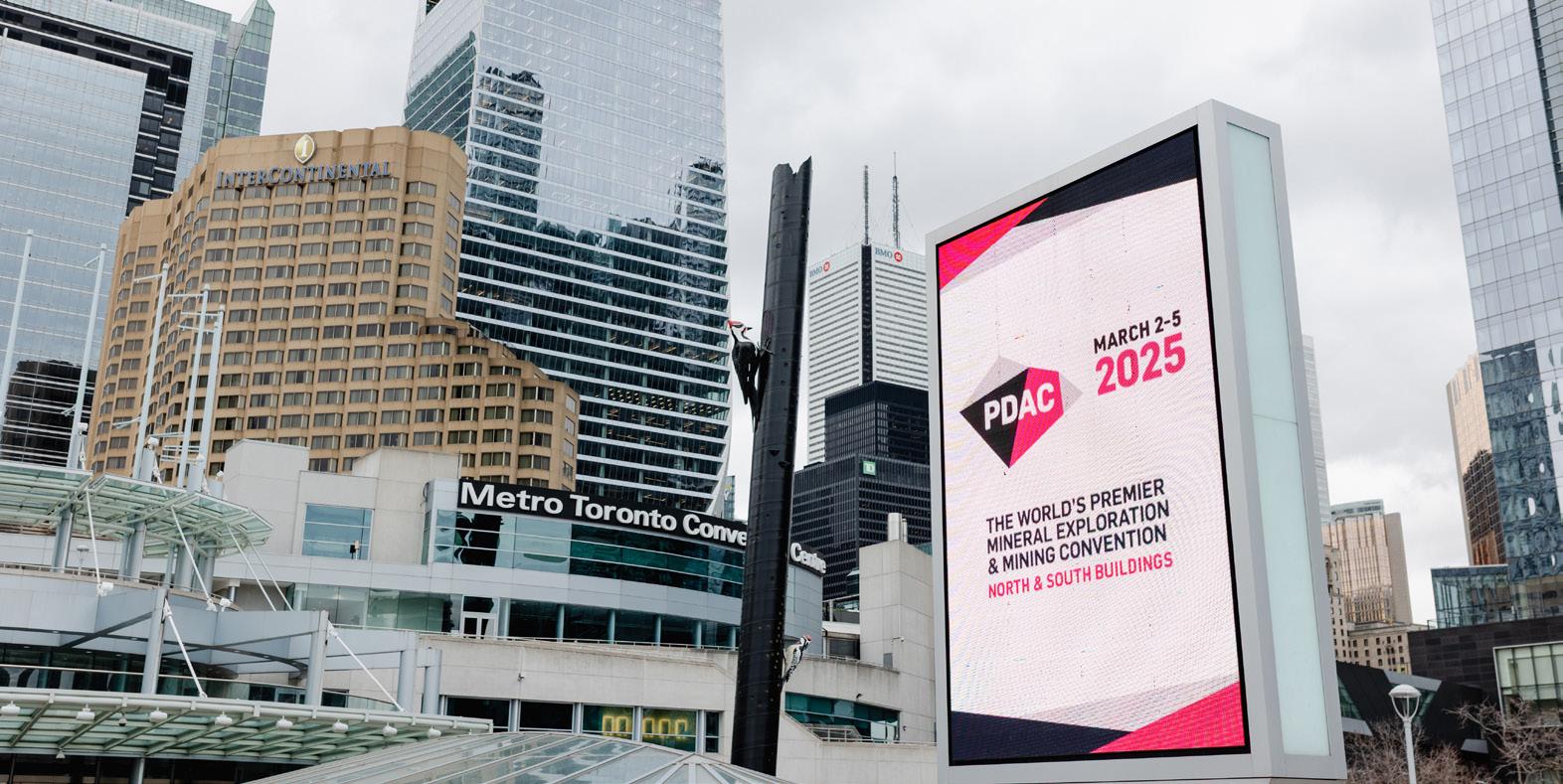

2,524 SELF-IDENTIFIED INVESTORS
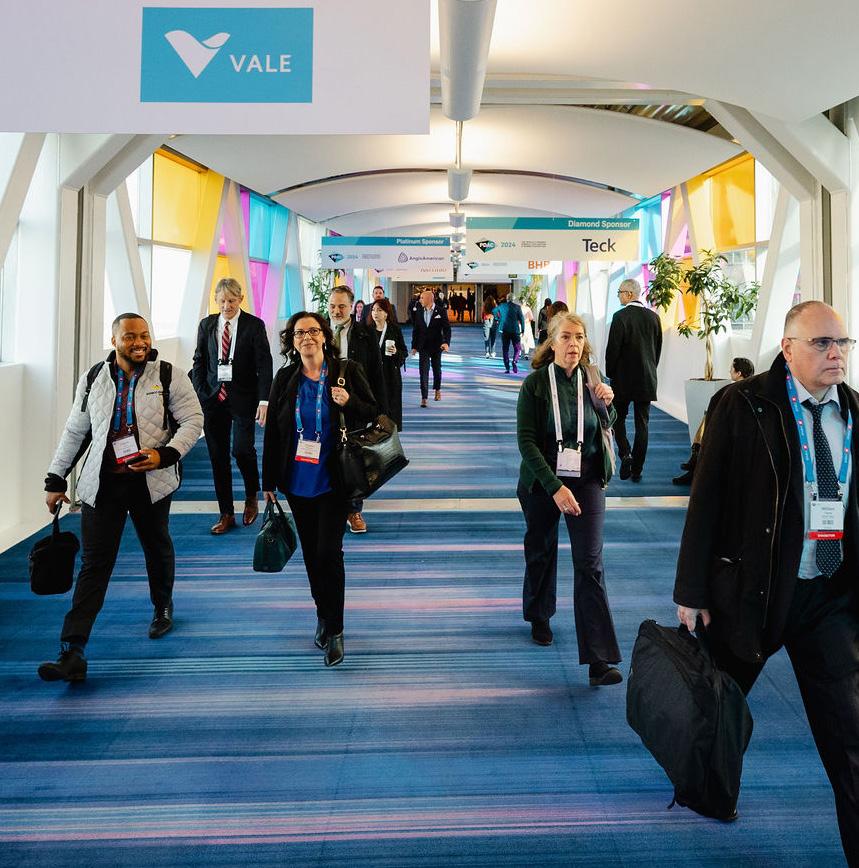
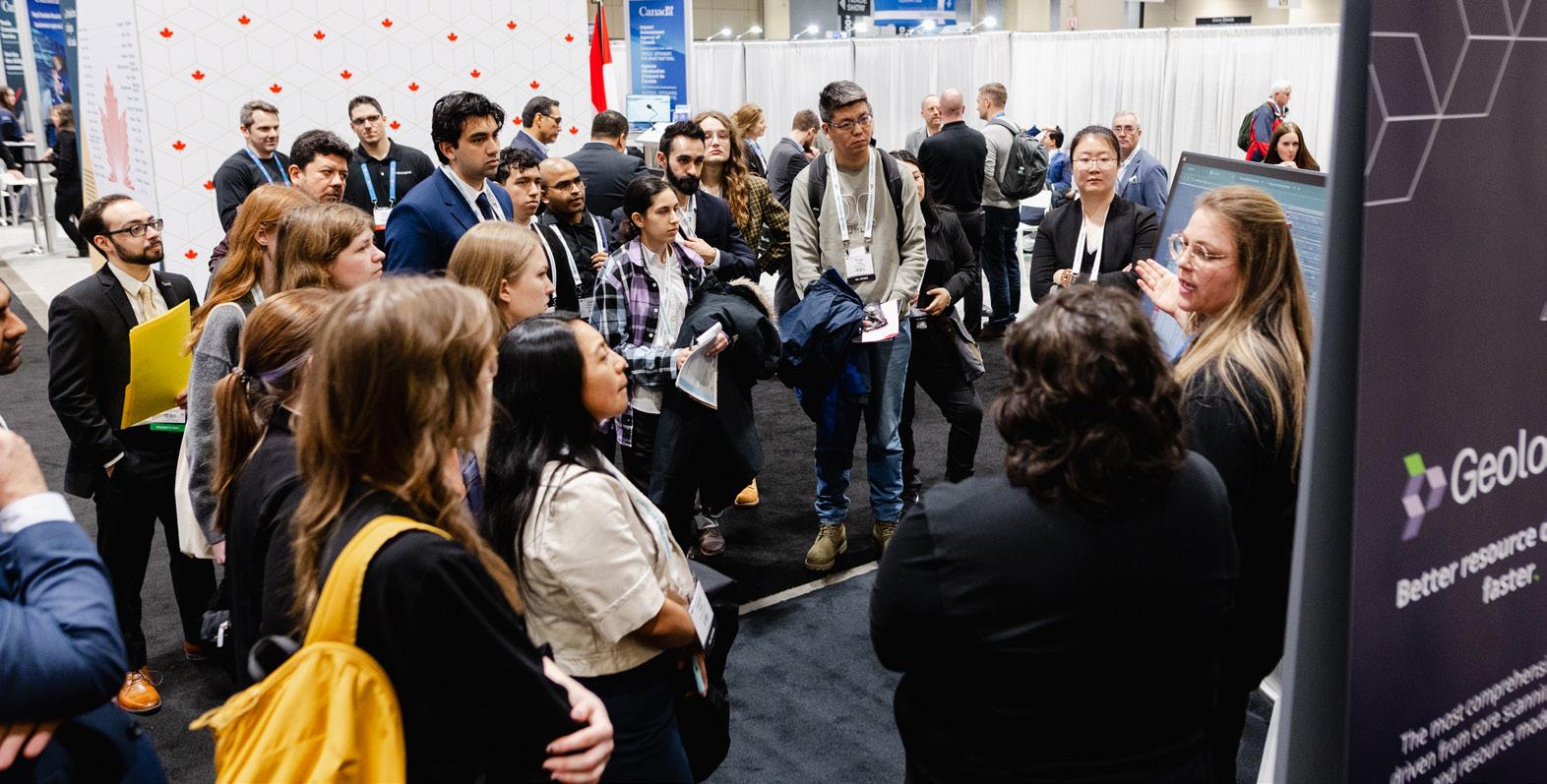
1,313 STUDENT ATTENDEES
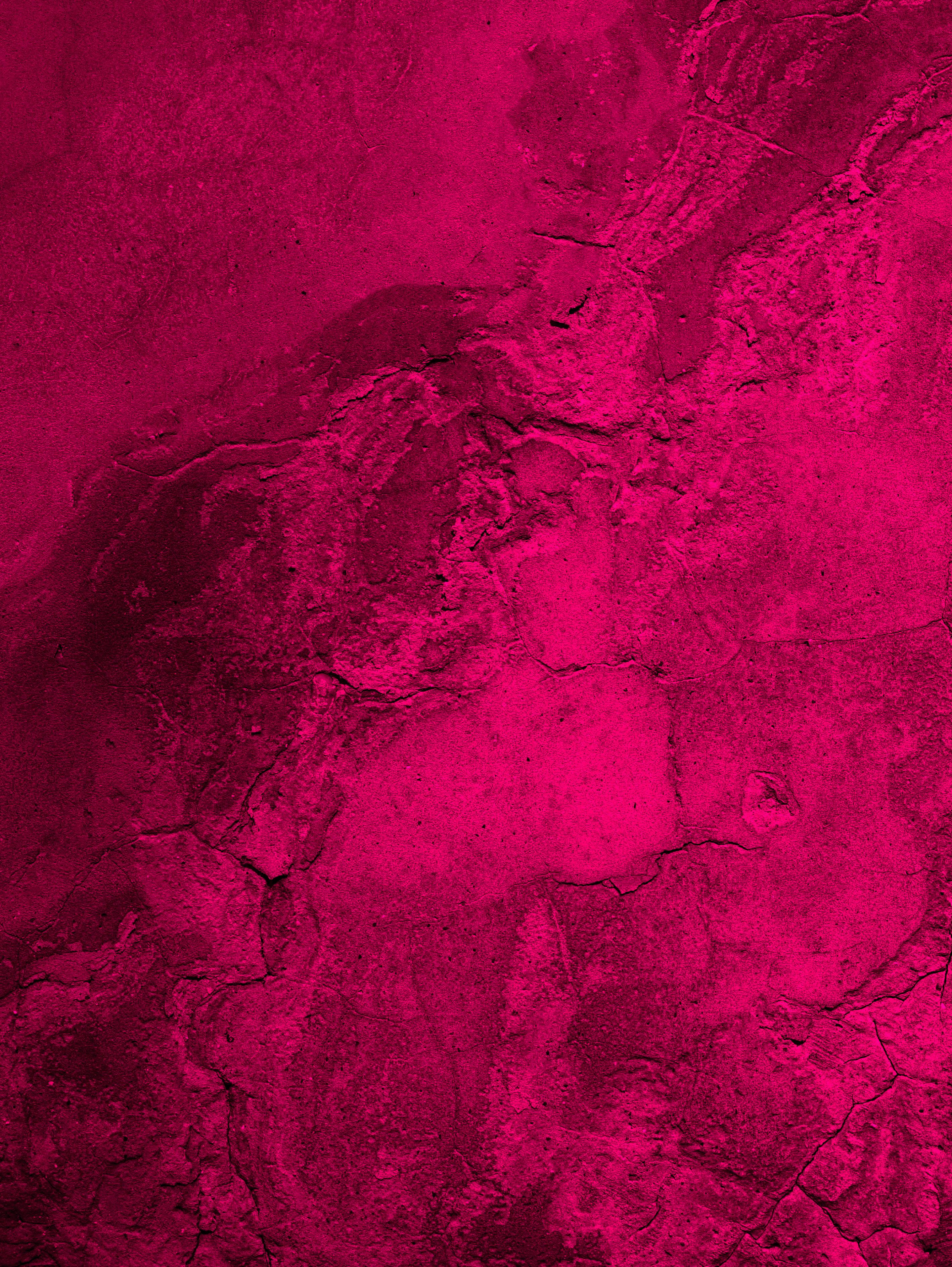
33%
OUTSIDE OF CANADA, THE LARGEST NUMBER OF ATTENDEES CAME FROM:
UNITED STATES
AUSTRALIA
UNITED KINGDOM
ARGENTINA
PERU BRAZIL CHILE
MEXICO
MONGOLIA
TURKEY
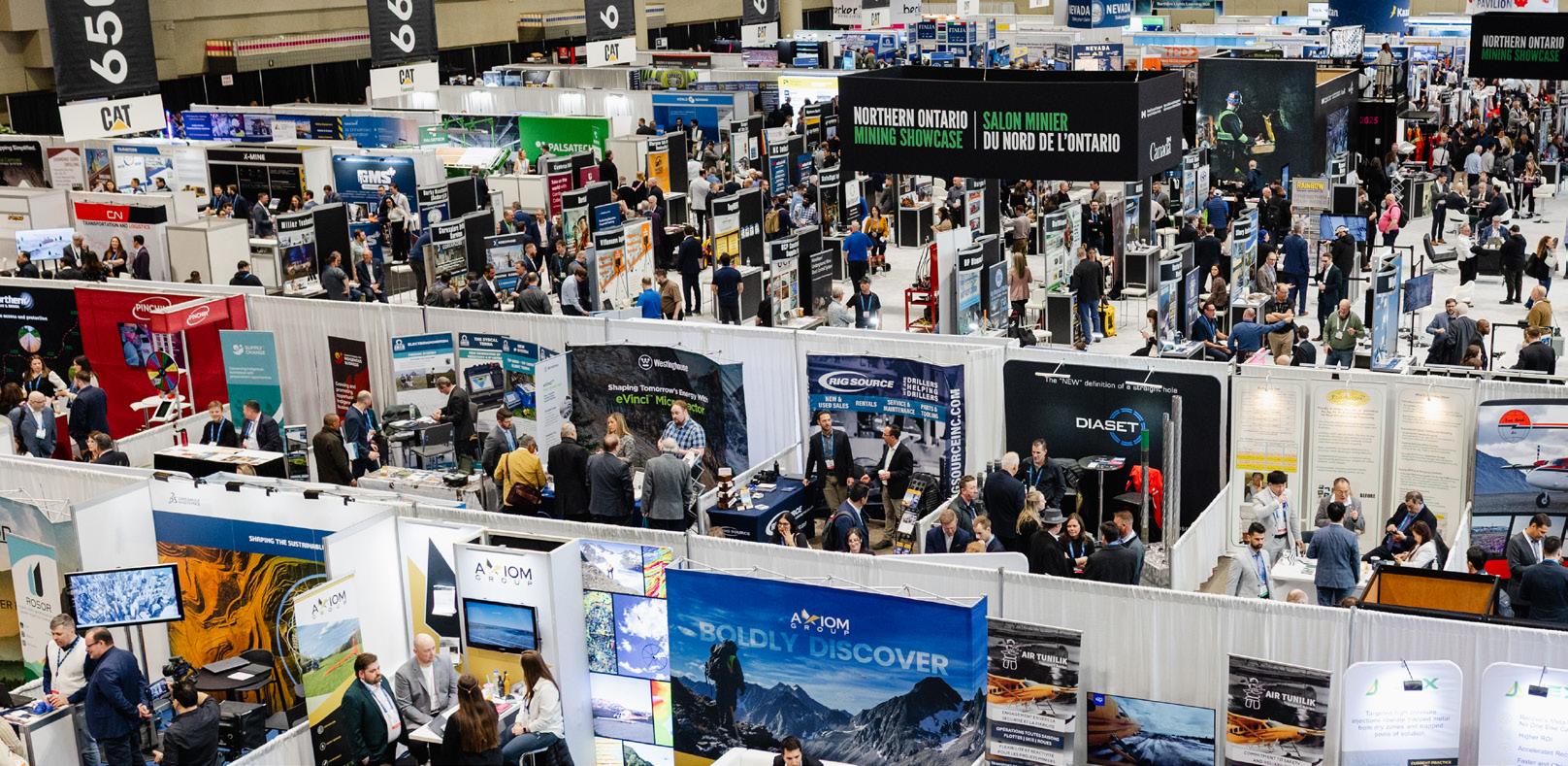
WITH 423 EXHIBITING ORGANIZATIONS
1,024 TRADE SHOW BOOTHS
WITH 745 EXHIBITING ORGANIZATIONS
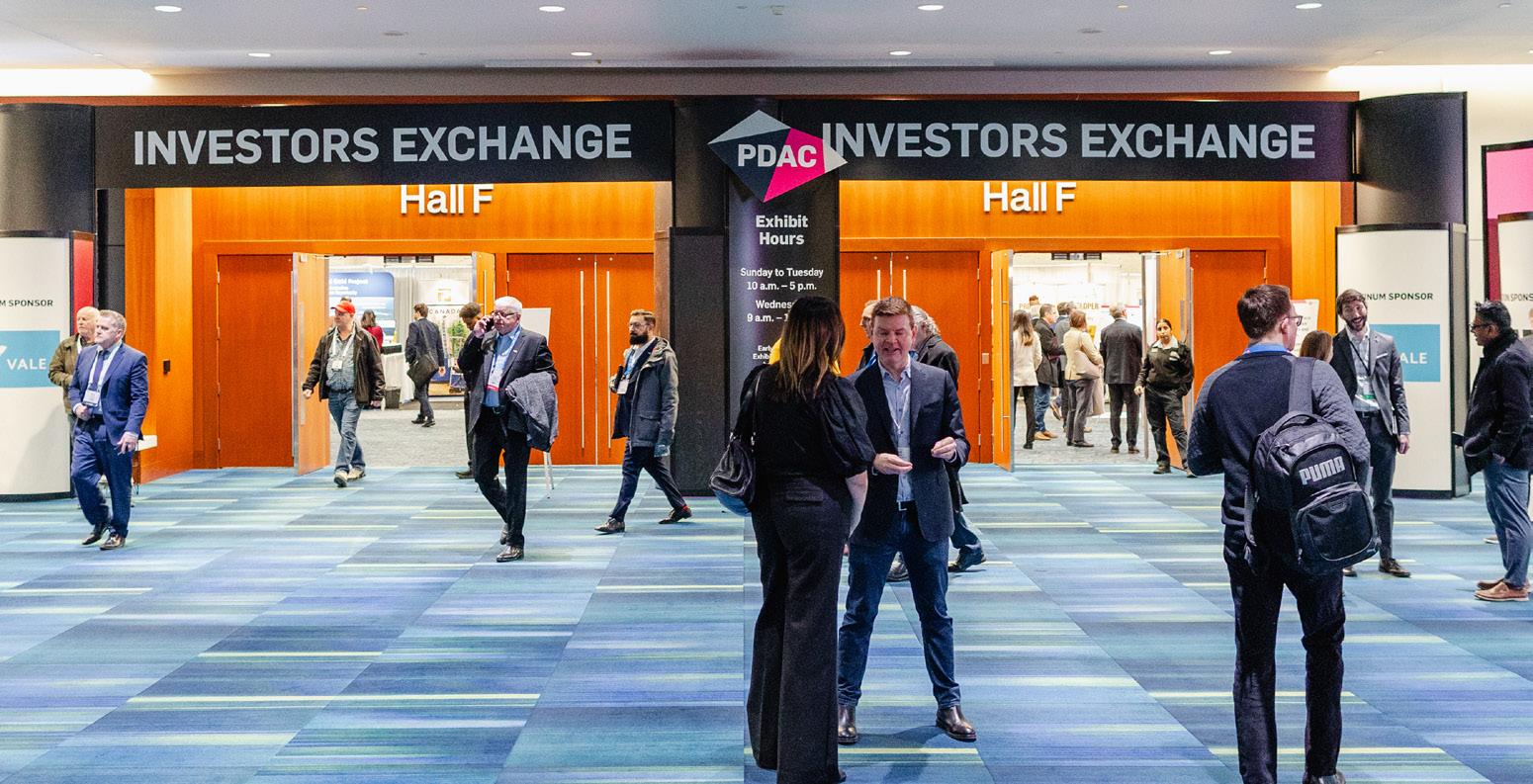
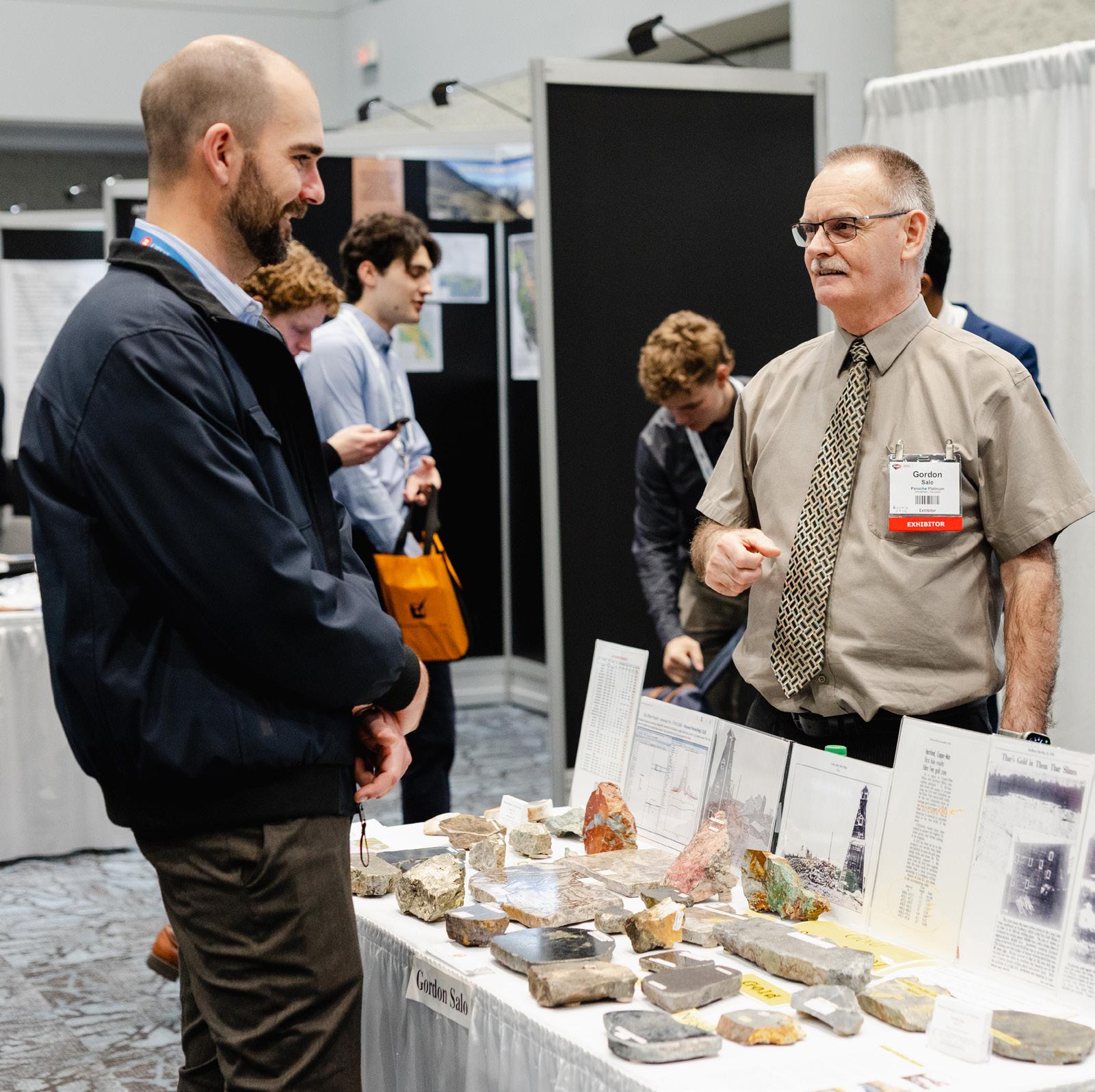
20 PROSPECTORS TENT EXHIBITORS
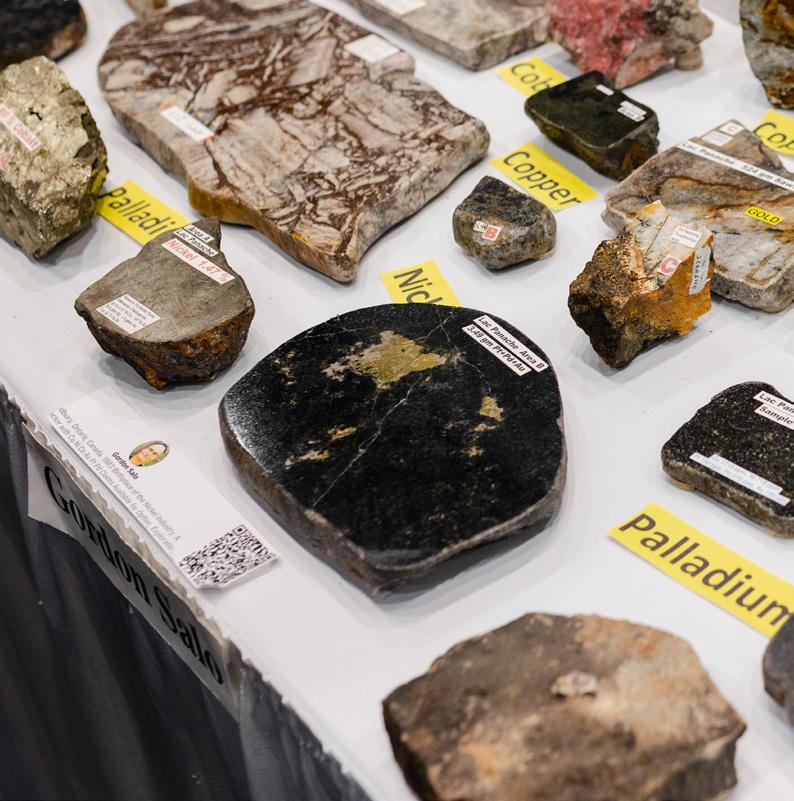
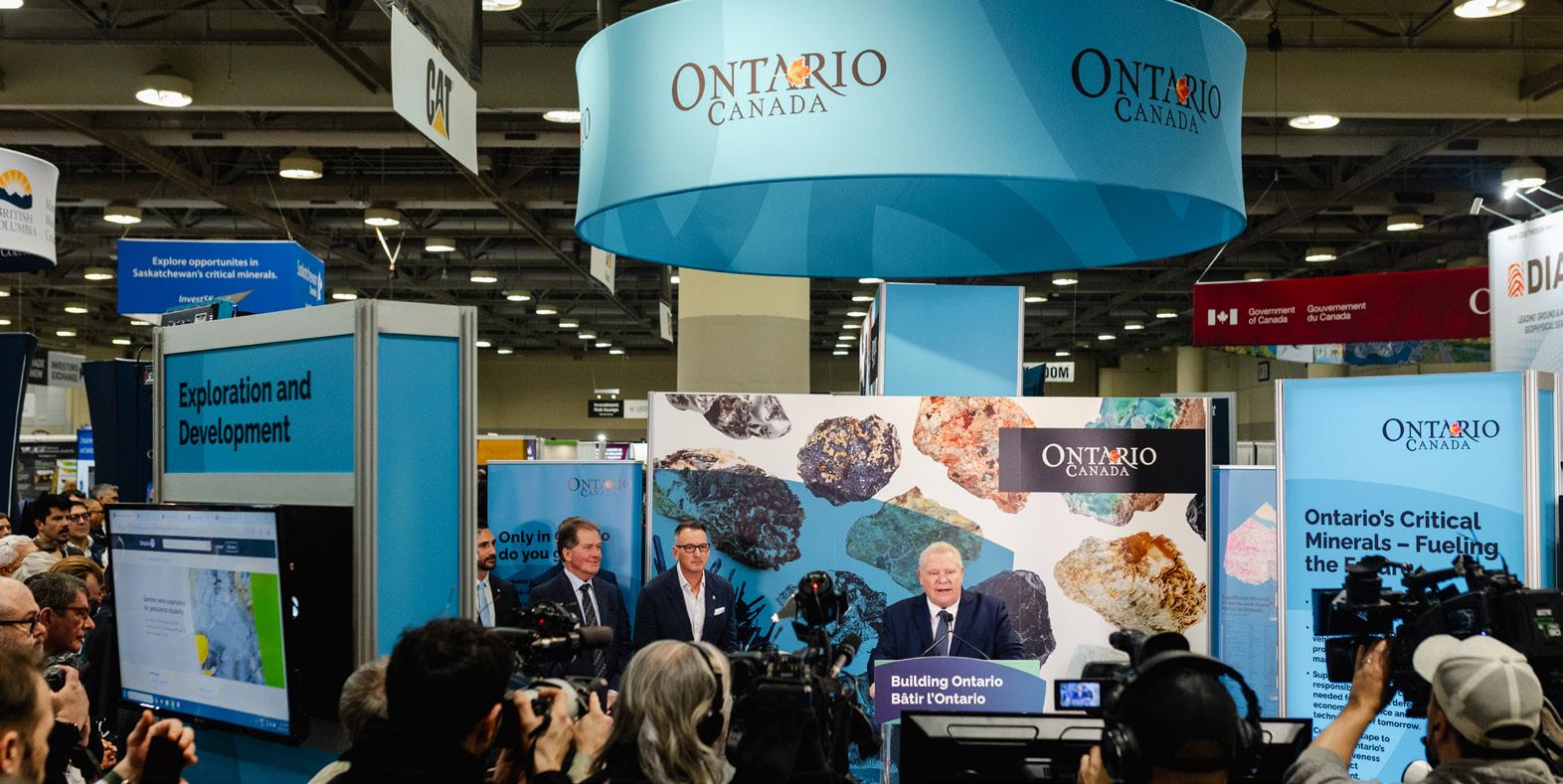
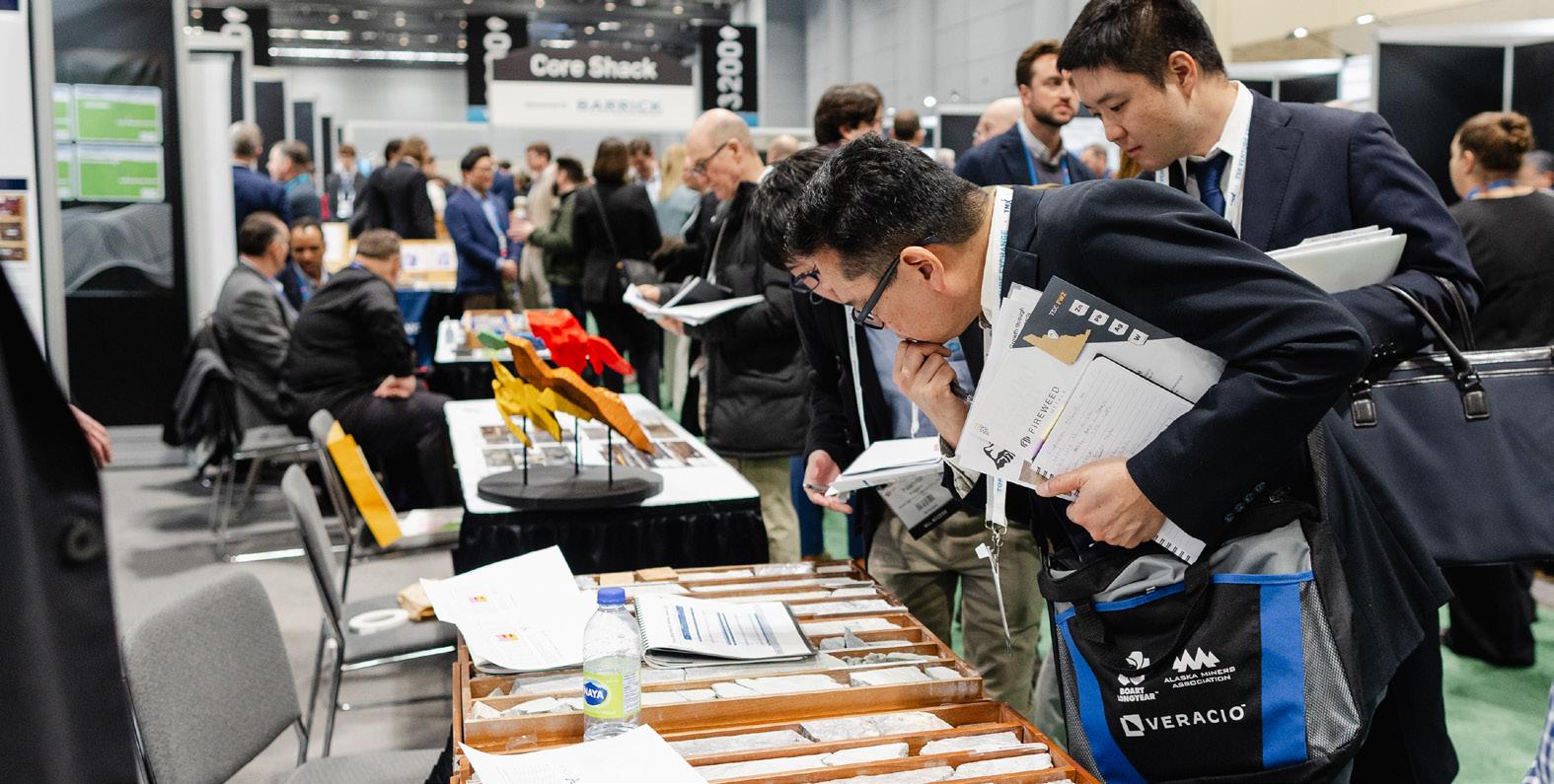
34 SPONSORS
40 CORE SHACK EXHIBITORS

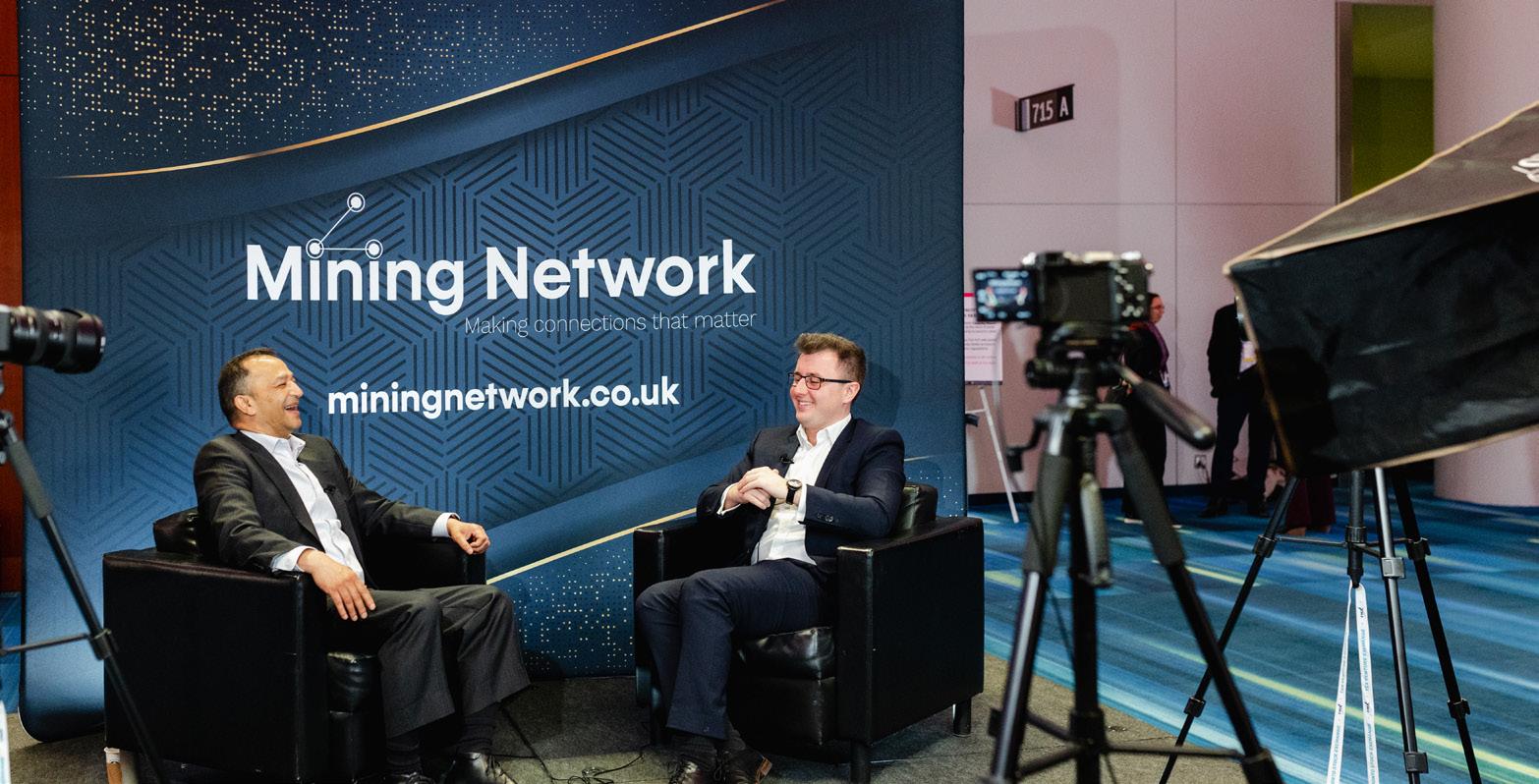
352 ACCREDITED MEDIA
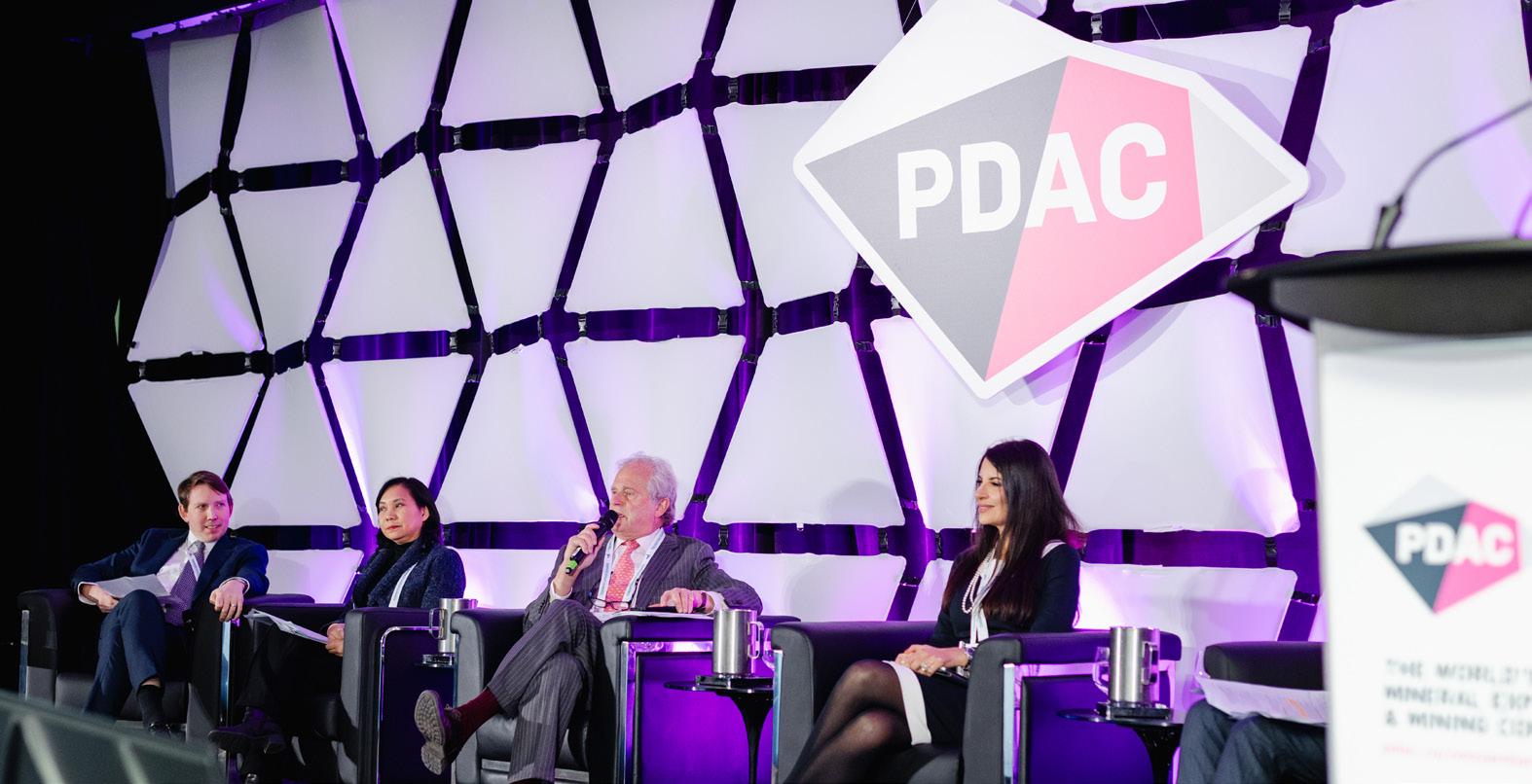
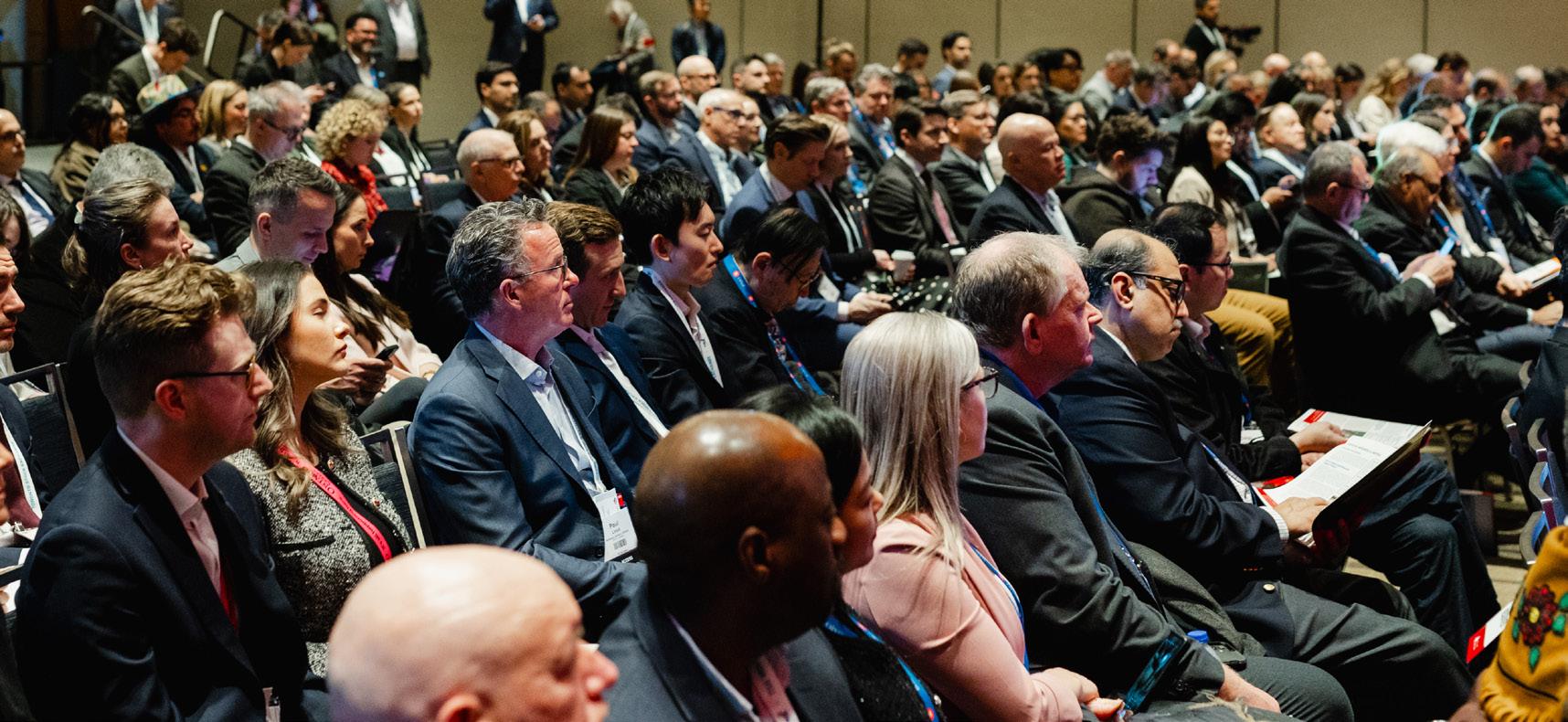
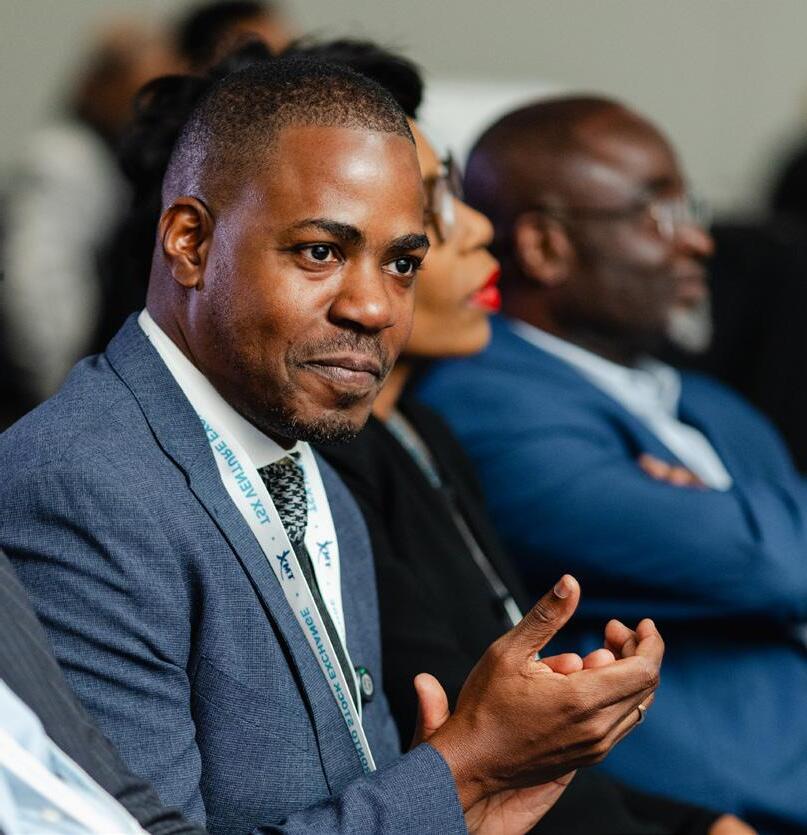
8 SHORT COURSES
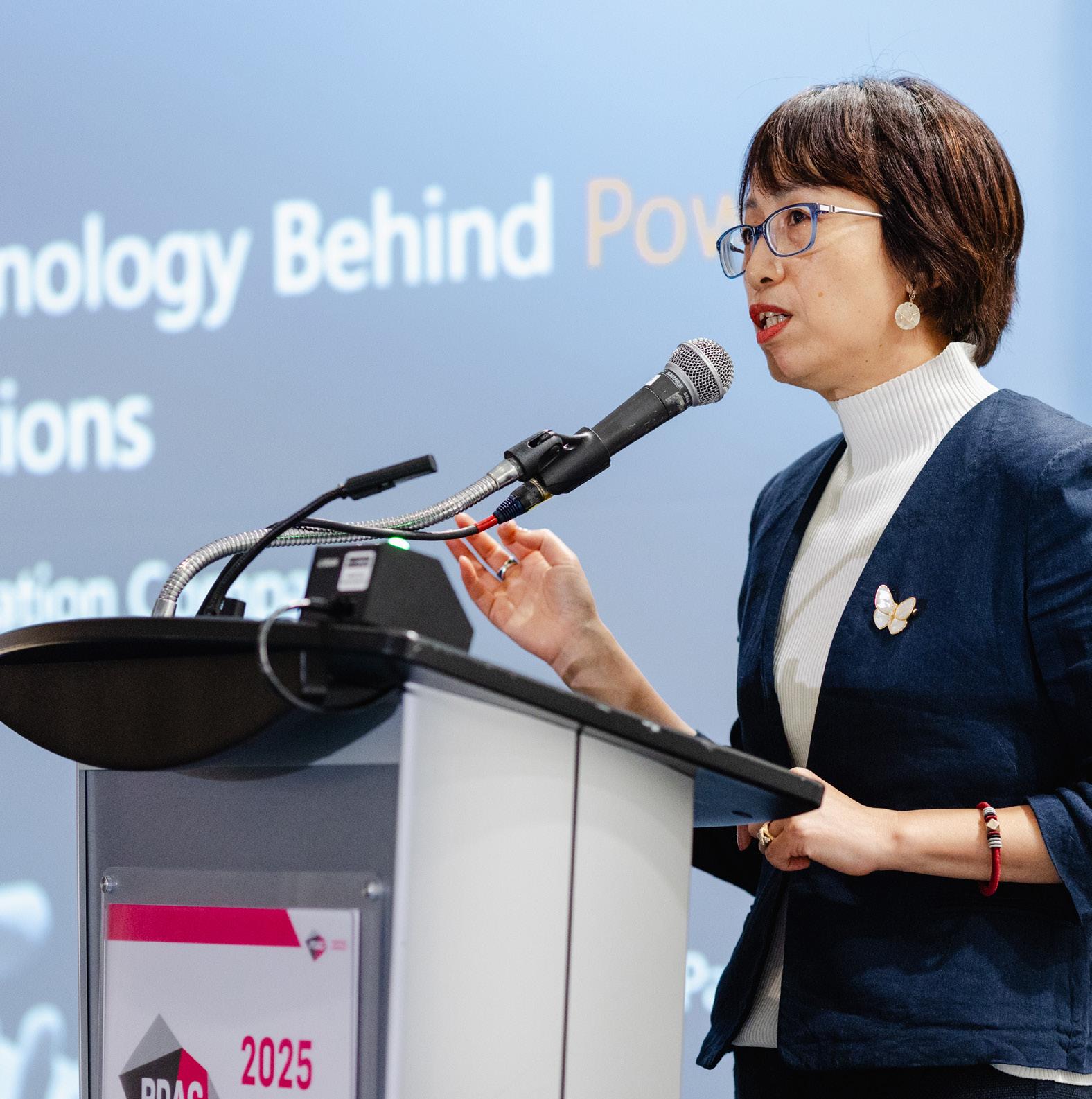
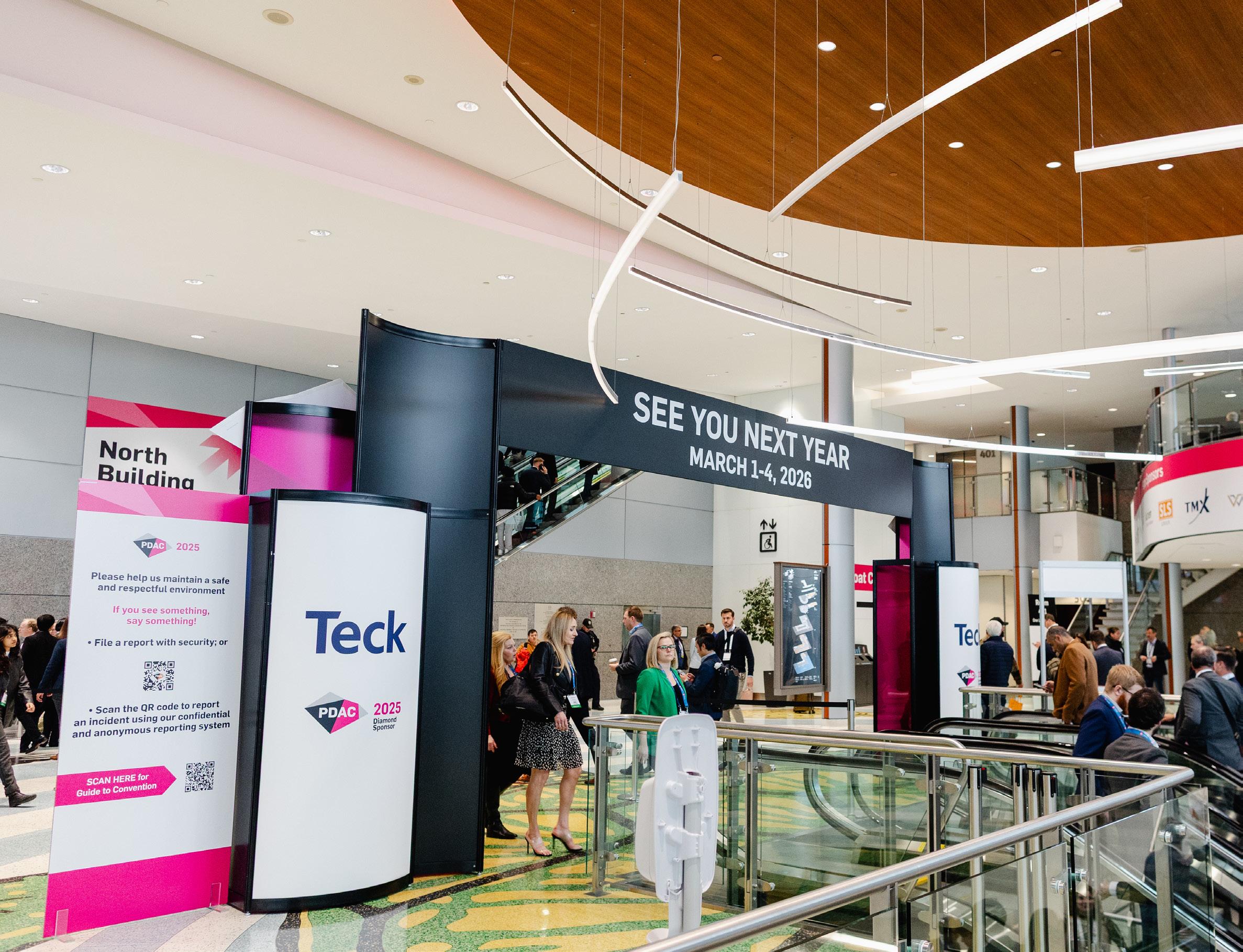
A wide range of opportunities for presenters and facilitators to share knowledge, strategies, new concepts, case studies and more are still available for PDAC 2026.
The following program areas are currently accepting applications:
• Exploration Insights
• Short Courses
• Corporate Presentation Forum for Investors (CPFI)
• Presentation and Reception Rooms
Apply today by visiting: pdac.ca/convention/programming-opportunities-2026
Renewing exhibitor applications opened on June 12, 2025.
Renew your Investors Exchange, Trade Show and Trade Show North booth space(s) for PDAC 2026 by the deadline of August 14, 2025.
New exhibitor applications open on September 16, 2025.
Mark your calendars and apply in September for booth space(s) in the Investors Exchange, Trade Show, Trade Show North, Core Shack, Prospectors Tent and Indigenous Artisans areas.
| For more information on PDAC 2026 exhibitor applications, please visit: pdac.ca/convention/exhibitor-opportunities-2026
Sponsorship opportunities are now available for PDAC 2026.
Connect with your target audience and amplify your impact by visiting: pdac.ca/convention/sponsorship-2026
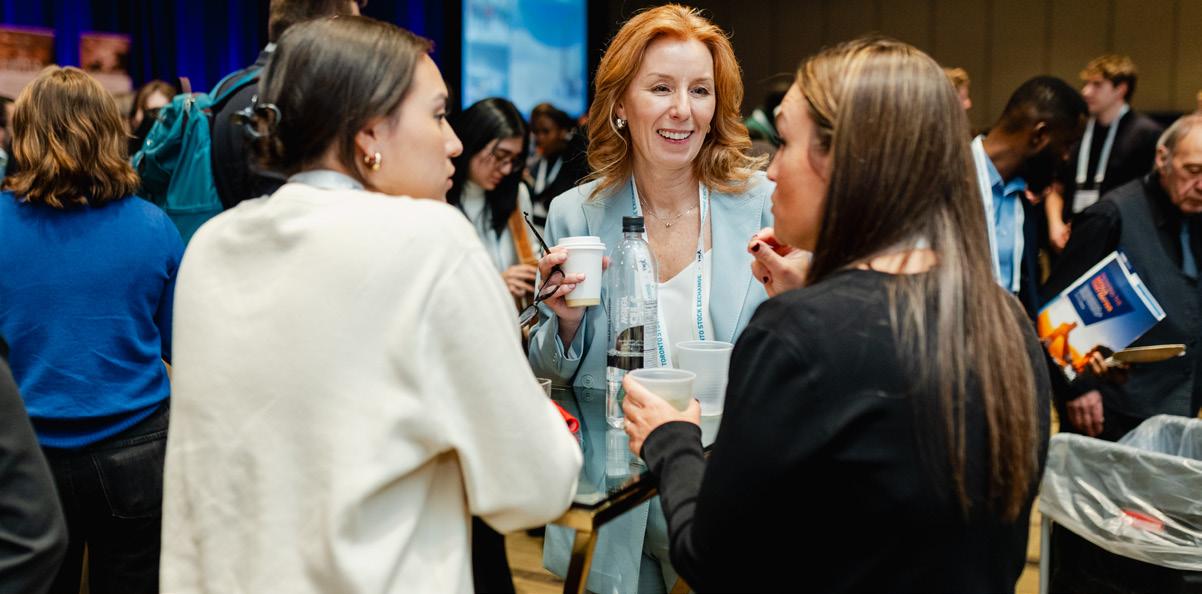
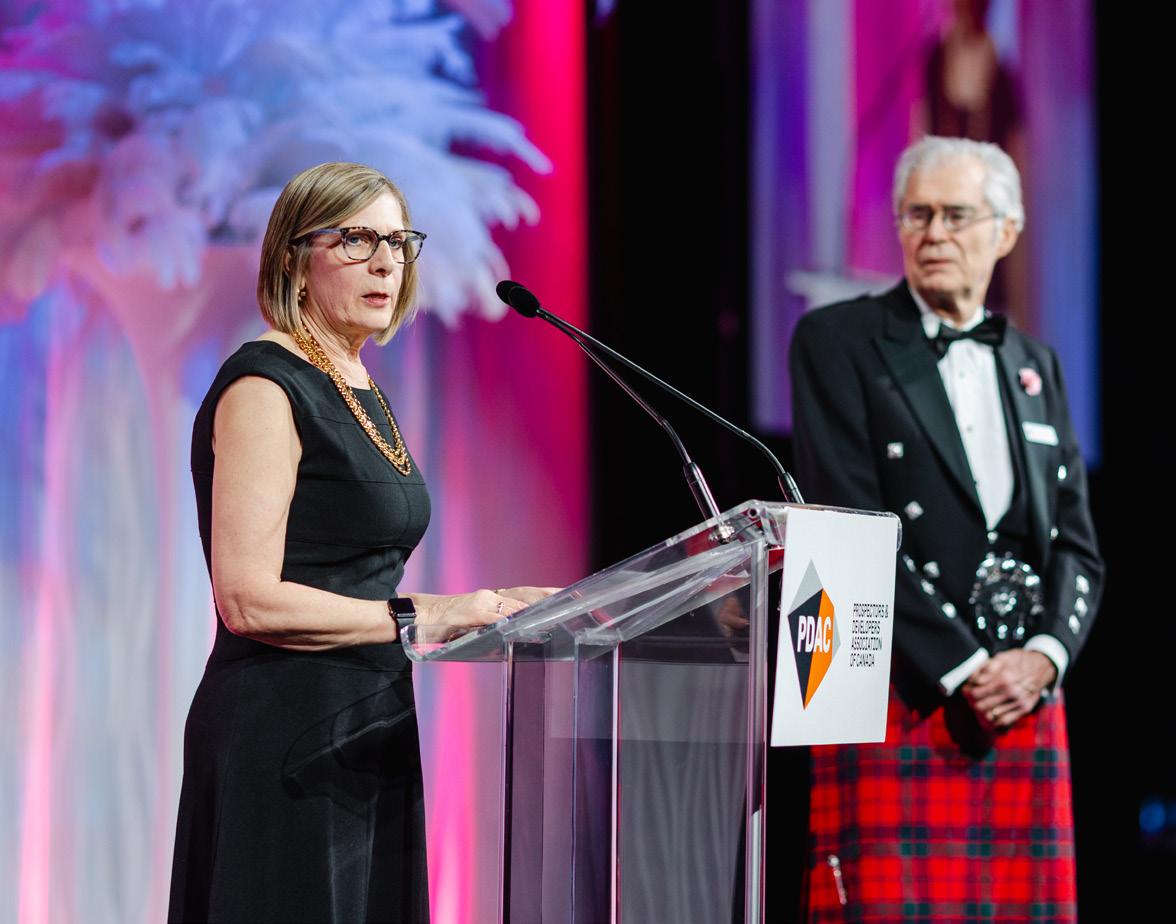
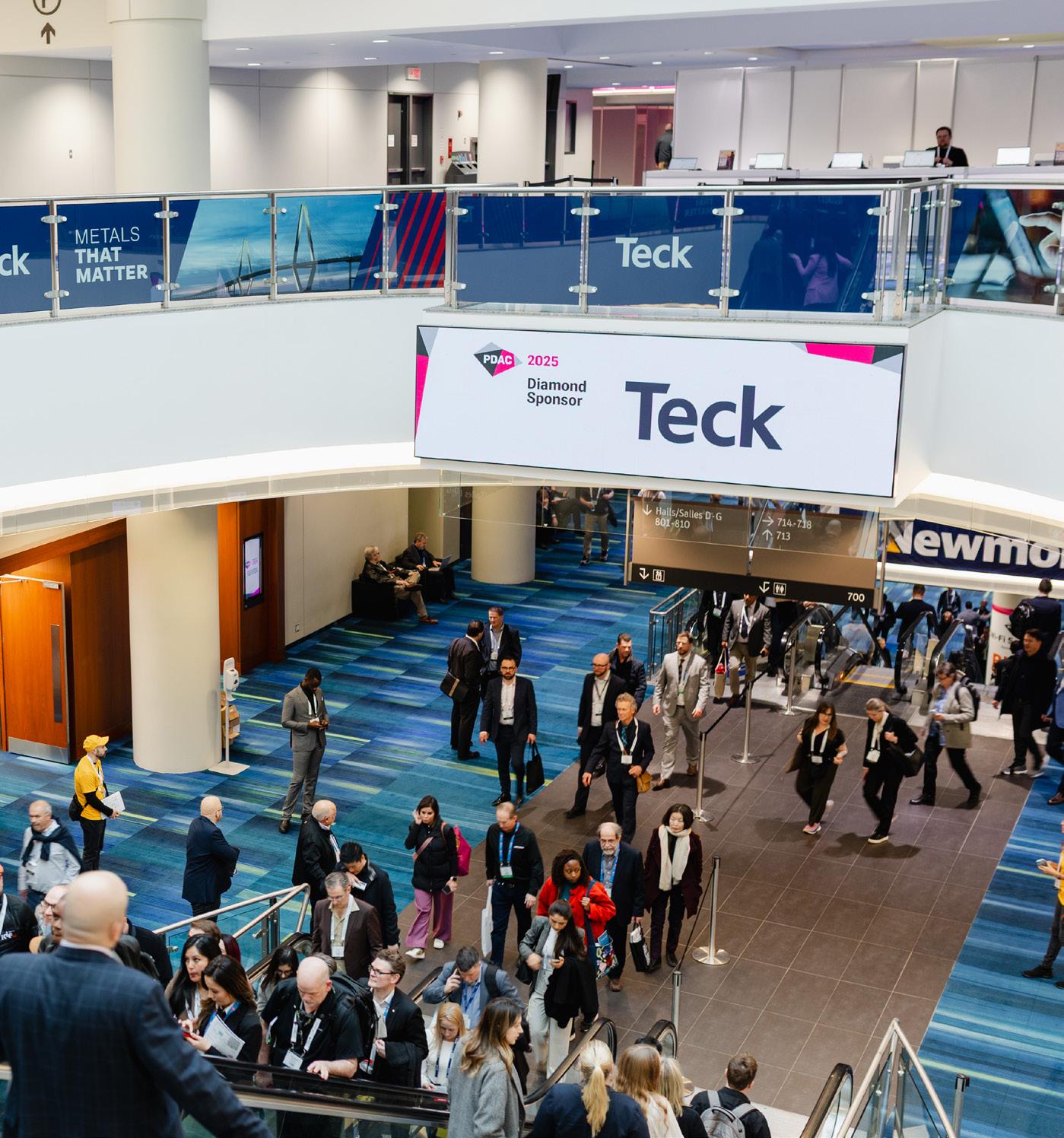
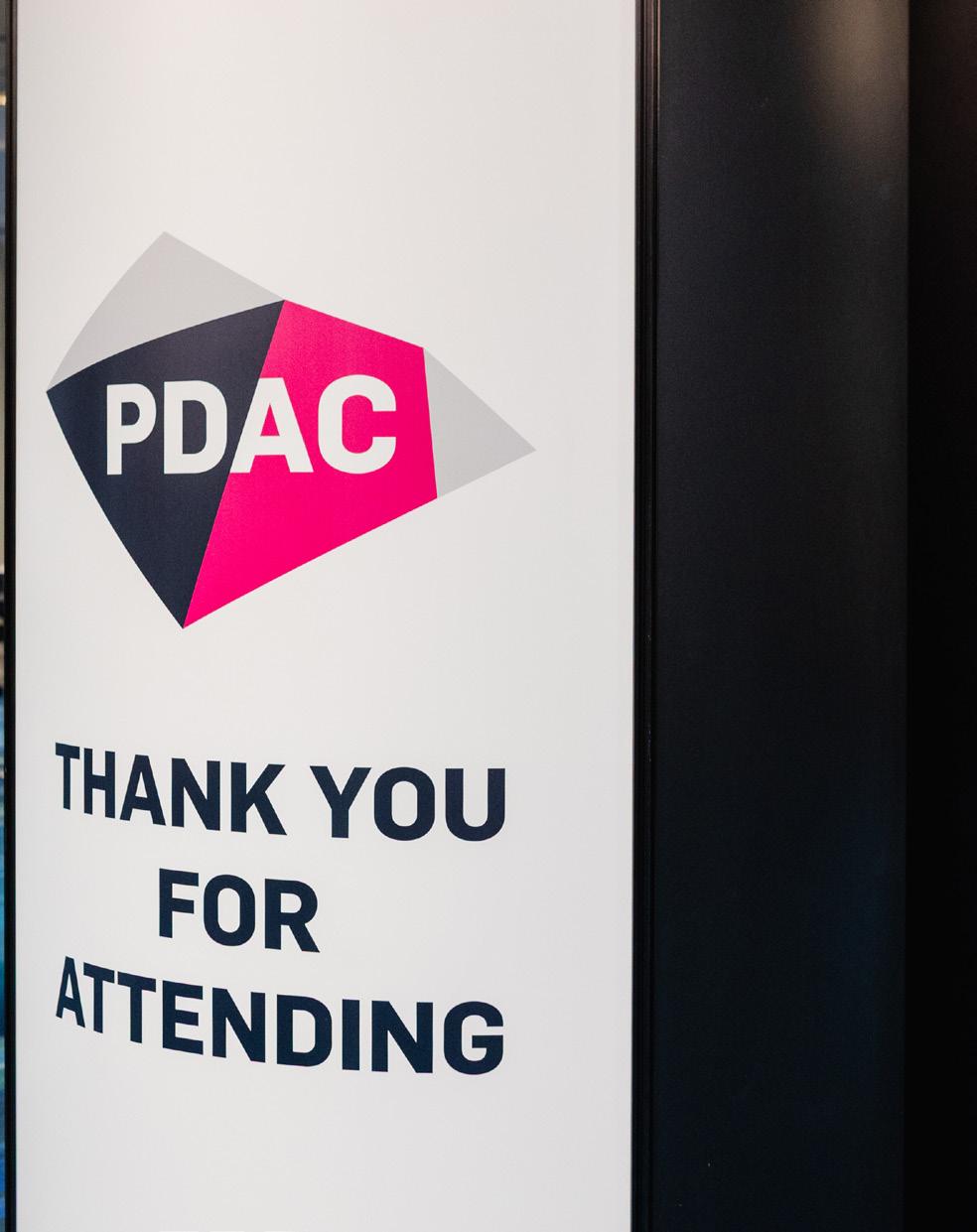
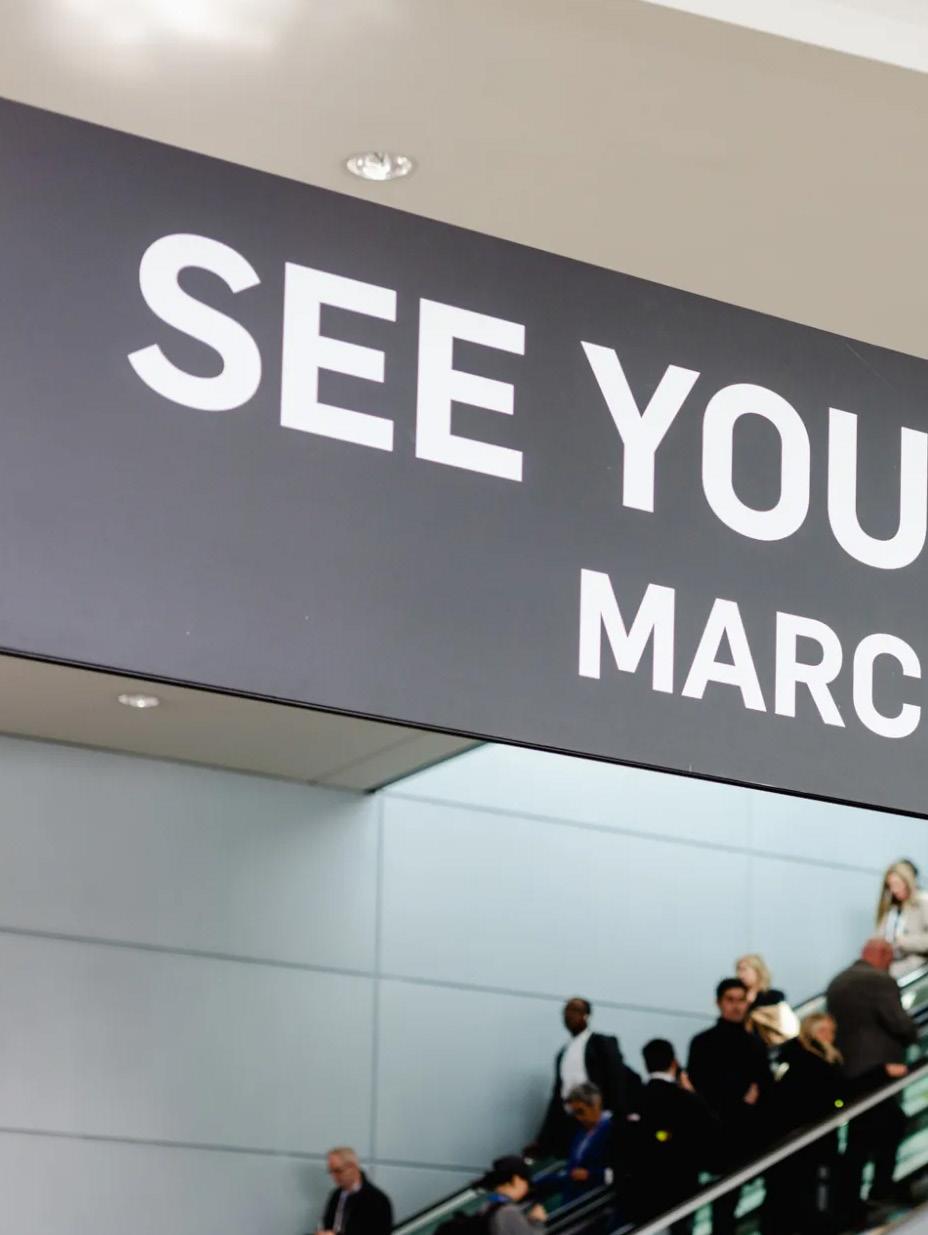
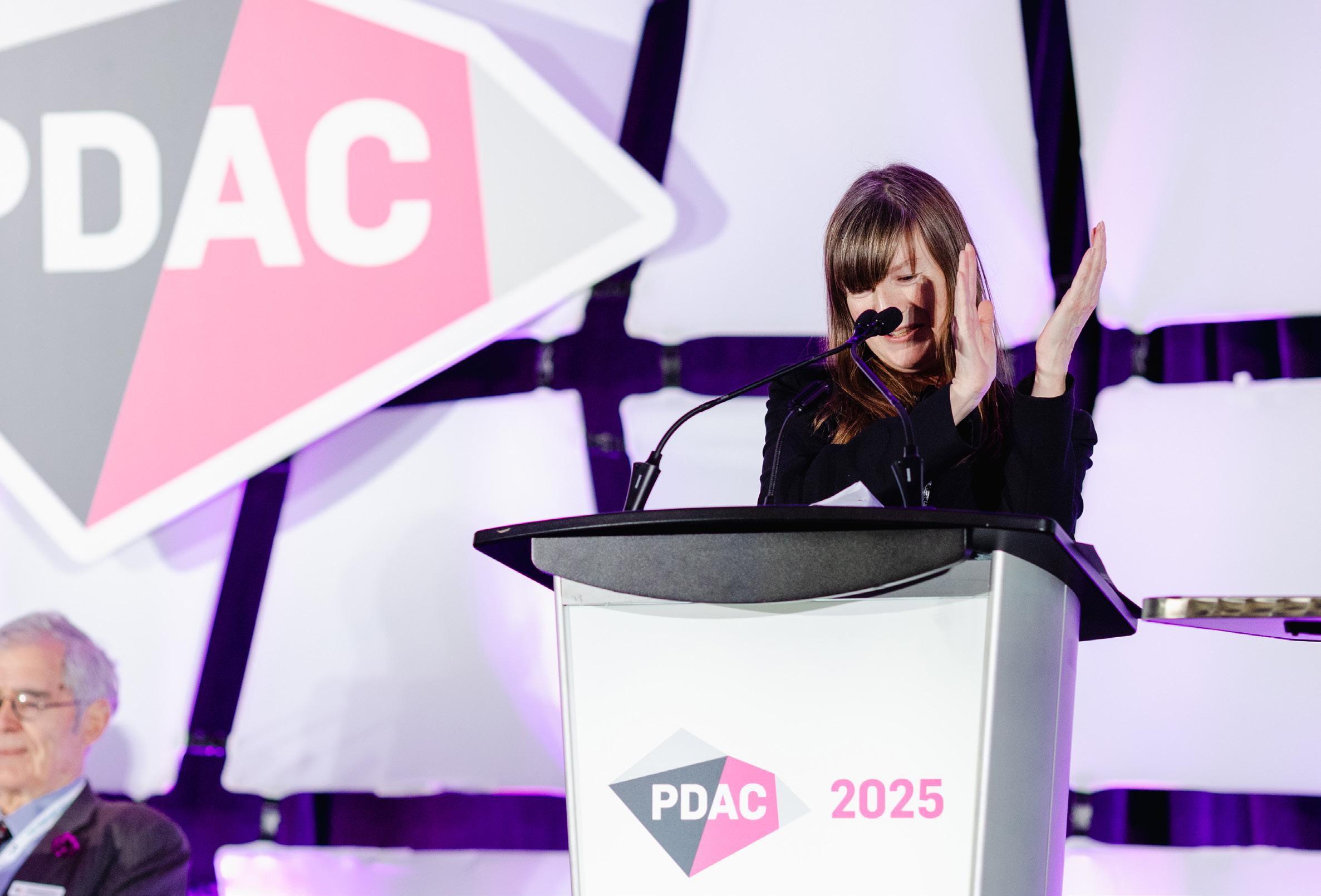

Thank you to everyone who participated in PDAC 2025, including our volunteers, presenters, sponsors, exhibitors and attendees. We look forward to welcoming you back at PDAC 2026.
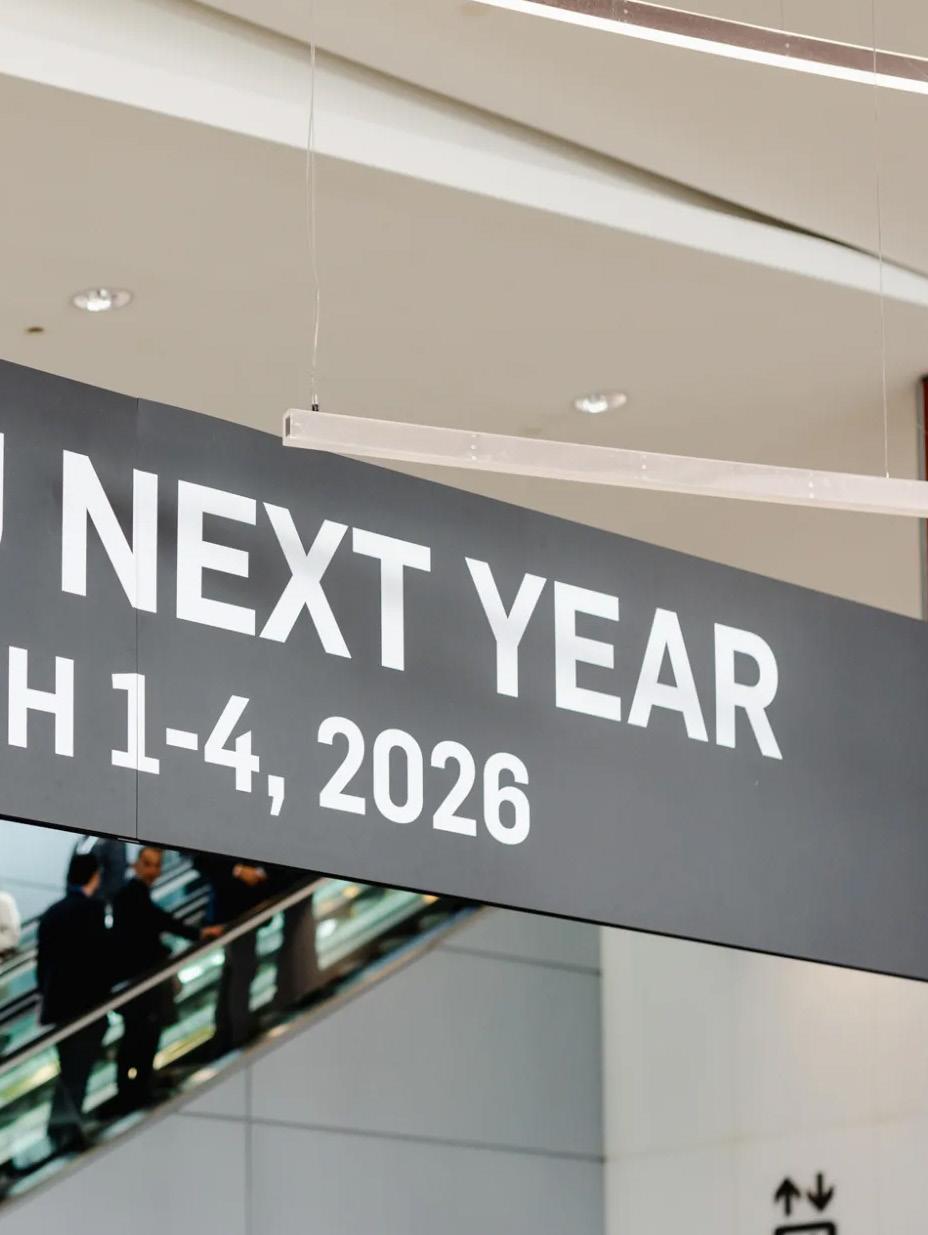

THANK YOU TO OUR PDAC 2025 CONVENTION
PLATINUM SPONSORS

HOST COUNTRY SPONSOR
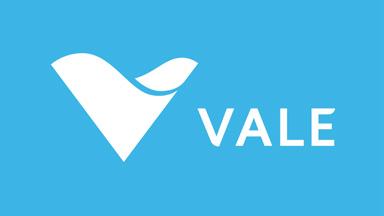
PATRON SPONSORS ®




MEMORABLE MOMENTS FROM THE THIRD ANNUAL DR. DONALD M. LEISHMAN CONVENTION EXPERIENCE IN TORONTO
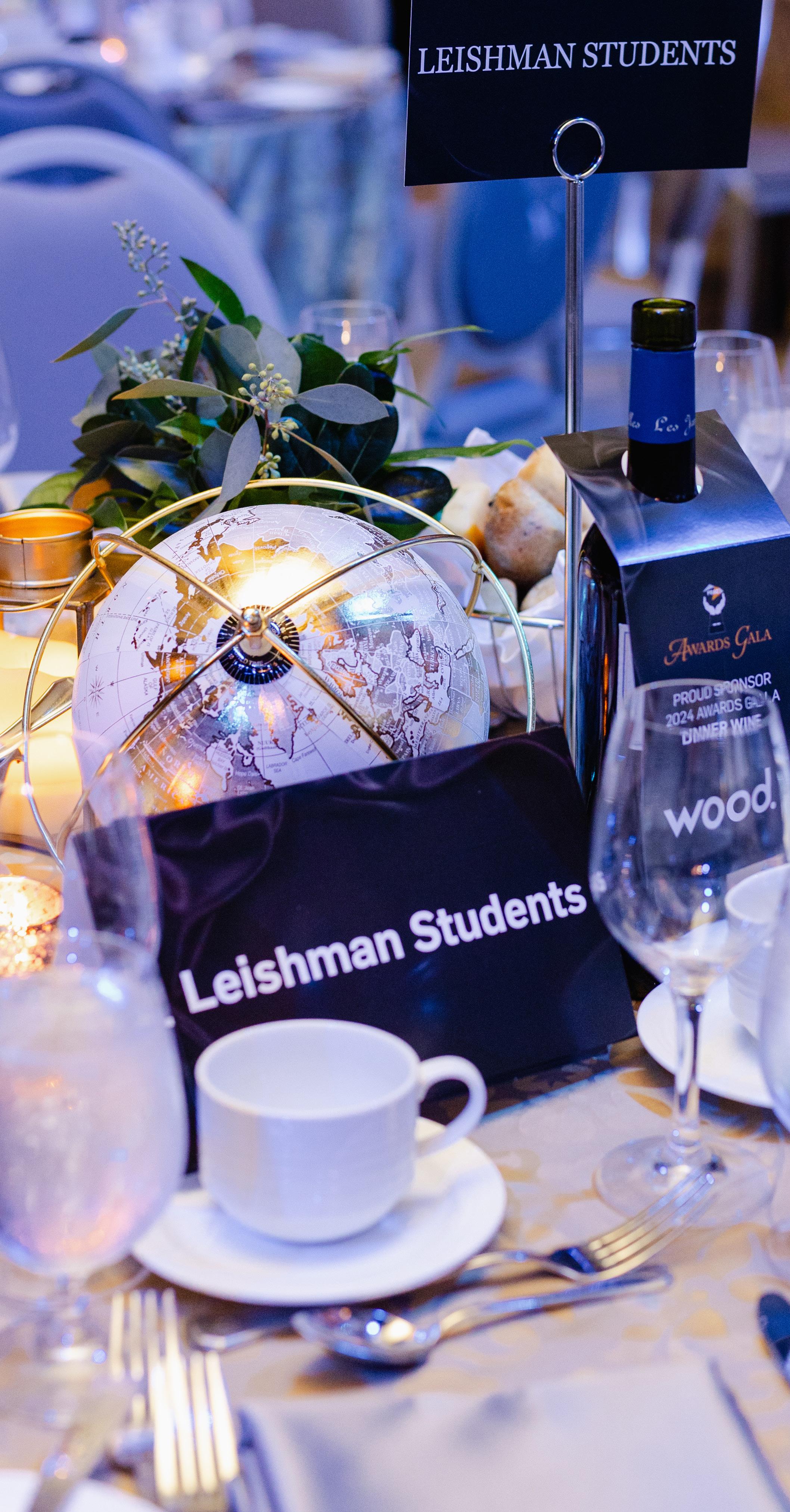
In 2025 the Leishman family and PDAC provided five students with an all-expenses paid trip to the annual Convention in Toronto, to attend exclusive events, meet with industry professionals and experience unique learning opportunities.
The experience left me departing this year's convention feeling inspired, empowered and motivated by the infectious energy within the mining community. Every individual I came across was overwhelmingly eager to provide guidance and mentorship to someone early in their career like myself, reinforcing my passion for the industry.
- Aisha Mohammed University of Waterloo
The five students that were selected for this extraordinary opportunity at PDAC 2025 are all enrolled in geology and engineering programs at post-secondary institutions in Canada. These students were chosen from a wide range of applicants who submitted resumes and short videos that highlighted their programs of study, explained why they would like to work in the minerals industry, and included what they hope to gain from attending PDAC's annual convention.
This year's students were: undergraduates Aisha Mohammed from the University of Waterloo's Geological Engineering program; Karen Brookman and Leah Mymin from Acadia University's Geology program, and graduate students Marco Vasquez from Laurentian University's Geology program and Zamdazitta Kumbakumba from Laurentian University's Engineering Science program.
Continuing Dr. Donald Leishman's legacy of mentoring students and generosity, the five recipients had their flights, meals and accommodations covered while in Toronto, and received complimentary All-Access passes to PDAC 2025. They also attended invitation-only events and programs during the four-day convention. This included exclusive events such as the President’s Reception, S-IMEW Alumni Reception and the Awards Gala & Nite Cap where they made new connections with industry leaders, fellow students and mentors.
In addition to the professional and industry connections, the trip created opportunities on a personal level that the students may not have had a chance to experience otherwise. As Karen Brookman describes, "Prior to attending the 2025 PDAC Convention, I had never been on a plane, travelled outside of the Maritimes, been to Ontario, or had any exposure to the mining and mineral exploration industry. Now, I can say that I have done all of those things – and more! Getting to attend the convention as part of the Leishman Experience was life-changing."
This notion of life-changing opportunities held especially true for international students Marco Vasquez and Zamdazitta Kumbakumba. "My passion and commitment to succeed in the industry, especially as a newcomer, was...a significant factor in my decision to apply. I left with meaningful connections that I can always reach out to at any point in my career for advice or guidance. The experience taught me the importance of opening myself to the opportunities around me," wrote Zamdazitta.
Similarly, Marco had this to say about the event, "When I received the email saying I had been chosen, I felt incredibly happy, and at the same time, a strong sense of responsibility and commitment to the organization. Attending PDAC for the first time was a transformative experience that exceeded all my expectations. It motivated me to keep learning and showed me the vast range of exploration opportunities that exist in this country."
Being able to interact with professionals from fields I’m interested in and have the chance to seek mentorship has been a rare and invaluable opportunity.
- Leah Mymin Acadia University
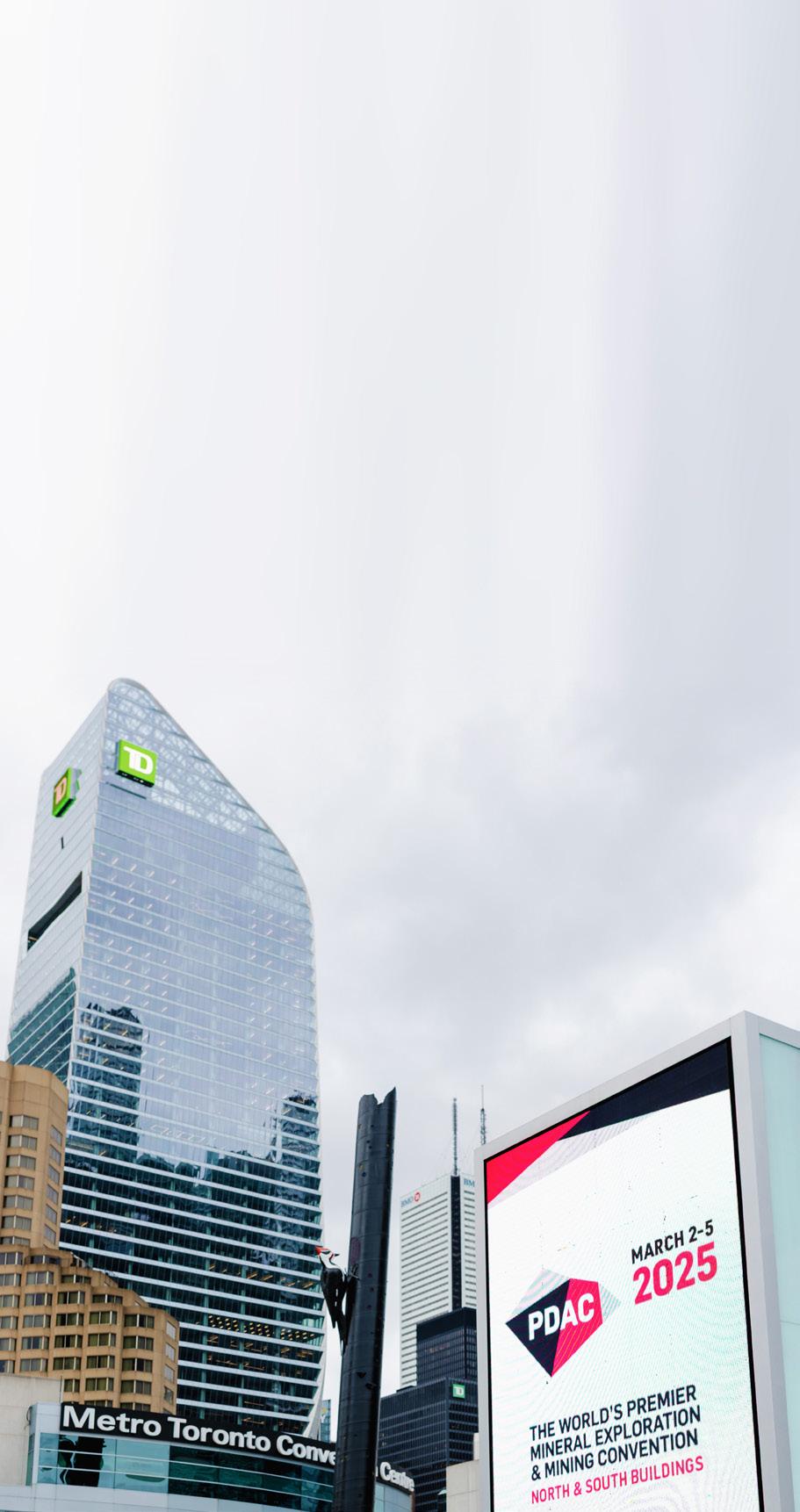
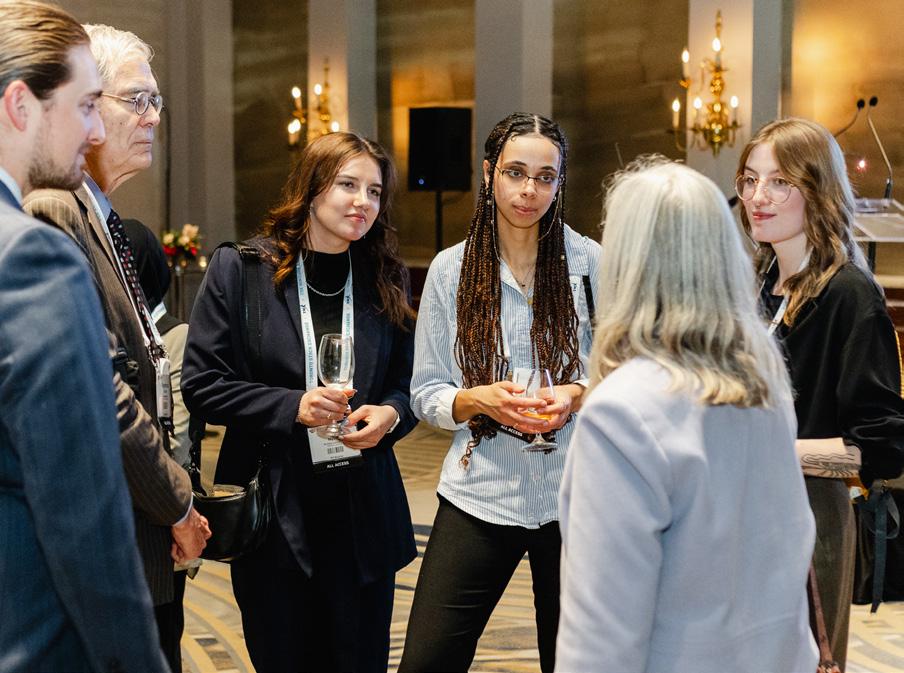
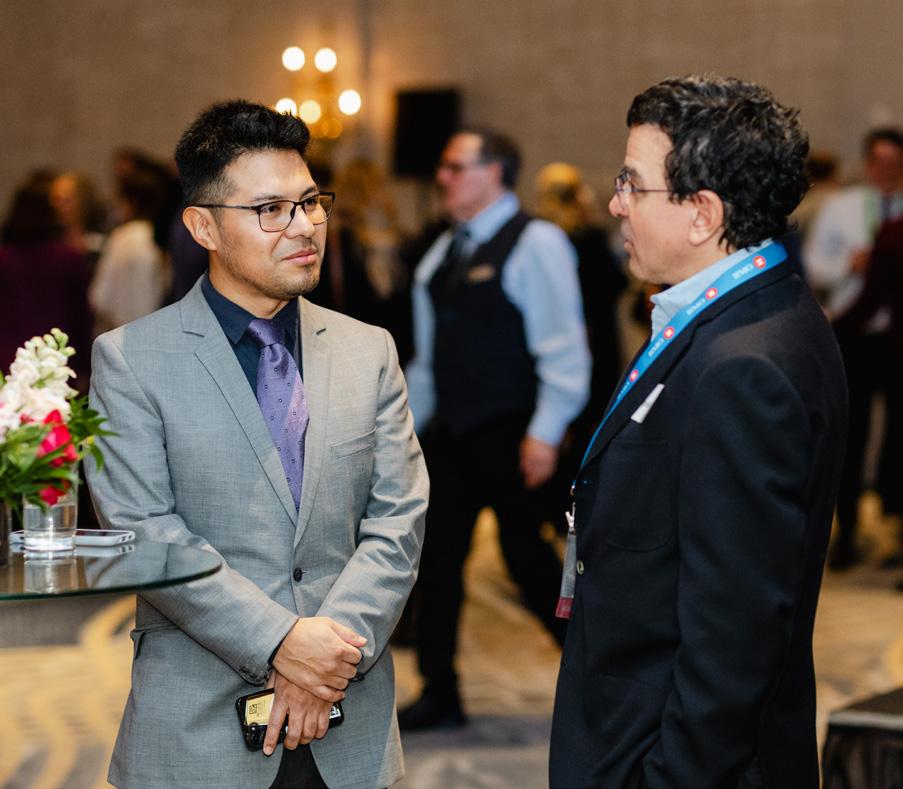
The Leishman Experience also gave students the unique opportunity to engage with PDAC’s Board of Directors and government representatives, who shared valuable advice and career guidance. With all expenses covered – including PDAC student memberships – the Leishman Experience will continue to provide an enriching opportunity to geoscience students across Canada.
To sum up their experiences, PDAC asked the students what their expectations were going in, and what was the most memorable element for them:
Leah: "I wasn’t sure what to expect going in. One thing I found super eye-opening was seeing all the people involved in the industry through roles beyond pure geology—lawyers, policy writers, government liaisons, professionals, environmental consultants, booths pitching new technologies, and more. The number of moving parts in the industry is truly staggering. The most interesting person I met would have to be Nathan Monash. He was a mentor in the 20-Minute Mentoring session put on by the Student & Early Career Program. He’s the vice-president of sustainability at Lundin Mining and has extensive experience in government relations. We had an incredible conversation about sustainability in the industry, and he opened my eyes to roles that might align with my interests. He really helped me orient my career goals going forward. The amount of meaningful advice and insight I received...was incredible. I now have several mentorship contacts I can turn to for advice and support."
Marco: "For years, I had followed the news about PDAC and always dreamed of one day attending and being part of the convention. Visiting the booths, especially the Core Shack, was one of the most eye-opening experiences. Dozens of companies were showcasing their projects and recent discoveries, which gave me a deeper appreciation for the incredible diversity and richness of Canada’s mineral deposits." Attending technical sessions and engaging with renowned experts who shared their knowledge was another highlight for Marco, who was also motivated by the opportunities available for students and early-career individuals in the industry. "Something that positively caught my attention was the importance and visibility given to students. After all, we are the future of the industry, and it’s incredible to have the chance to get involved early, be heard, and be encouraged to actively participate."
Karen: "This convention brought together thousands of people from different backgrounds to unite on one commonality – a passion and belief in geology and the mining industry. The highlight of the trip for me was getting to walk the convention floor. I met some of the most interesting people with incredible stories through networking events, friends of friends (of friends), and learned how unique our community is. The industry is nothing like what it used to be, and it was truly inspiring getting to see the work that goes on behind the scenes to make the industry what it is today. Responsible and safe mining of minerals and metals is possible, actively happening and crucial to society. I am happy to say that I secured my very first industry job in mineral exploration that I will be starting this summer, and I cannot wait to get back out into the field."
Zamdazitta: "A friend who attended and had a positive experience encouraged me to apply; she was able to get a mentor and reconnect with mining companies from her home country who attended PDAC's convention. I did go in with the expectation to find a new mentor or contacts that would aid my job search." As for the most memorable moment, Zamdazitta describes meeting Dr. James Siddorn, president of SRK Consulting, during a mentoring session. "He was incredibly down to earth, and it felt surreal to meet someone of his stature in such an informal setting. What struck me most was his humility and the sincerity of our conversation. He attentively listened to me and patiently answered all the questions I had, making the interaction both insightful and encouraging. We later connected on LinkedIn, and he kindly offered to provide advice as I navigate different stages of my career."
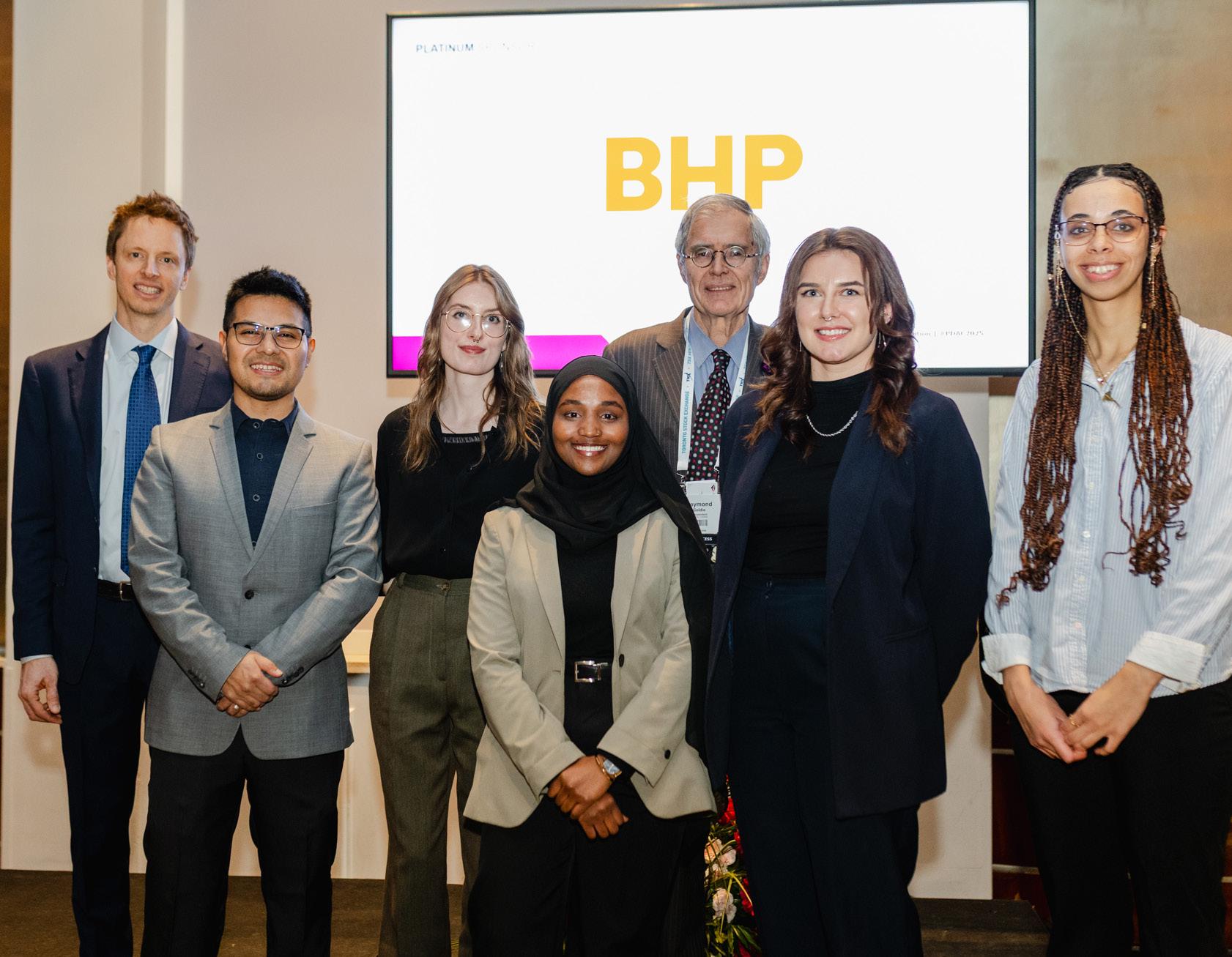
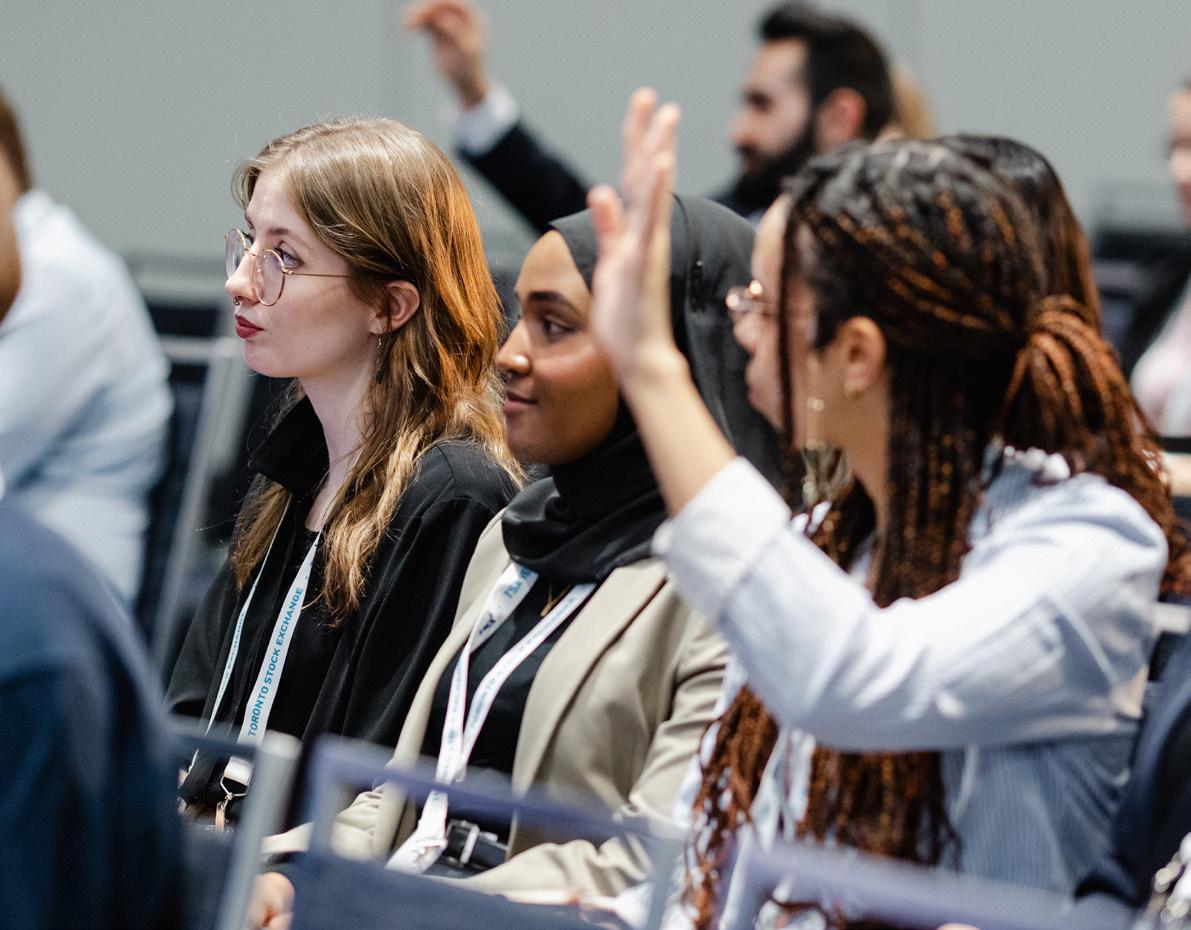

Getting to meet students and industry professionals from all over the world is something you don’t get to do often, and especially not at this scale. I thought I couldn’t possibly fall more in love with geology, yet here I am. I will forever be grateful to the Leishman Family for this honour and generosity.”
- Karen Brookman Acadia University
Dr. Leishman was a family physician with a passion for geology and mining. As an enthusiastic participant at many PDAC conventions, he left a legacy of generosity as a mentor for students. In his honour, the Leishman family created this unique opportunity for students to experience the PDAC Convention in order to make connections, network, and access other mentorship opportunities to help advance their careers in the industry.
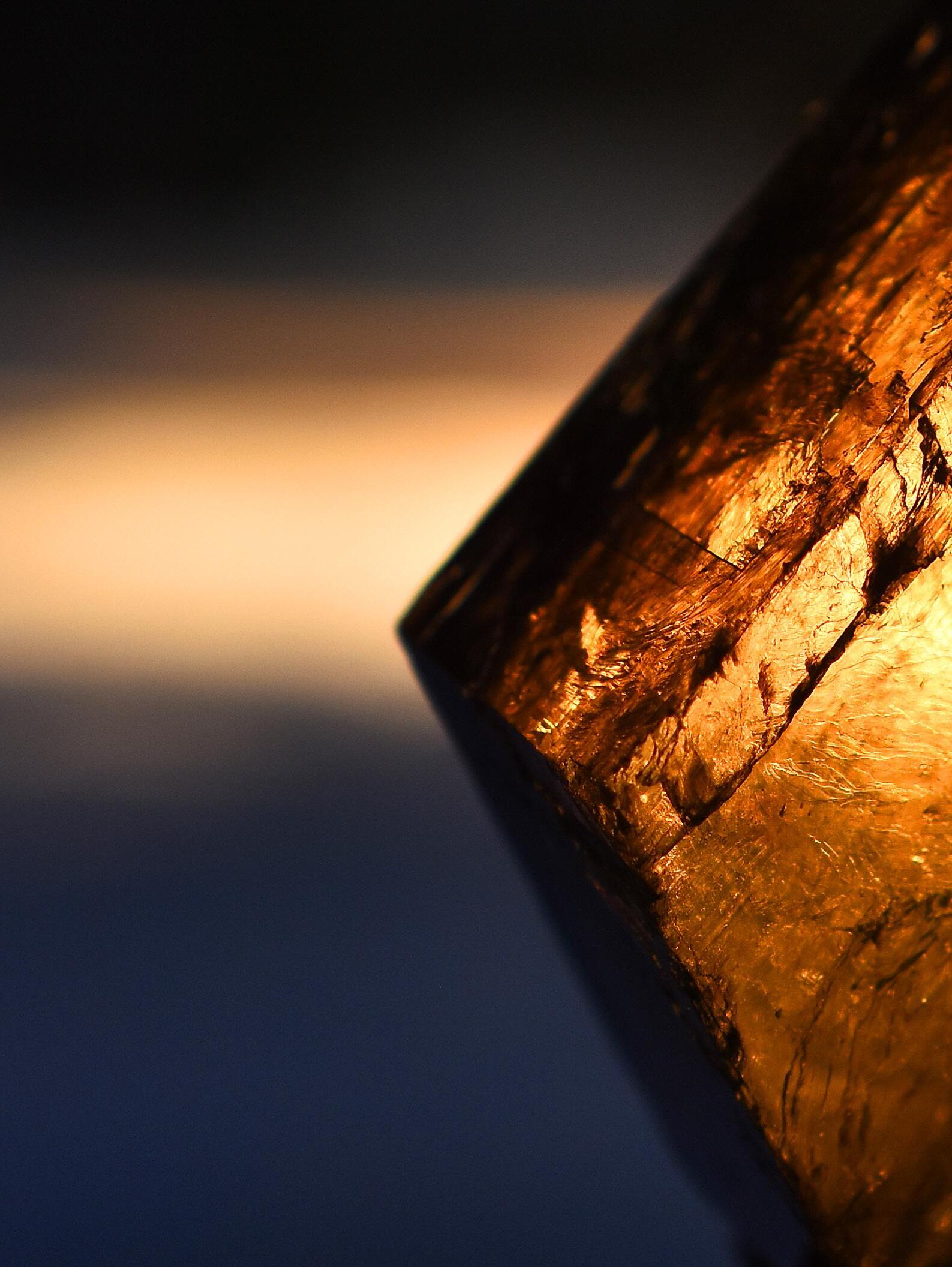
PDAC WAS HONOURED TO WELCOME NINE YOUNG PEOPLE FROM ACROSS CANADA TO PARTICIPATE IN THE FIRST EVER INDIGENOUS YOUTH AND EARLY CAREER AMBASSADOR PROGRAM AT PDAC 2025
The Indigenous Youth Ambassador Program provides an incredible opportunity for Indigenous youth and mineral industry leaders to convey their perspectives on the past, present and future of the mining industry. Being given the chance to glean wisdom, exchange ideas, discuss expectations and share concerns with top decision makers was a phenomenal opportunity to have been afforded me. The culture and spirit of reconciliation espoused by PDAC is brilliantly demonstrated by this program, and I have high hopes that its growth will facilitate the development of greater trust and stronger relationships between the mineral industry, governments and Indigenous nations.
- Devon Patterson Laurentian University, PDAC Indigenous Ambassador

Developed from the feedback of Conventions attendees, PDAC members and the association's Indigenous Affairs Committee, this program aims to encourage and support Indigenous youth and early-career professionals to become the next generation of leaders in the mineral exploration and mining development industry.
The mineral industry is the largest private sector employer of Indigenous Peoples in Canada, and a key supporter of Indigenous businesses and economic prosperity. PDAC believes early engagement is one of the cornerstones of building relationships between Indigenous communities and our industry. PDAC’s Indigenous Affairs Committee itself is composed of mineral exploration experts and Indigenous leaders who provide guidance for our members, and advocates for capacity investments, access to infrastructure, and the meaningful participation of Indigenous Peoples in the opportunities presented by the mineral industry.
The association recognizes that educating a new generation about the opportunities available through mineral exploration and mining development is of the utmost importance for the future of the sector. With this, the Indigenous Youth and Early Career Ambassador Program was created to not only encourage Indigenous youth and early career professionals to attend PDAC's annual convention, but be given the opportunity to network and make connections with industry leaders, learn through participation, and bring their experiences back to their community and peers.
The program offers Indigenous youth financial assistance for their travel and accommodation expenses to attend PDAC's Convention in Toronto, as well as an All Access Pass, unique mentoring opportunities, and invitations to exclusive events during the world's premier mineral exploration and mining showcase –giving participants the opportunity to connect with Indigenous leaders, entrepreneurs and peers already in the industry.
The annual convention offers one of the most important platforms to foster cooperative and respectful relationships by bringing communities, Indigenous-owned companies and industry together in one setting to share their experiences, exchange ideas and network.
The Ambassador Program was developed in a way that gives industry an opportunity to learn directly from Indigenous youth who are interested in the mineral sector, to hear their perspectives and the challenges they and their communities are facing.
Speaking about the prospect of more Indigenous youths attending the Convention, Holly Martin – a young Indigenous professional working with Alamos Gold - said: “To be here really would cement the idea that…this is a world they can be part of. It’s a world that can uplift them. I can see it, especially in the young people’s faces when they come up to my booth and I talk about where I come from and what I’ve done and what mining actually is. And I think that it removes the barrier and opens a door for opportunity, which is absolutely critical if we want our youth in the North to make it.”
Recognizing that Indigenous youth are vitally important to the future of the mineral industry, the overarching goal of the program is to foster a relationship where Indigenous youth can bring their experiences to the sector, and the industry can find more ways to support their participation as they work towards becoming the next leaders in the mineral exploration and mining development community.
Based on feedback from the Ambassadors who attended PDAC 2025, the Indigenous Youth and Early Career Ambassador Program's first year was a major success. PDAC looks forward to welcoming next year's group of Ambassadors, as well as continuing to engage with this year's participants and learning how their experience impacted them on an individual level, and within their communities.
The following are the nine Indigenous individuals PDAC was honoured to host as this year's Ambassadors for the inaugural program:
Tasheena Recollet
Wikwemikong First Nation, Ontario
Clyde Moonias
Neskantaga First Nation, Ontario
Jamie-Lee Giroux-Lacasse
Temiscaming First Nation, Québec
Ashley McConnell
Wiikwemkoong Unceded Territory, Ontario
Devon Patterson
Serpent River First Nation, Ontario
Kyra Hagerty
Attawapiskat First Nation, Ontario
Josee Filion
Dokis First Nation, Ontario
Ashley Jay
Tahltan Nation, British Columbia
Caden Wallace-Booth
Tahltan Nation, British Columbia
Applications are now open for the 2026 program.
Indigenous youth and early career professionals can apply for the program today. PDAC also strongly encourages companies to nominate eligible candidates from within their organizations or partner communities. To learn more and nominate an ambassador today, visit pdac.ca/indigenous-ambassador-program .
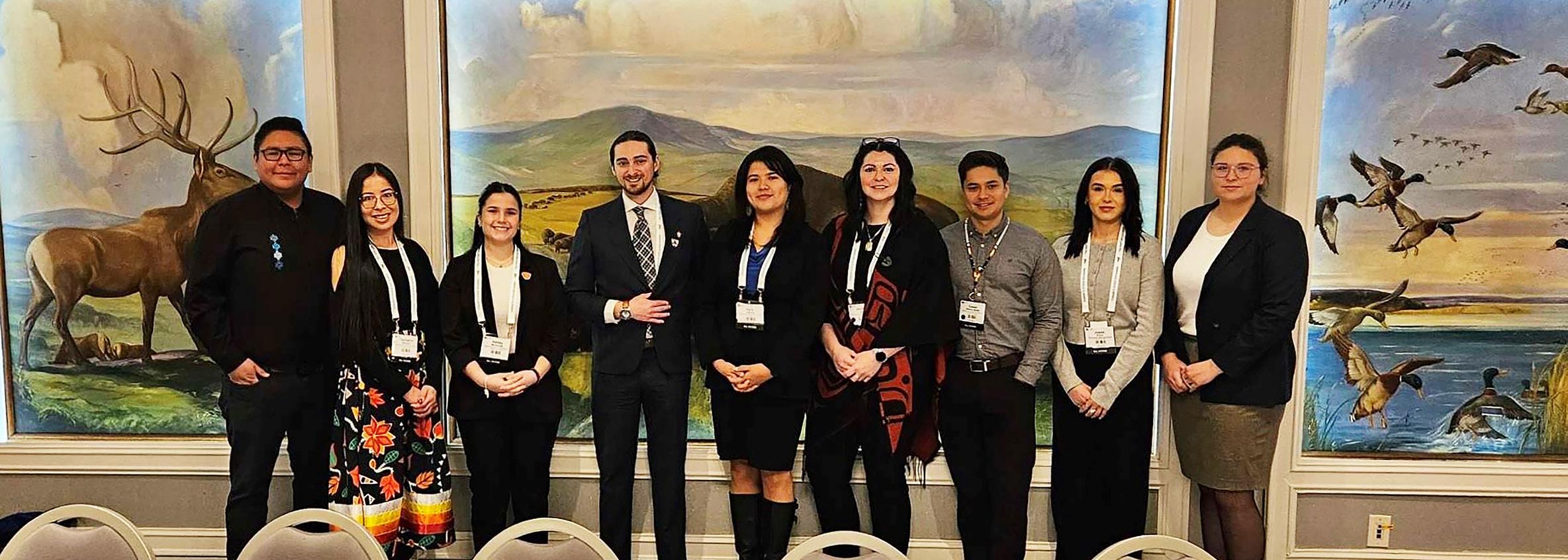
Visit pdac.ca/indigenousaffairs to learn more about how our association continuously works to support the development of positive relationships between Indigenous communities and the industry.
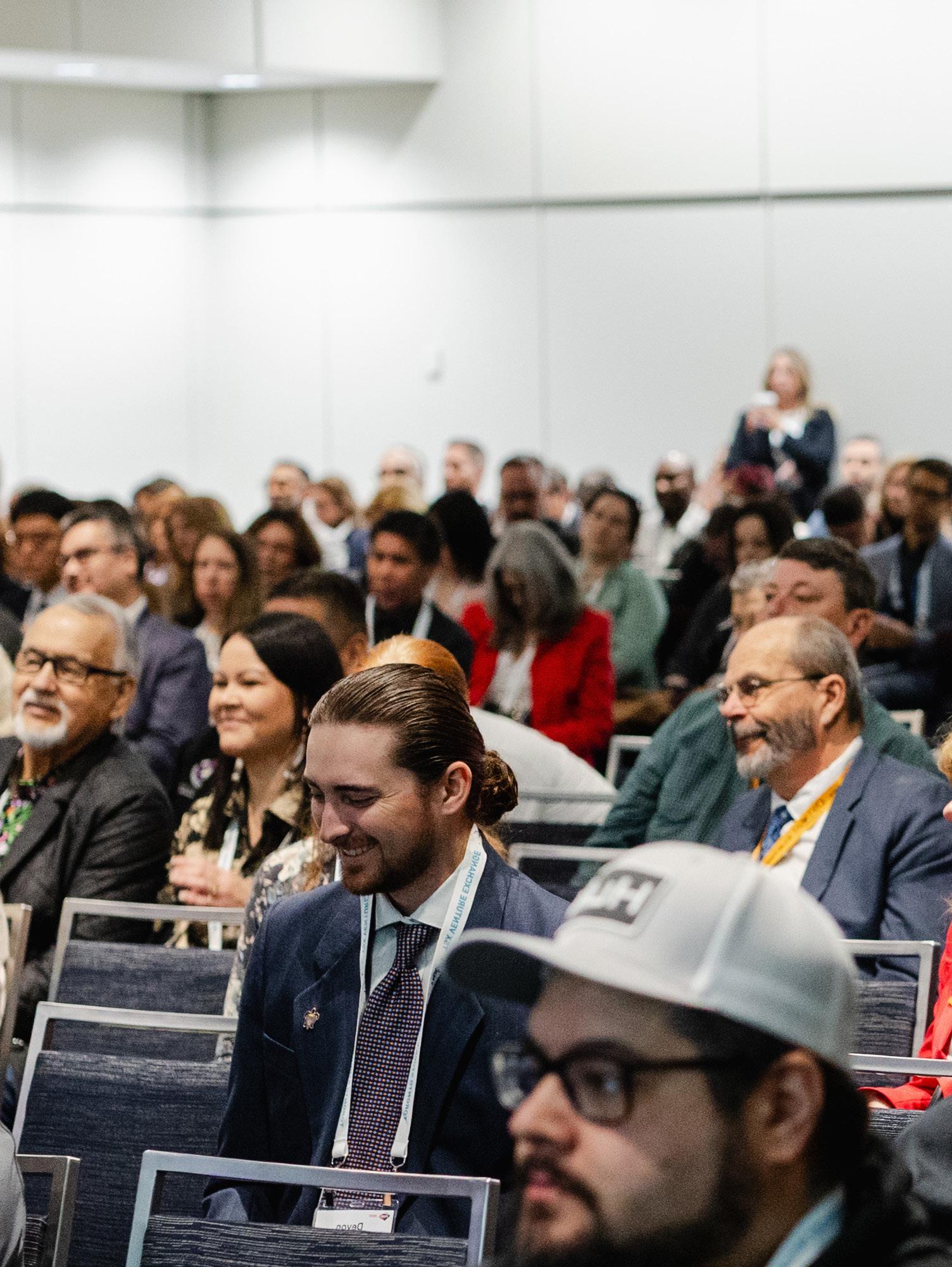

PDAC UNVEILED A NEW ARTWORK BY INDIGENOUS ARTIST KARLY CYWINK AT THE PDAC 2025 CONVENTION, CREATED TO ACCOMPANY ITS LAND ACKNOWLEDGMENTS DURING THE GLOBAL EVENT
PDAC’s staff are primarily located in Toronto, Ontario, on the traditional territory of the Mississaugas of the Credit, the Haudenosaunee, the Wendat – Huron, the Chippewa and the Anishnabeg, and all of the Indigenous Peoples that have lived on these lands over the centuries.
These are also the lands on which PDAC's annual convention is held, which is why the association's Indigenous Affairs Committee endeavoured to bring respectful acknowledgement of the ancestral lands that host the convention – attended by tens of thousands of travellers from over 130 countries each year.
PDAC commissioned an Indigenous creator to produce artwork for a new land acknowledgment slide that was debuted this year at PDAC 2025. The artwork – illustrated by Karly Cywink – served to allow both reflection and celebration of the Toronto region's historical lands.
Karly is a mixed Anishinaabe multidisciplinary artist from Whitefish River First Nation, and a graduate of Toronto Metropolitan University’s
RTA Media Production program. Now based in Toronto, Karly works in film, communications, design, and traditional illustration and painting. Her work looks to the past and is forward-thinking, as evidenced in her documentaries that explore themes of Indigenous self-identity and self-determination in young adults. As an Indigenous artist, Karly aims to produce media that focuses on “sharing experiences and elevating the voices of others.”
PDAC was honoured to work with Karly, who brought her unique and traditional perspective to the association's land acknowledgment artwork. The art – envisioned by Karly to represent the communities, the land, and the priorities of Indigenous Peoples in Canada – became an important inclusion to the presentations and opening remarks of various sessions and events throughout the Convention.
Overlaid on Karly’s art was PDAC's full land acknowledgement text, providing an opportunity for attendees to see in writing the traditional names of the communities on whose land the Convention is hosted, and reflect on the meaning of the statement and the lands that they call home.

A
story that I hold dear to my heart is the story of Turtle Island and how it connects all that live on its back; it’s how we as people stay connected and how we are to treat each other. I wanted to showcase this Turtle as the center of the land – a piece that holds us together.
- Karly Cywink Artist
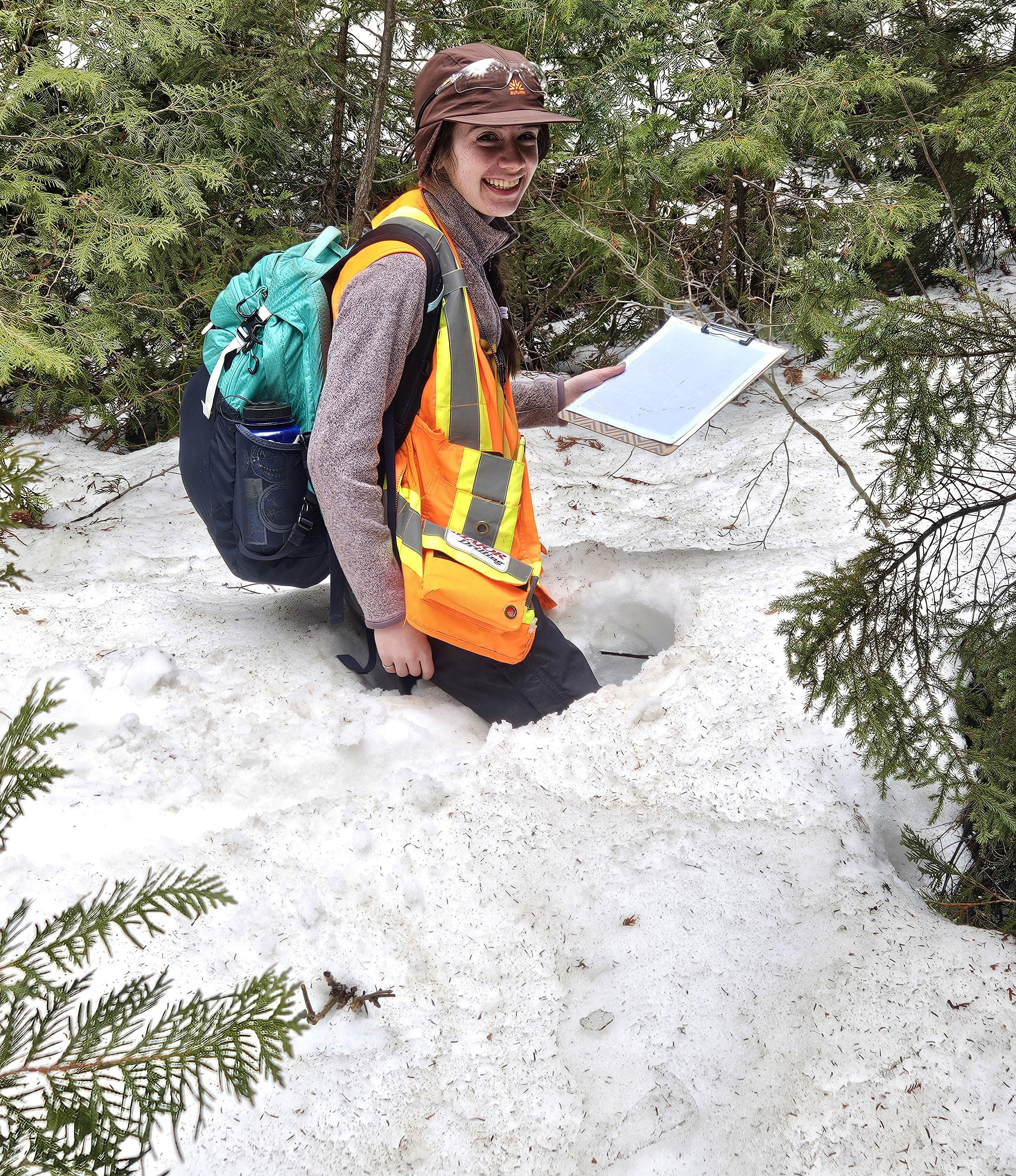
HIGHLIGHTS IN PICTURES OF THE 2025 STUDENT-INDUSTRY MINERAL EXPLORATION WORKSHOP
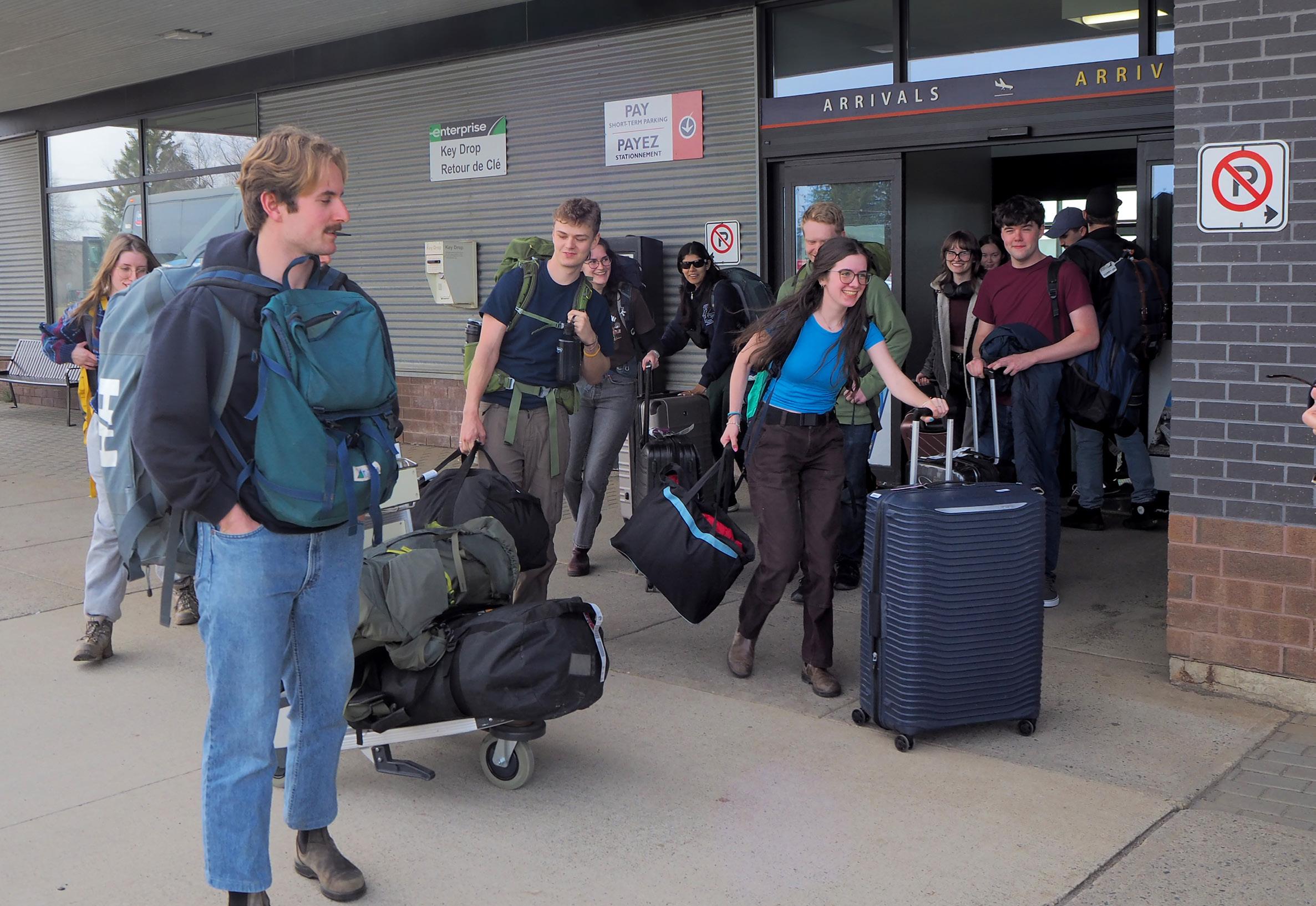
| APRIL 30, 2025
Students from all over Canada arrive in Sudbury, Ontario, to kick off the two-week workshop.
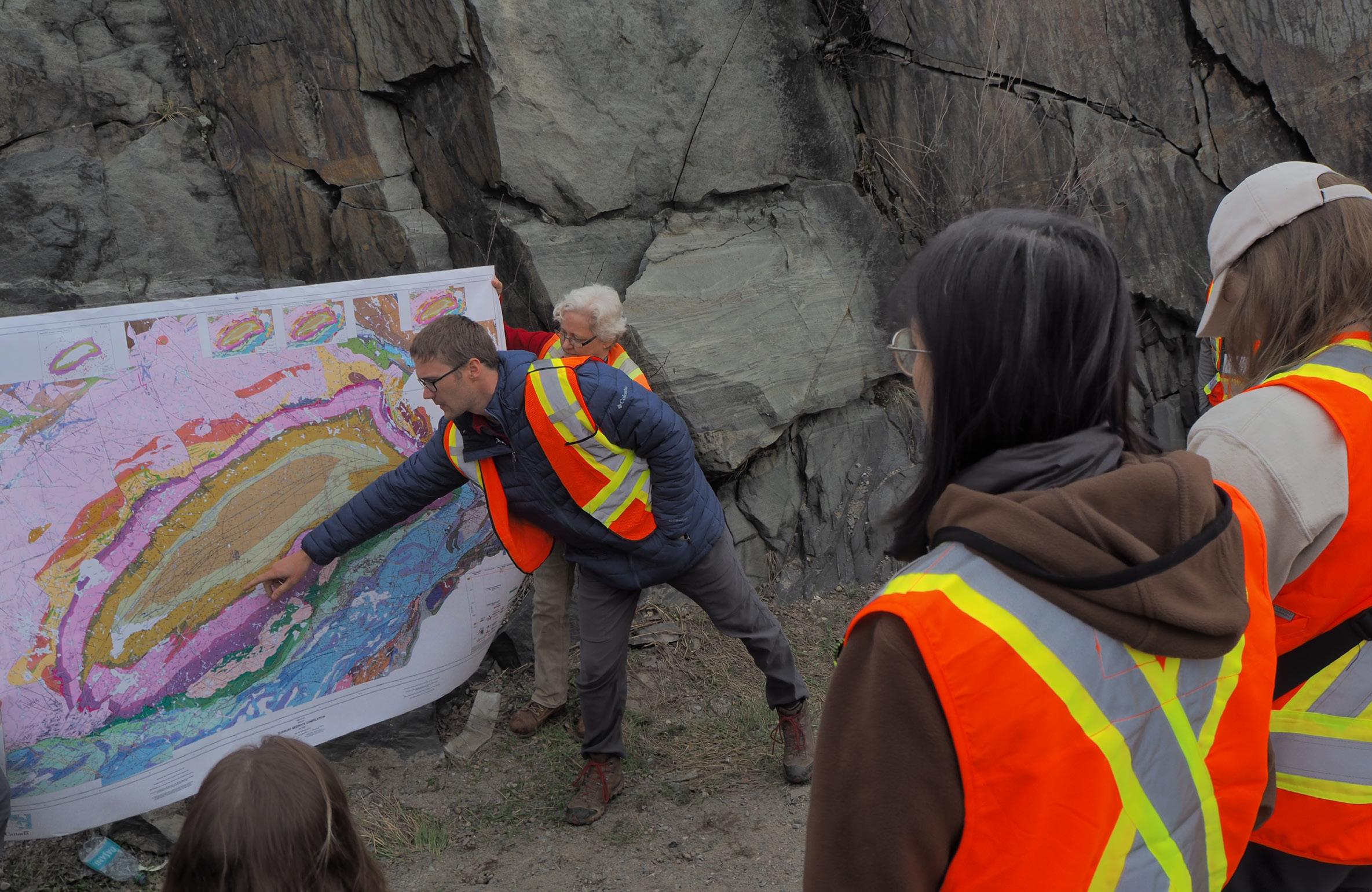
| MAY 1, 2025
Brad Clarke, KGHM, with assistance from Shirley Peloquin, OGS, explains the turbidite beds in the Chelmsford Formation during the tour of the Sudbury Basin.
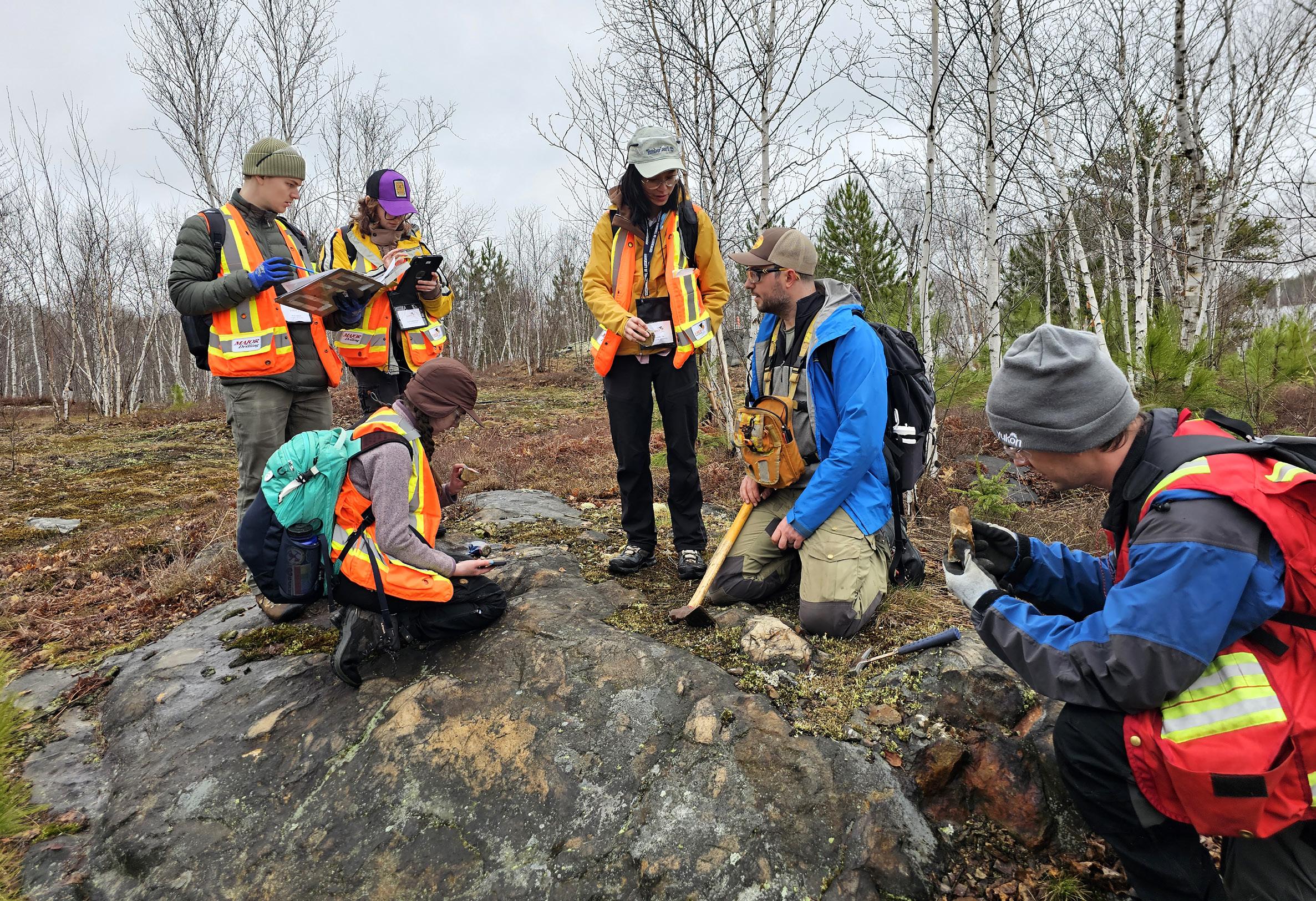
| MAY 2, 2025
Tom Gemmell, Ontario Geological Survey, demonstrates mapping techniques during Regional Mapping Day.
| MAY 3, 2025
Parke Fontaine, University of Calgary, Jacob Montenegro, University of Regina, Maria O'Neill, Memorial University of Newfoundland, and Karen Brookman, Acadia University, navigating through the snow while grid mapping during Exploration Mapping Day.
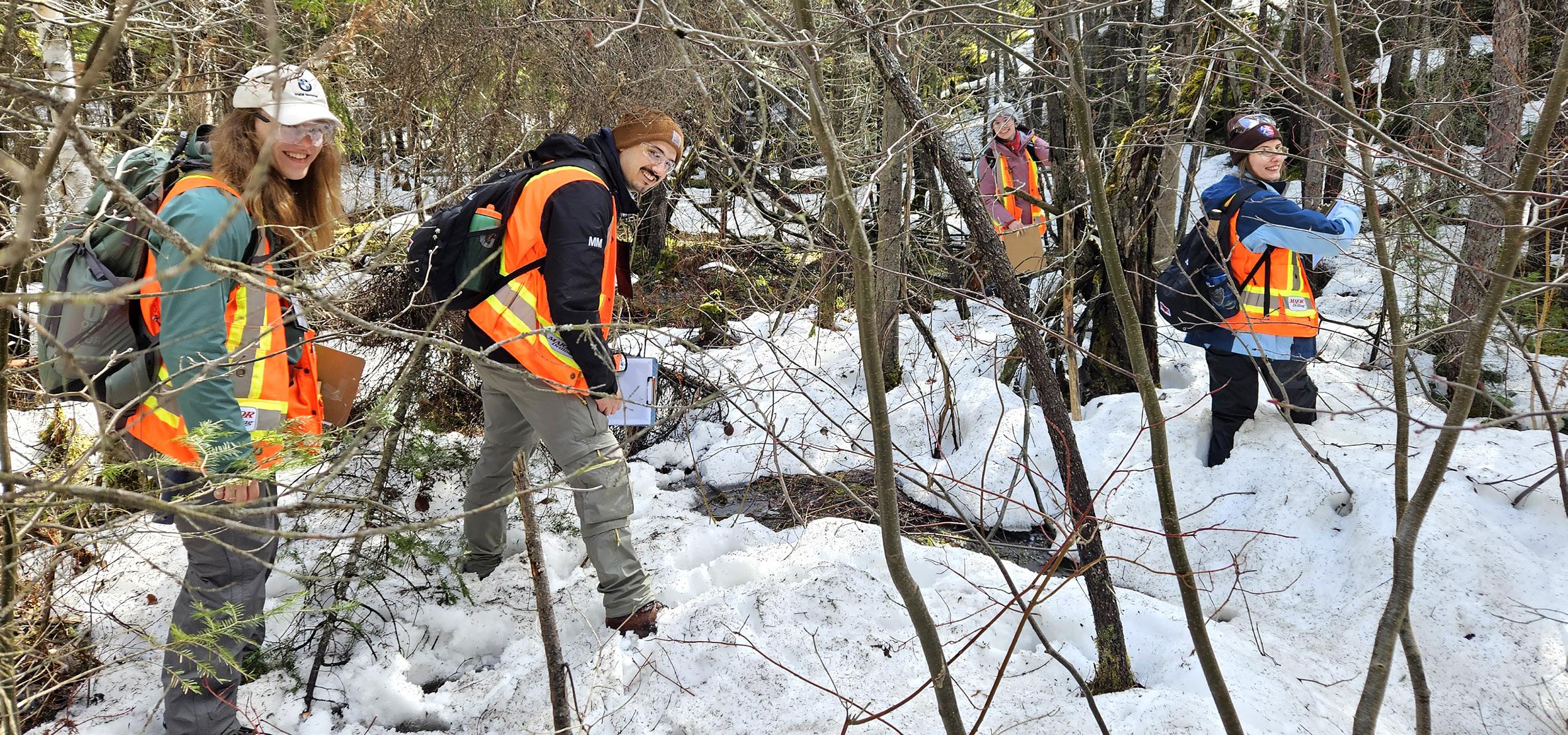
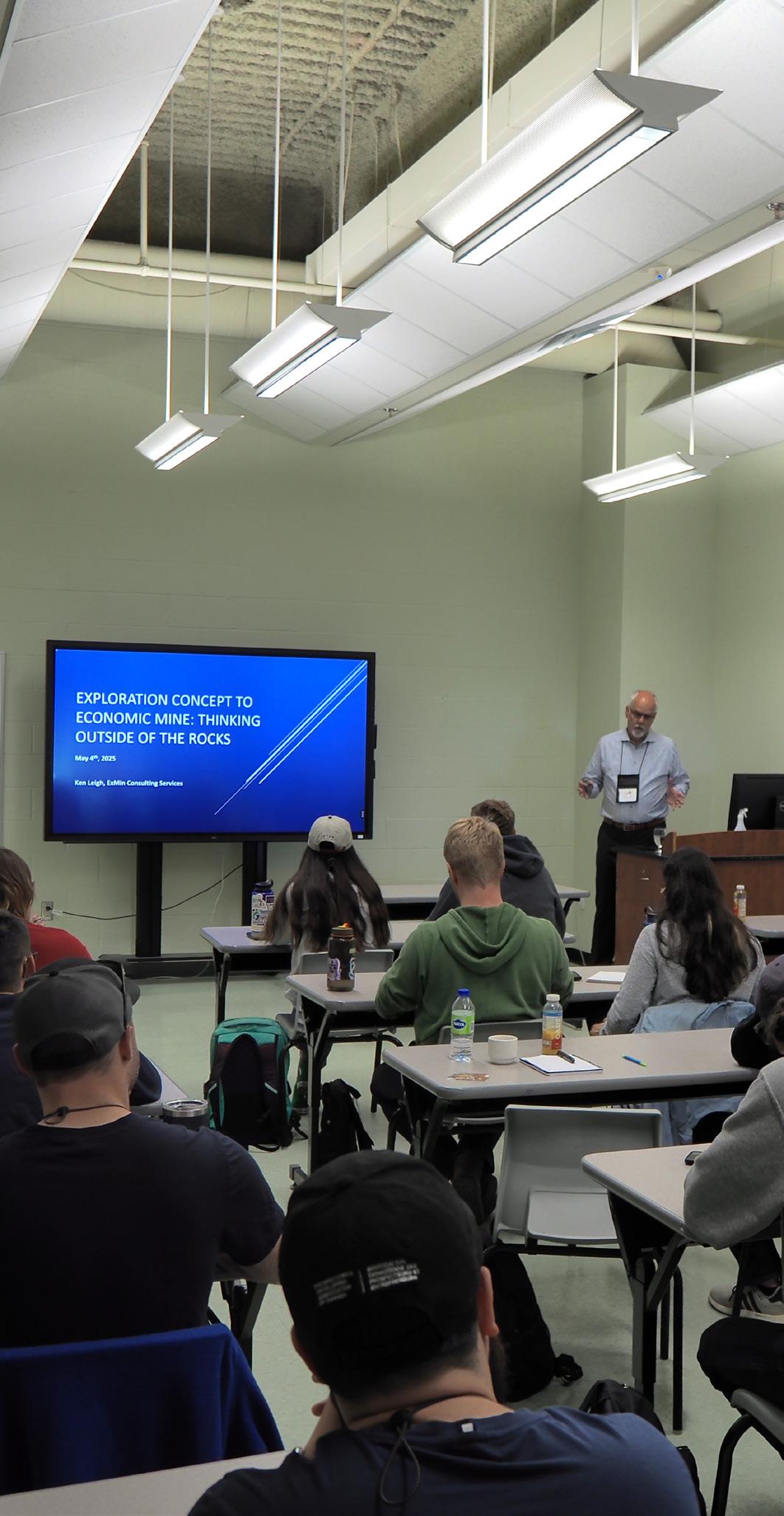
| MAY 4, 2025
Ken Leigh, ExMin Consulting Services, gets the students to “Think Outside of the Rocks” during his presentation on Exploration Concepts to Economic Mines during Exploration Industry: Key Drivers Day.
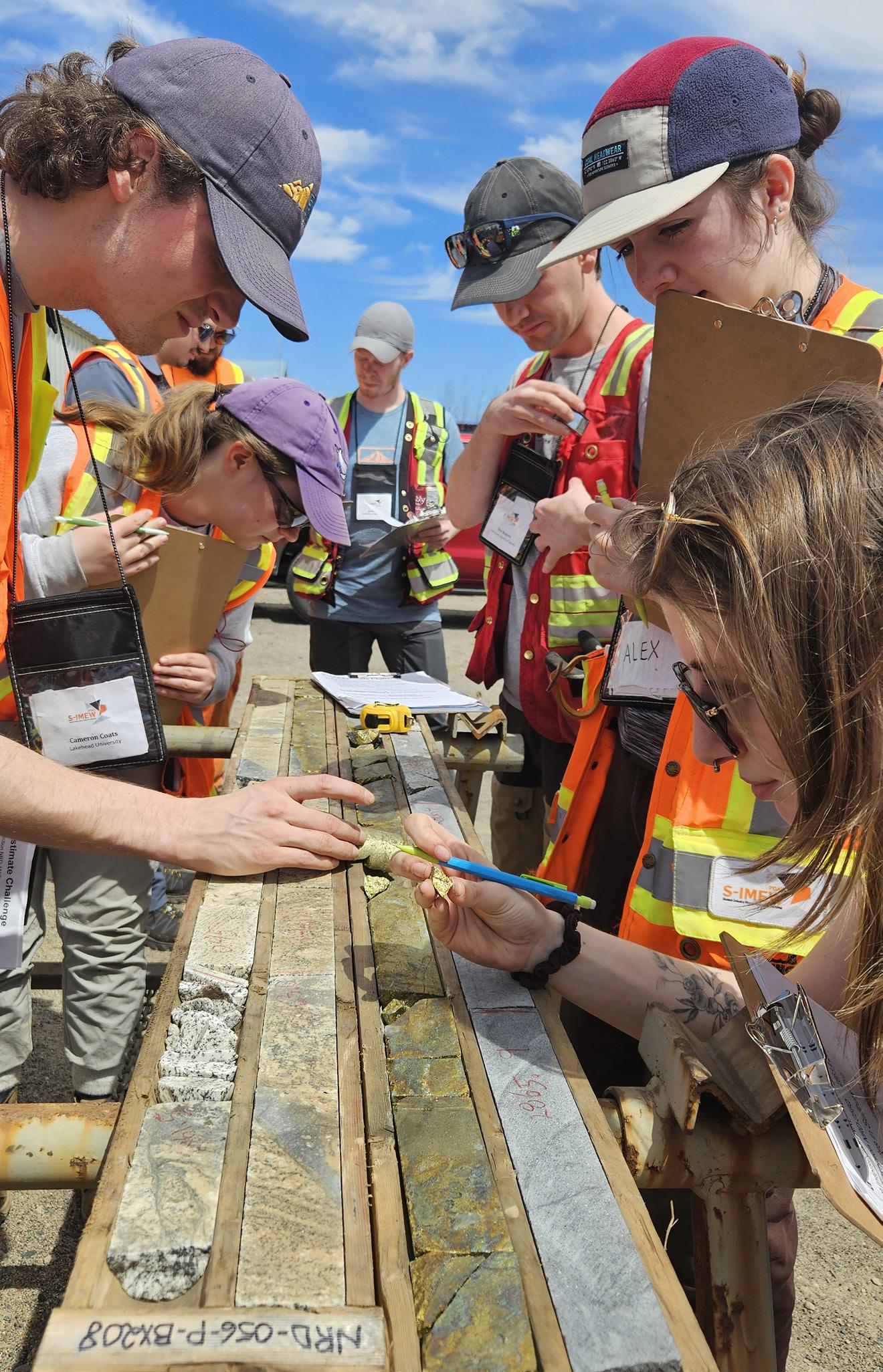
| MAY 5, 2025
Students take part in some friendly competition during a mineral estimation exercise with the Glencore exploration team.
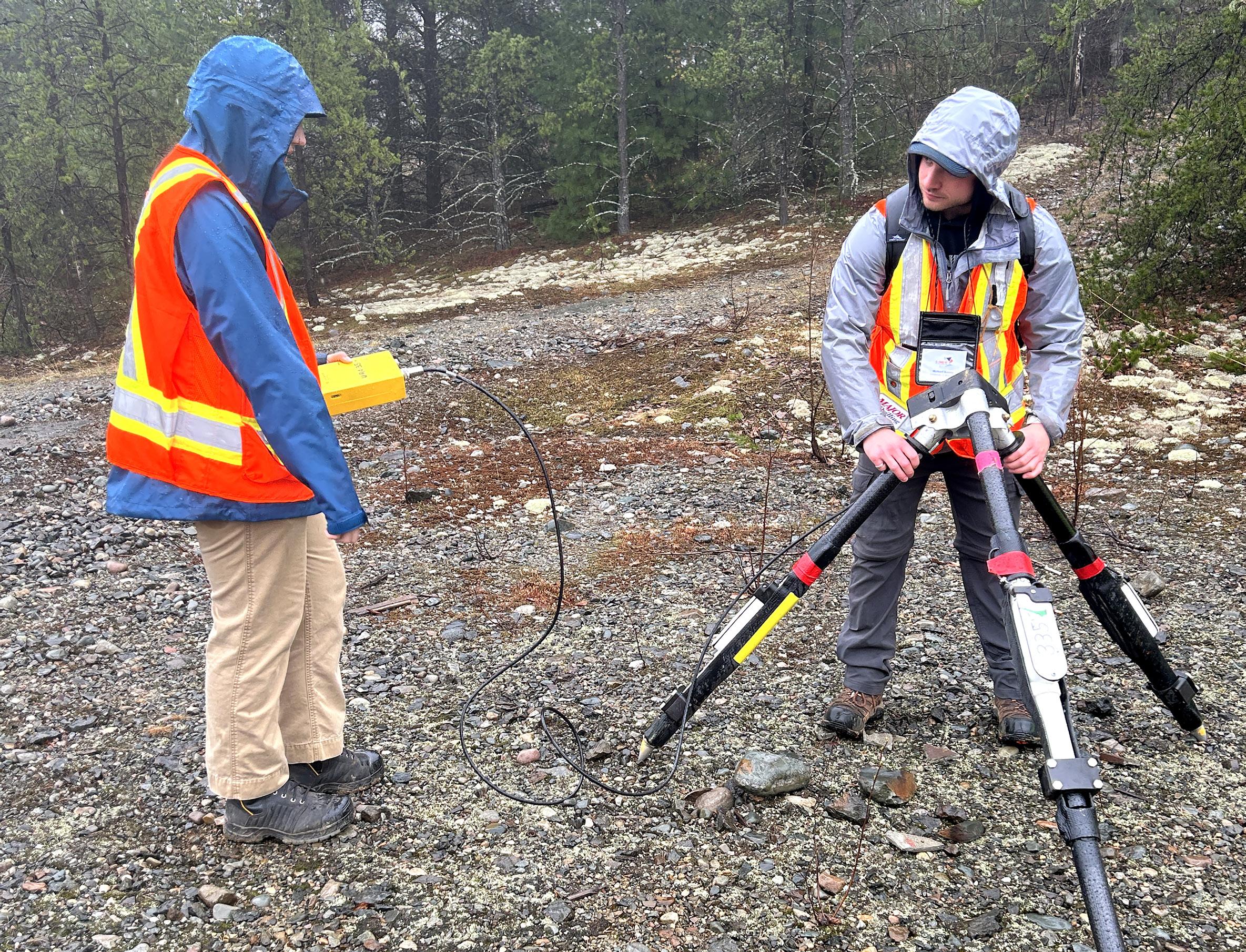
| MAY 6, 2025
Mike Ramey, University of Waterloo, and Madison Dean, University of British Columbia, Okanagan, participate in an electromagnetic survey demonstration with Vale during Geophysics Day.
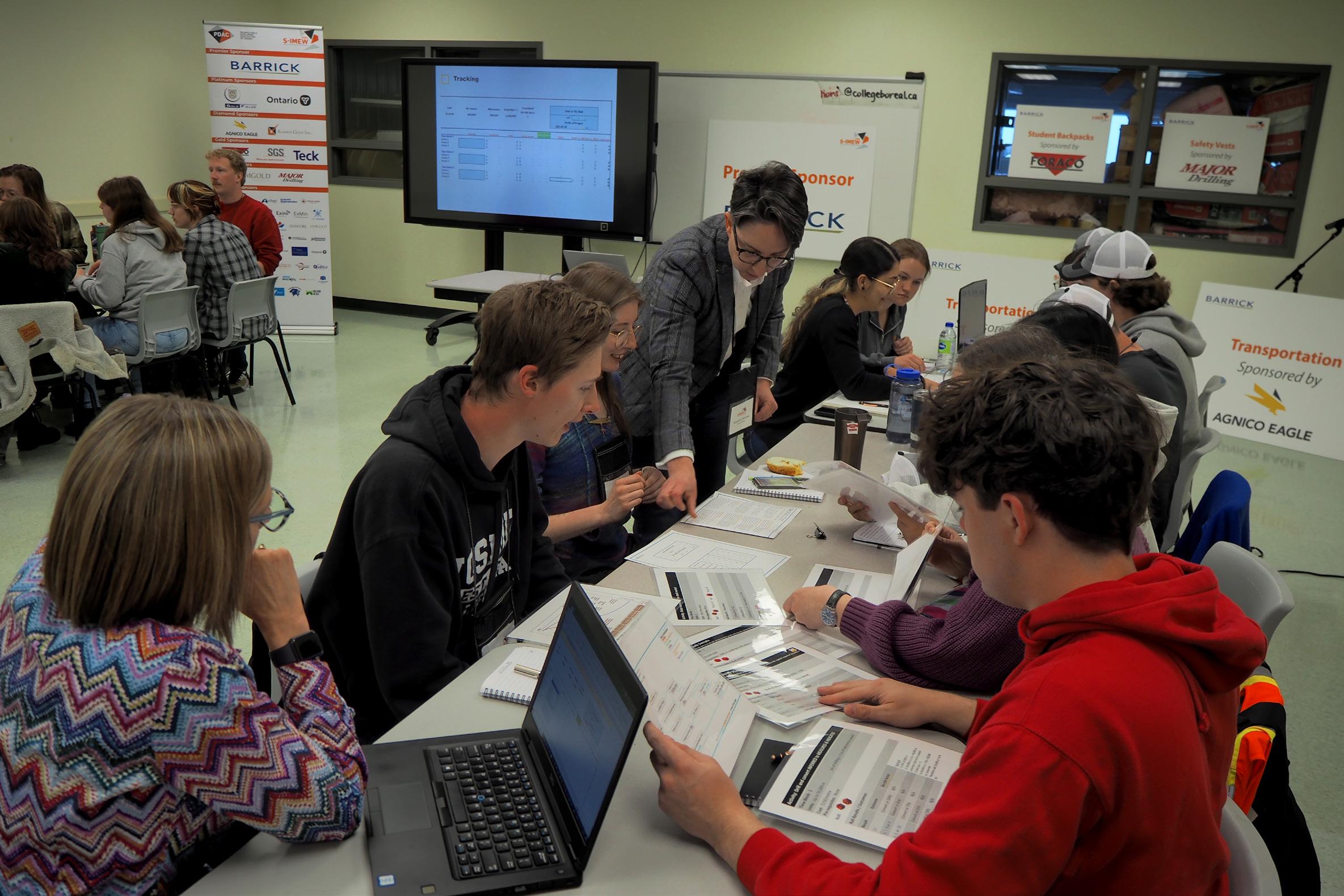
| MAY 7, 2025
Alexandria Marcotte, Osisko Metals, guides a group of students as they work through an exercise to derisk an exploration project during Responsible Exploration Day.

| MAY 8, 2025
Students examining core samples at the Kidd Creek Core Shack.
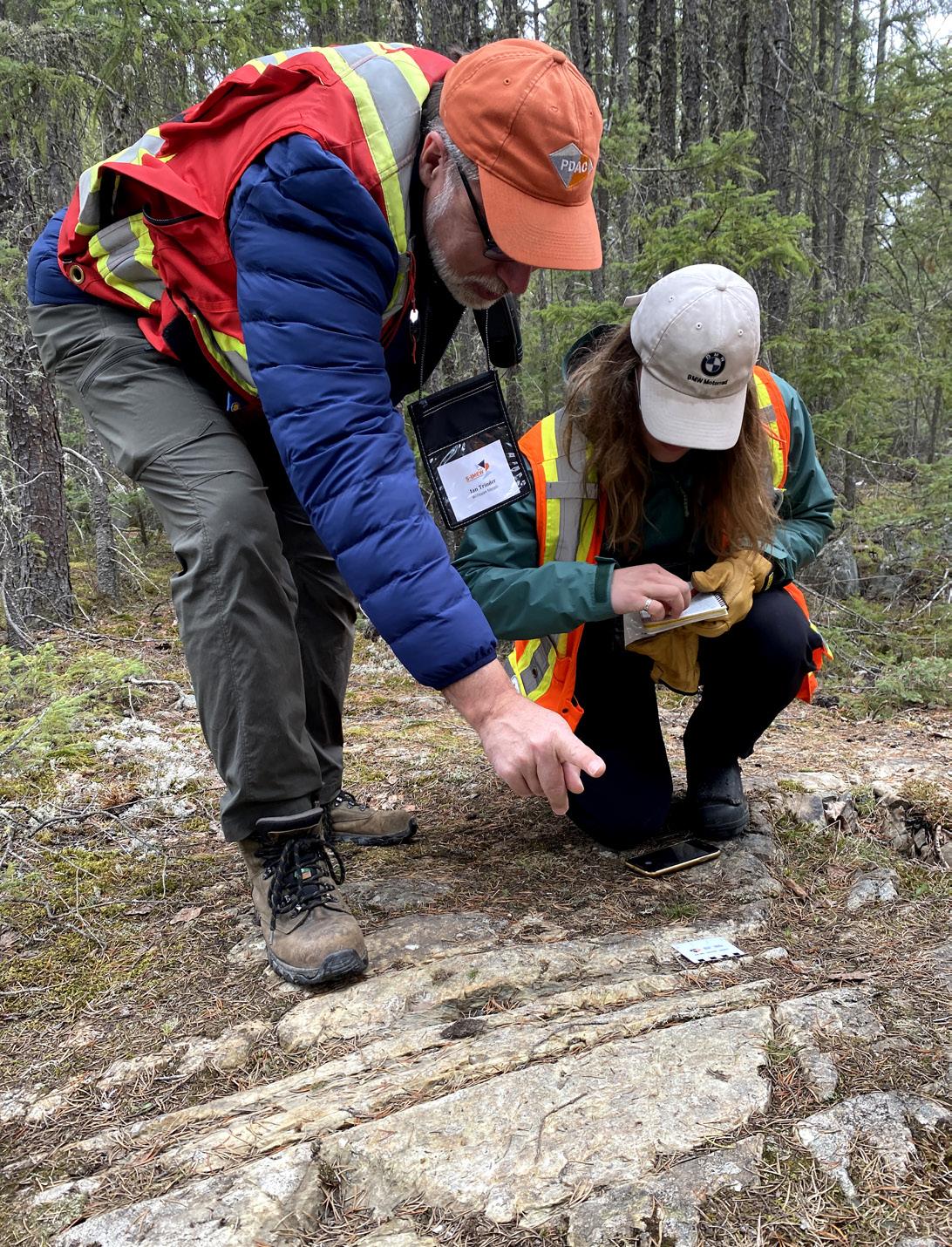
| MAY 9, 2025
A group of students learn about the role of the Mine Geologist while underground at the Timmins West Mine.
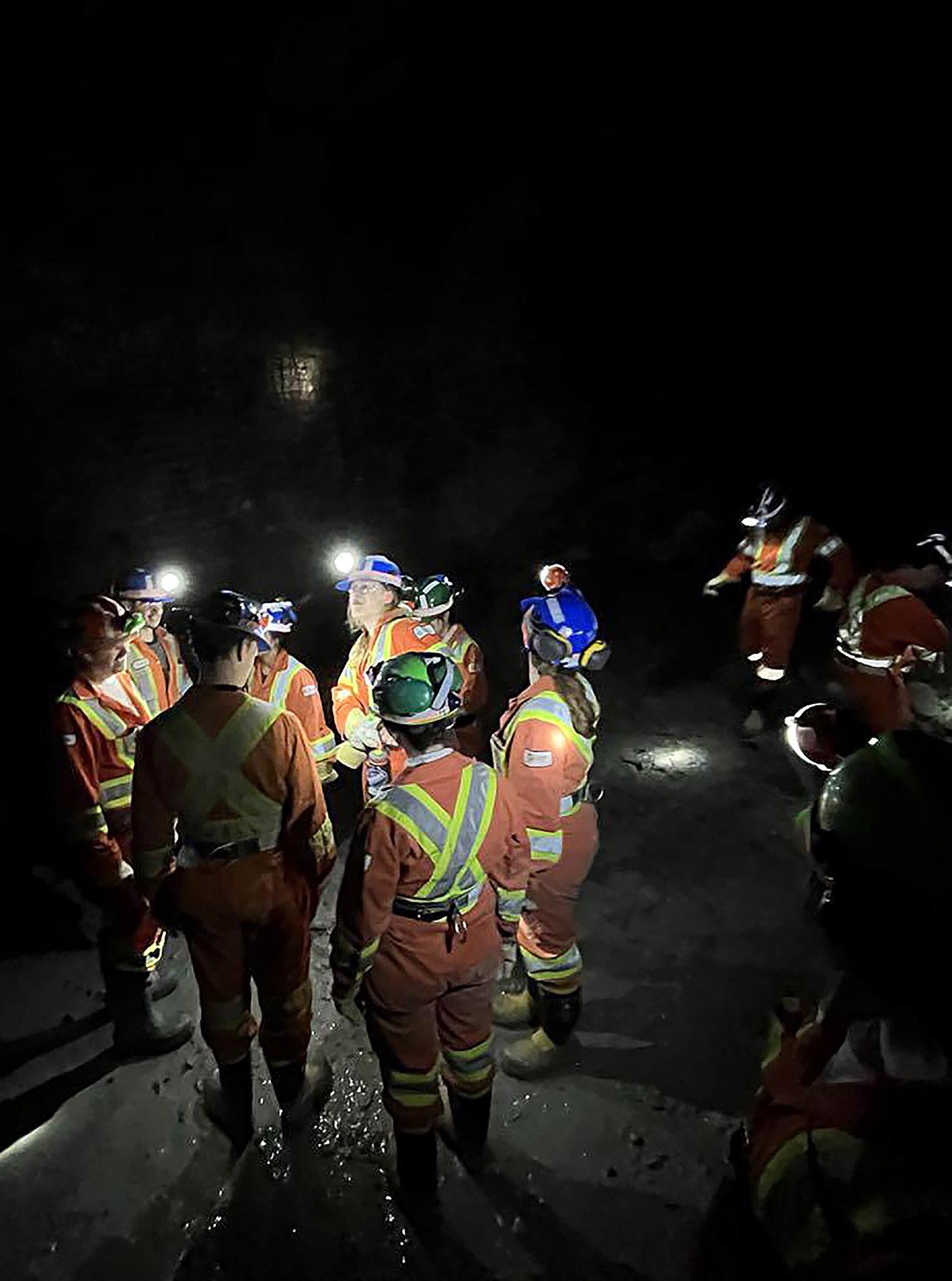
| MAY 11, 2025
Students explore the Nipissing Hill outcrop in Cobalt, Ontario.
| MAY 10, 2025
Ian Trinder, Willeson Metals, and Parke Fontaine, University of Calgary, look at an outcrop of the Krist Formation during a tour of the Timmins regional geology.
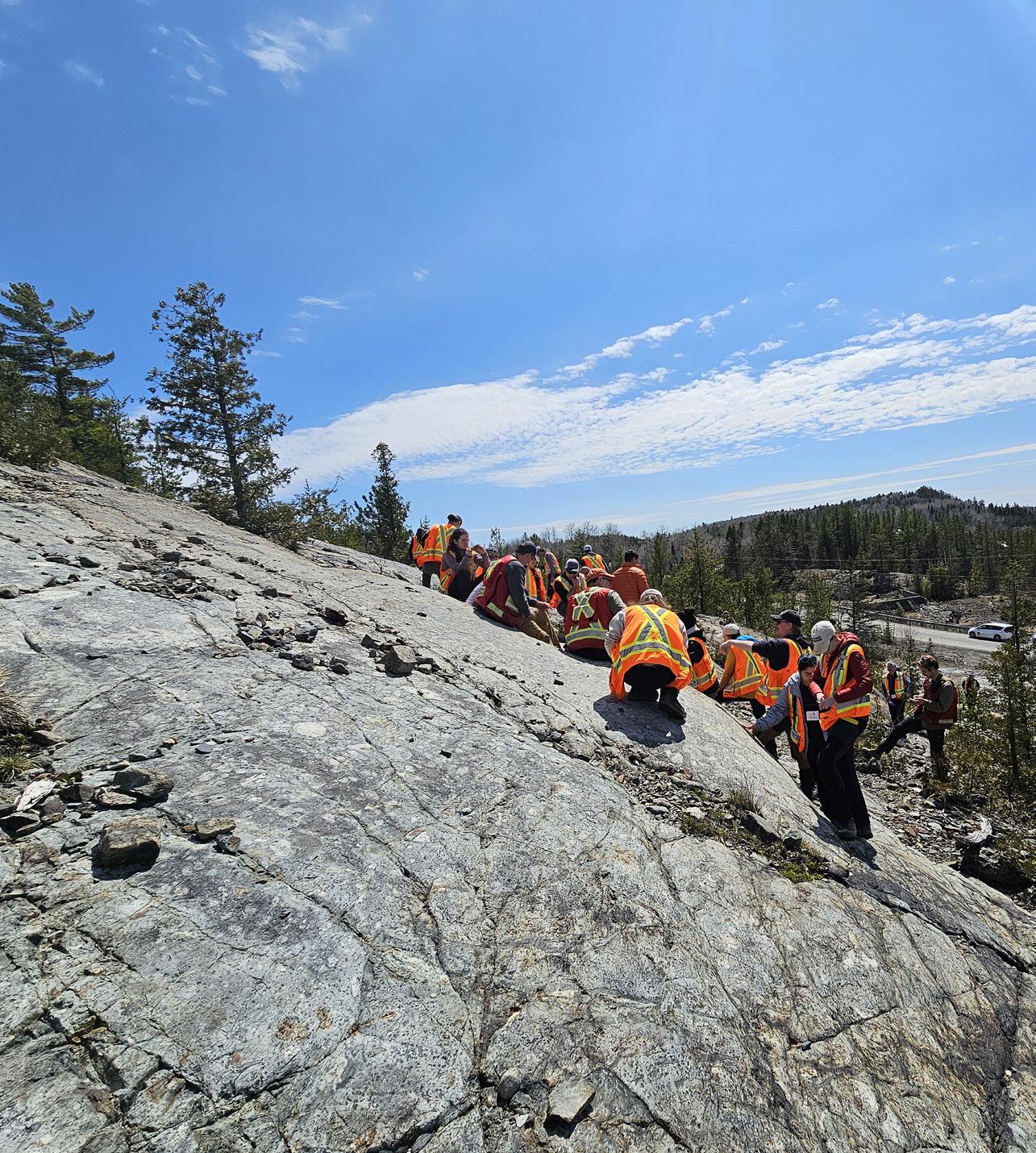
| MAY 12, 2025
Grant Hagedorn, Ontario Geological Survey, encourages the students to get their hands dirty during a till sampling demonstration during Geochemistry Day.
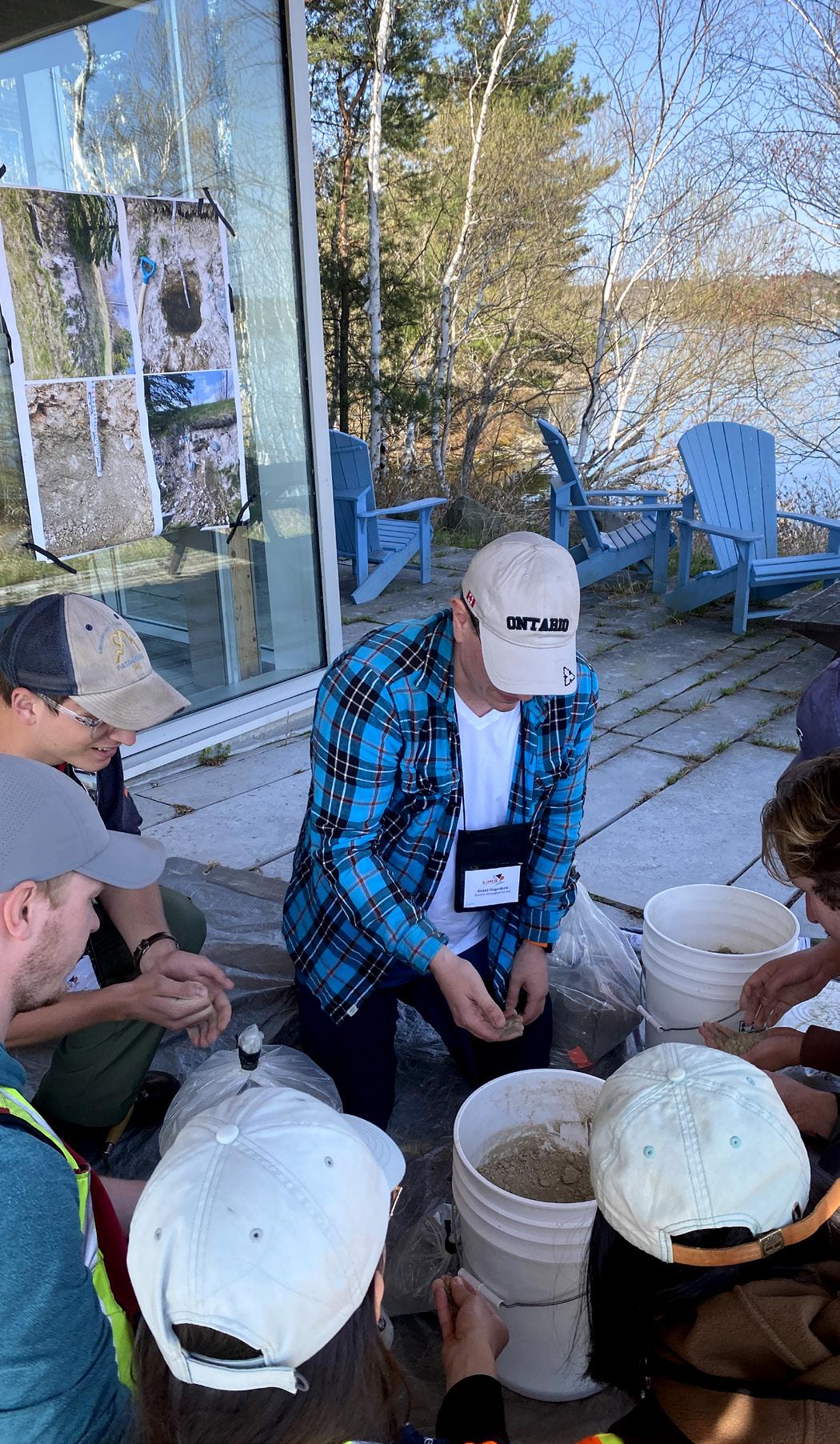
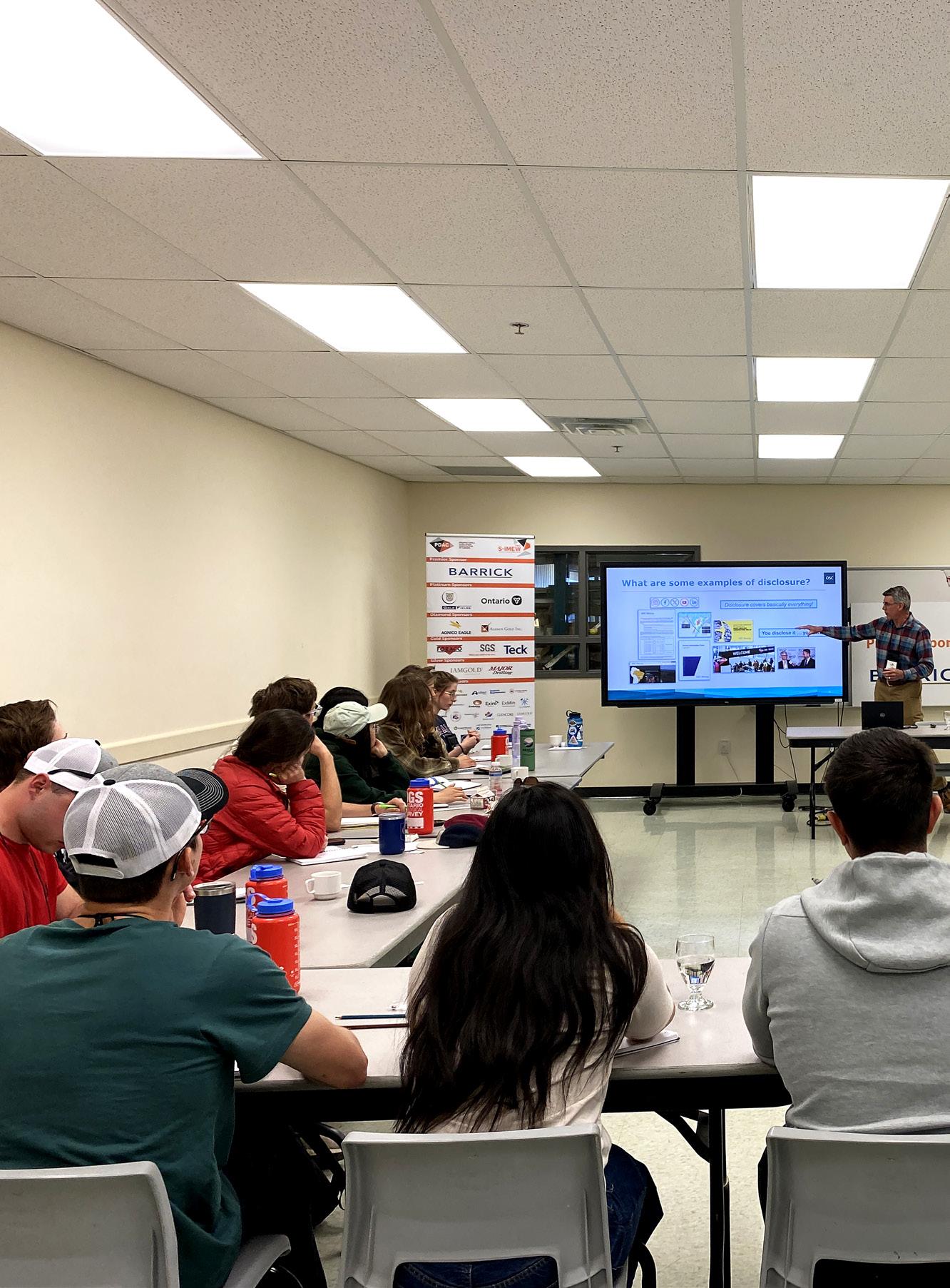
| MAY 13, 2025
Craig Waldie, Ontario Securities Commission, leads the students through all things NI 43-101 during Professional Responsibility Day.
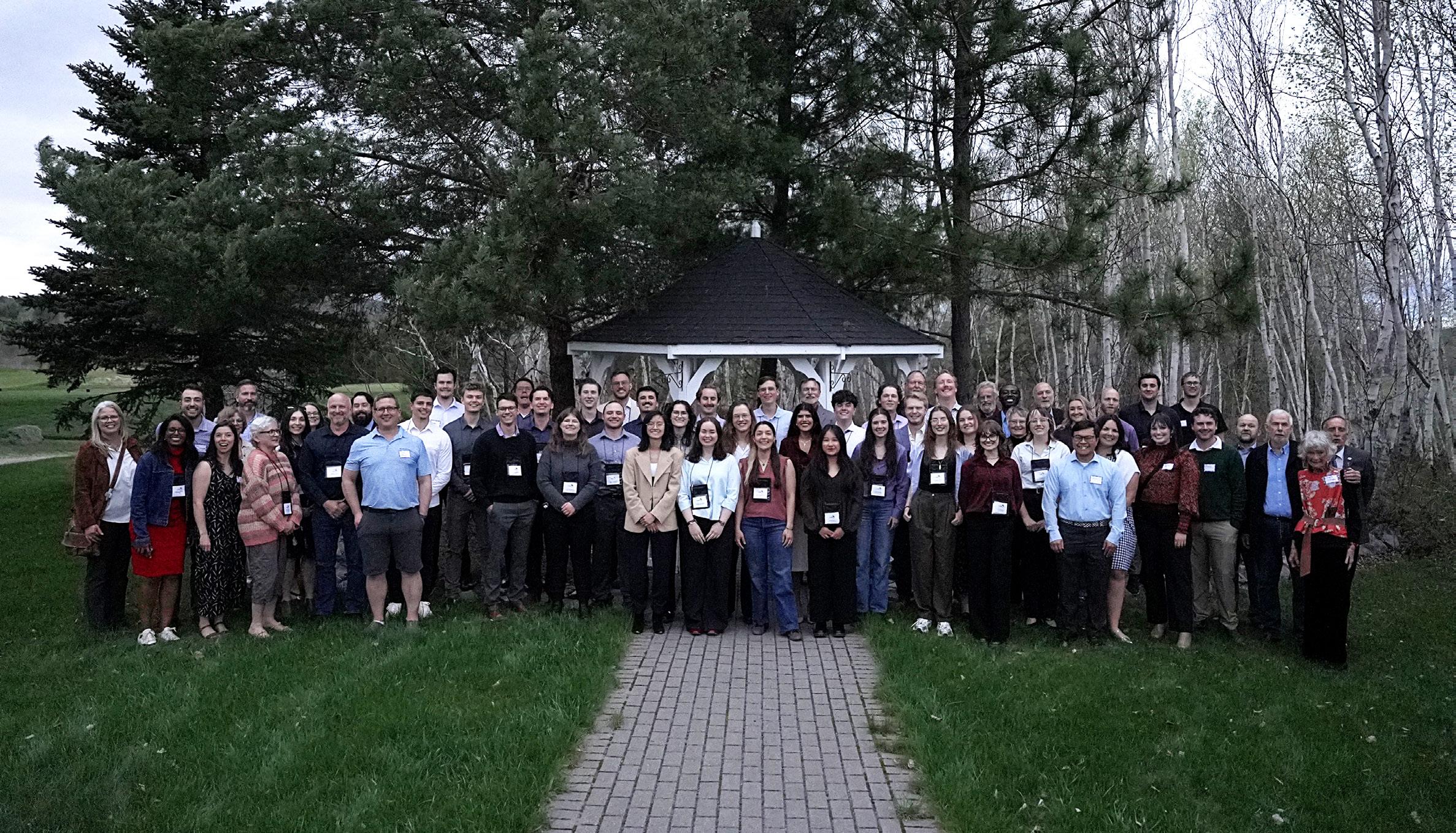
| MAY 14, 2025
The 2025 student cohort celebrates the completion of S-IMEW with industry partners and volunteers during the Finale at the Timberwolf Golf Course.
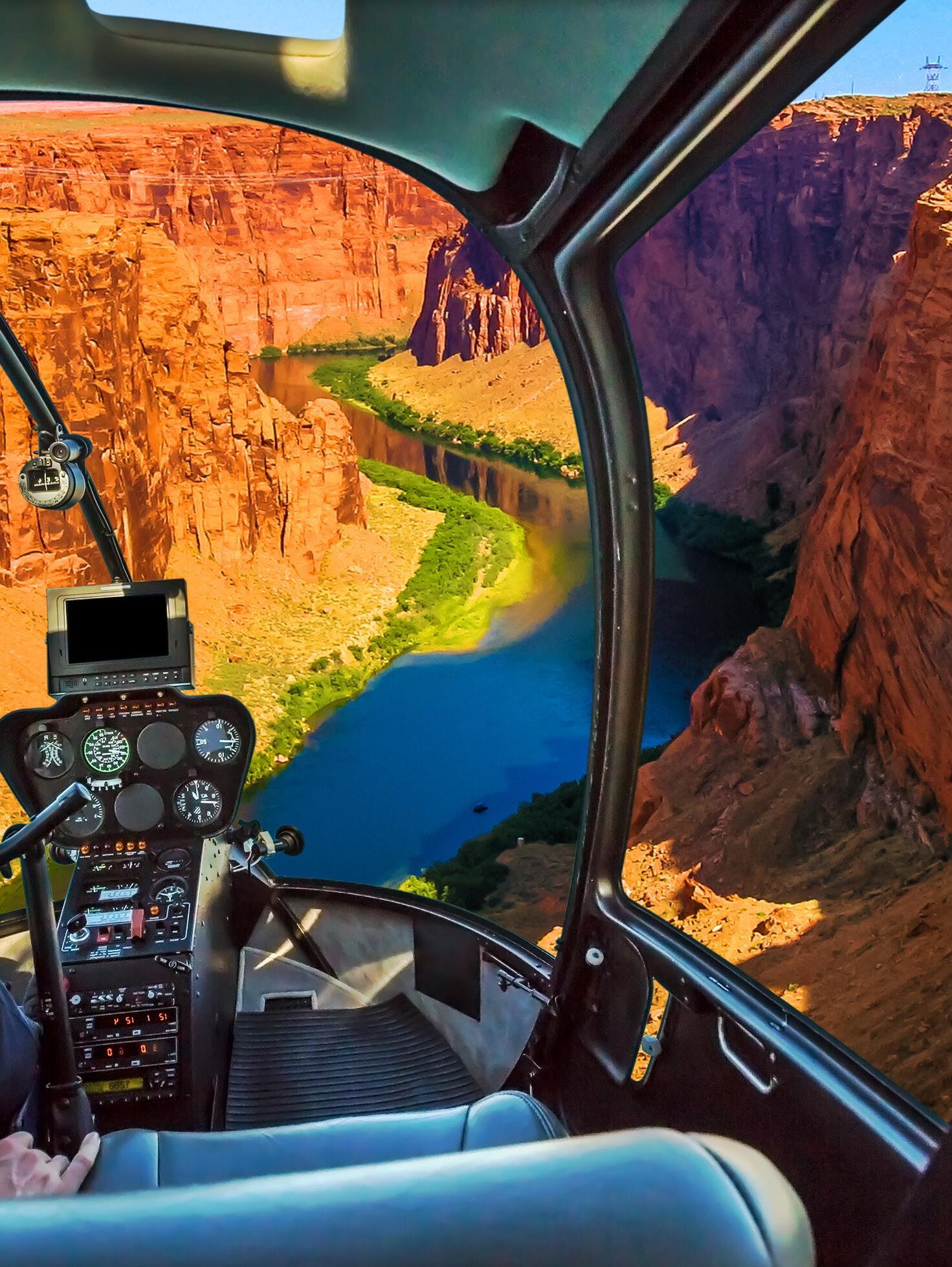
Over the last two years, global trade, industries, supply chains and capital markets have faced levels of uncertainty not experienced in generations – which the mineral industry and its financing ecosystem has not been immune to.
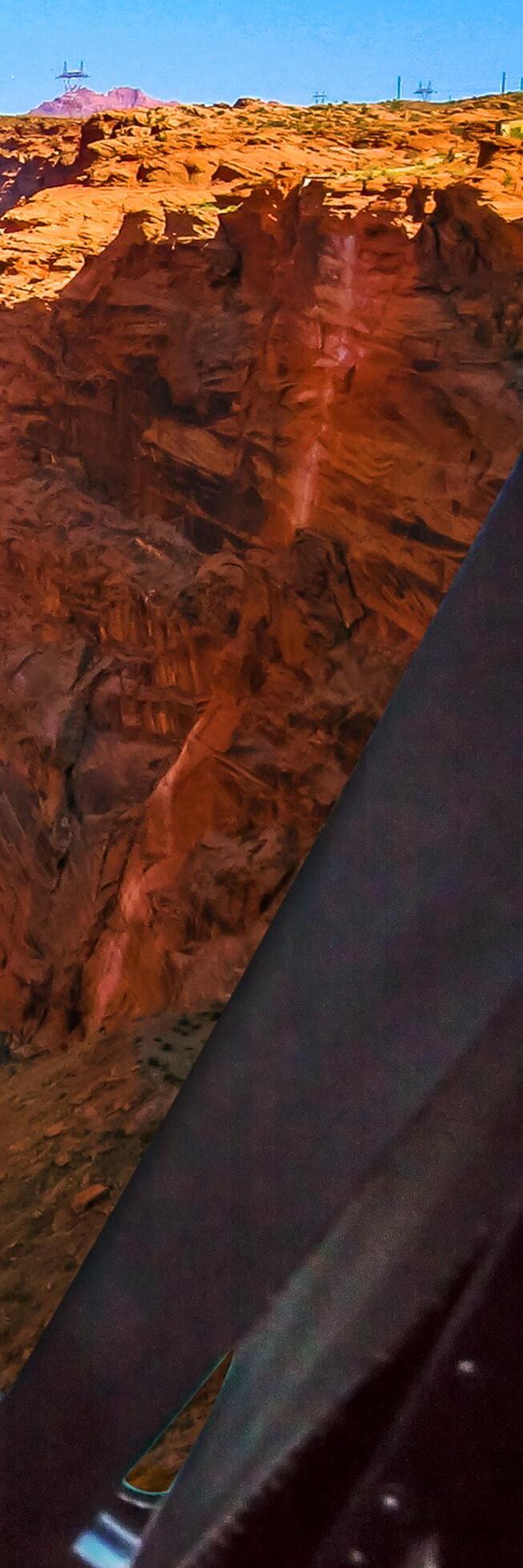
The uncertainties in the broader marketplace have translated directly to commodities, as highlighted in Figure 1 below, with notable divergence in price trends during 2024 and early into 2025. The price of gold climbed steadily throughout 2024, and continued its upward trajectory in the first half of 2025 to establish new all-time highs. This was reflective of the sustained macroeconomic uncertainty, inflation hedging, and strong central bank demands from a handful of nations. In contrast, most base metals either stagnated, or declined, weighed down by weaker-than-expected industrial demands, as well as concerns for global economic growth.
From a Canadian perspective, the accelerating gold price has actually helped to bolster an otherwise weak financing environment, as most new issuances in 2024 were in the gold sector. Without this robust factor, we would likely have seen total investments into the mineral industry flat at best, and possibly tail off materially from 2023 levels.
Global equity investment in the mineral sector saw a modest year-over-year (YOY) uptick in 2024. However, as illustrated in Figure 2 on the next page, it marked the third consecutive year of financing levels remaining
significantly below both 2021 and pre-2018 benchmarks – underscoring a prolonged contraction in capital market activity for the mineral industry.
Amid this global stagnation, however, Canada stood out with total equity raises surging by approximately 45% YOY. This resurgence propelled the country back to the forefront as the top mine-finance destination, reclaiming the lead from Australia – which previously had taken the top spot from Canada in 2019.
Reviewing the domestic landscape, the proportion of dollars that mineral issuers raised versus total equity raised on Canadian exchanges leaped from an average of 16 per cent per year from 2012-2021, to a 37 per cent average per year over the past three years. In fact, through 2024 and the first half of 2025, mineral issuers topped 50 per cent of all equity dollars raised in Canada – a reflection of the mining sector’s growing dominance in a sharply shrinking domestic marketplace.
Over the past three years, the total equity raised by all Canadian issuers – with all sectors including mining and exploration – averaged C$23 billion, which is less than half of the C$50 billion average over the previous decade (Figure 3).
ANNUAL AVERAGE | 2012-2021
ANNUAL AVERAGE | 2022-2024
To underscore this decline, in 2009 alone Canadian mineral companies raised more capital than the entire TSX and TSXV combined across all sectors in 2024. While the mining industry's expanding share of the market may appear encouraging, it also highlights an increasingly concentrated – and fragile – capital raising environment.
On a closer examination of the financing landscape, a review of equity financing in the TSX and TSXV which has been disaggregated by market capitalization (illustrated in Figures 4A & 4B below) reveals that over the past several years, companies with market capitalizations below C$100 million (as of April 2025: 861 companies, or 80 per cent of issuers; primarily juniors and early-stage explorers) have steadily represented a smaller and
smaller portion of financing activity. In contrast, issuers with larger market capitalizations have captured an increasing share of the available dollars, concentrating available investment funds towards the upper end of the market. This persistent decline among sub-$100 million market cap companies highlights the structural funding challenges facing grassroots exploration and early-stage development organizations, despite overall increases in sector-wide equity totals.
Figure 5 on the next page outlines how a substantial portion of capital raised in recent years has been concentrated in a small number of large transactions. Excluding the top 50 deals – which account for less than 4 per cent of the approximately 1,350 mineral financing transactions completed annually –the data show that the 2024 uptick in financing was driven entirely by an increase in capital raised through these top 50 transactions. Conversely, equity raised through the remaining transactions stagnated – underscoring the widening gap between major players and the broader market.
To
address the persistent capital challenges facing the mineral sector – and to support Canada’s energy transition and economic growth – PDAC is calling for several critical policy actions that are essential for enabling companies to explore, develop and build the next generation of Canadian mines.
First, we urge the Canadian Securities Administrators (CSA) to ensure that the upcoming revisions to National Instrument 43-101 prioritize the competitiveness of Canada’s financial markets relative to global peers. Regulatory updates must enable efficient capital raising for exploration and development companies.
Second, we call on the federal government to immediately renew the Mineral Exploration Tax Credit (METC), make it a more permanent fixture in the Canadian fiscal landscape, and fulfill the election commitments to strengthen mineral investment incentives.
These mineral investment incentives include:
| Broadening eligible activities under the Canadian Exploration Expense (CEE) rules to include costs related to technical studies—such as engineering, economic assessments, and feasibility studies.
| Amending the Clean Technology Manufacturing Investment Tax Credit to ensure it applies to polymetallic deposits, and to include mine development expenses at brownfield sites as eligible costs.
| Expanding the list of eligible minerals under the Critical Mineral Exploration Tax Credit (CMETC).
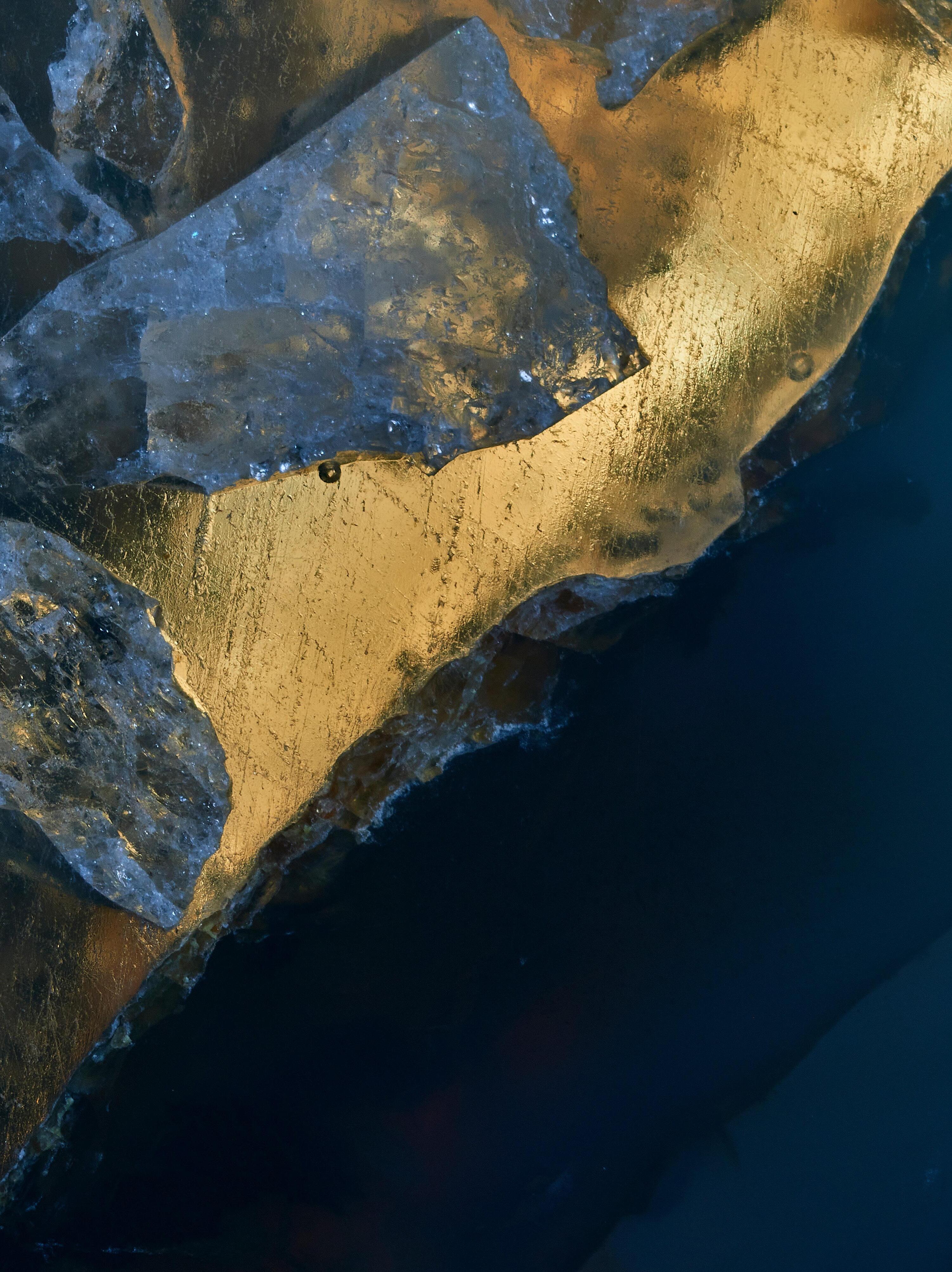
For more information on PDAC's financial advocacy programs, and how we endeavour to enhance the access to capital of the mineral exploration and development sector, visit pdac.ca/programs-and-advocacy.
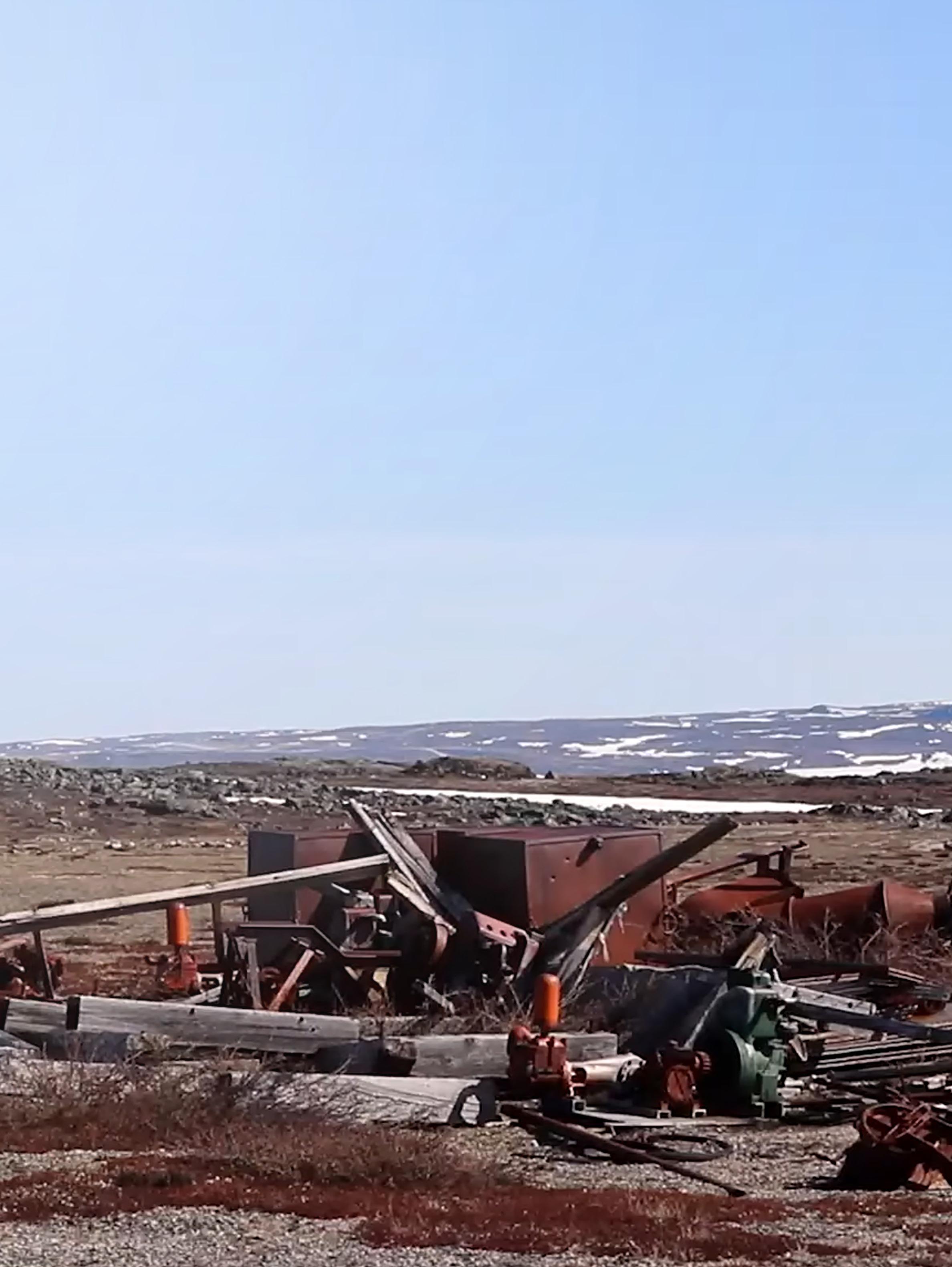
TWO PROJECTS IN QUÉBEC'S REMOTE NORTHERN REGION HAVE INSPIRED A NEW WAVE OF SUSTAINABILITY INITIATIVES

The 'Nunavik Abandoned Mineral Exploration Sites Restoration Project' and the 'Abandoned Exploration Sites Clean-Up Eeyou Istchee James Bay' project are two initiatives that highlight a growing trend of long-term sustainability partnerships between governments, communities, and private companies.
In 2005, planning began for a $7 million initiative in northern Québec that would involve close collaboration between the provincial government, private exploration companies, Indigenous communities and individuals. The Nunavik Abandoned Mineral Exploration Sites Restoration Project had an impressive goal: to clean up exploration sites in Québec's northern territory that had been abandoned half a century ago, and return the land to a satisfactory state.
The funding for this large-scale sustainability effort came from a $4.1 million investment from the province's Ministère des Ressources naturelles et des Forêts (MRNF), a $1.6 million investment from Fonds RestorAction Nunavik (FRAN), and additional contributions from around 30 mining and exploration companies. The Gouvernement du Québec worked closely with the Kativik Regional Government to manage and coordinate the cleanup of sites that were identified as needing reclamation.
In the beginning, around 90 abandoned sites were identified for surveying. Each site was identified through a lengthy process that included helicopter surveys, ground assessments, and the involvement of Indigenous communities and individuals who were able to report the locations of abandoned sites on their lands. When this process was complete, 125 sites in Nunavik were assessed. After the identification process was complete, the sites were assessed to determine if there were hazardous materials present that required
remediation, or 'simply' debris present for cleanup and removal. Hazardous materials (such as old batteries and machine fuel) were sealed in airtight and waterproof drums, then shipped by the Kativik Regional Government to dedicated hazardous waste processing facilities in southern Quebéc. Nonhazardous debris was collected into containers and transported to facilities for disposal. Additionally, wherever possible, heavy equipment and materials were broken down and brought to recycling plants.
Many of these sites were abandoned decades ago, and some date back over half a century. The actual cleanup process began in 2007, and by 2022 the initiative removed hundreds of thousands of kilograms of waste material from over 100 sites in Nunavik. This included 10,753 barrels, 548 propane cylinders, 71 pieces of equipment, 101 batteries, tires, transformers and more.
On top of the land reclamation, it was also an important goal for the project to see that all work was completed with local resources. The investments and collaboration between the provincial government and mining companies was not only instrumental for helping reclaim the environment, but was also in the creation of jobs for local communities. For the 15 years that the initiative was active, Nunavik communities received various economic benefits that included the creation of 336 new jobs in Kangiqsualujjuaq, Kuujjuaq, Kangirsuk, Aupaluk, Tasiujaq, Salluit, Kangiqsujuaq, Kuujjuaraapik, Kawawachikamach and other areas.
The cleanup effort was not without its challenges, however, as the sites are primarily located in remote areas of Québec's northern territory. As the areas were not largely accessible by truck, most of the remediation had to be done by helicopter transport. It is estimated that around 350 trips were completed, representing 700 hours of flight time, as each trip was typically an hour in each direction.
The remoteness of the sites also made it a challenge for acquiring personnel to work at the project sites – a challenge that, at times, left crews shorthanded for days. The weather provided additional hurdles as well, as there was only a small window of time
available to work on the sites around the winter. The benefits far outweighed the challenges, however. With the economic boost for the communities involved, the seasonal work and experiences gained by local workers, and the environmental impact made to the entire region, it was a net positive initiative.
It was because of this success that the Nunavik Abandoned Mineral Exploration Sites Restoration Project was awarded The 2007 Environmental Excellence Award for mineral exploration in Québec, and the 2008 Environmental Excellence Award for mineral exploration in Canada. The collaborative efforts of the parties involved – including the Kativik Regional Government (KRG), the Restor-Action Nunavik fund, the Gouvernement du Québec, the Makivvik organization, local communities and private industry stakeholders – became an inspiration for similar projects to begin in other regions of Québec, as well as other provinces.
One such project is the Abandoned Exploration Sites Clean-Up Eeyou Istchee James Bay initiative, which is currently active. Similar to how the completed Nunavik project began, communities in the Cree territory of Eeyou Istchee region of James Bay in northern Québec voiced concerns about waste left behind by past exploration and mining activity on their lands. One example of these abandoned sites having major negative environmental impacts is an area southeast of Whapmagoostui. This was the traditional hunting grounds ("trapline") for John Rupert's family, who had used the traditional trapline for generations. But in 2006, an exploration camp was set up on the site, and after just two years of operations, the camp was abandoned, with hundreds of barrels of fuel and propane tanks, dozens of temporary cabins, heavy machinery, appliances and other debris left behind.
With an estimated 500 sites identified as potentially needing cleanup, the Québec and Cree Nation governments, together with the
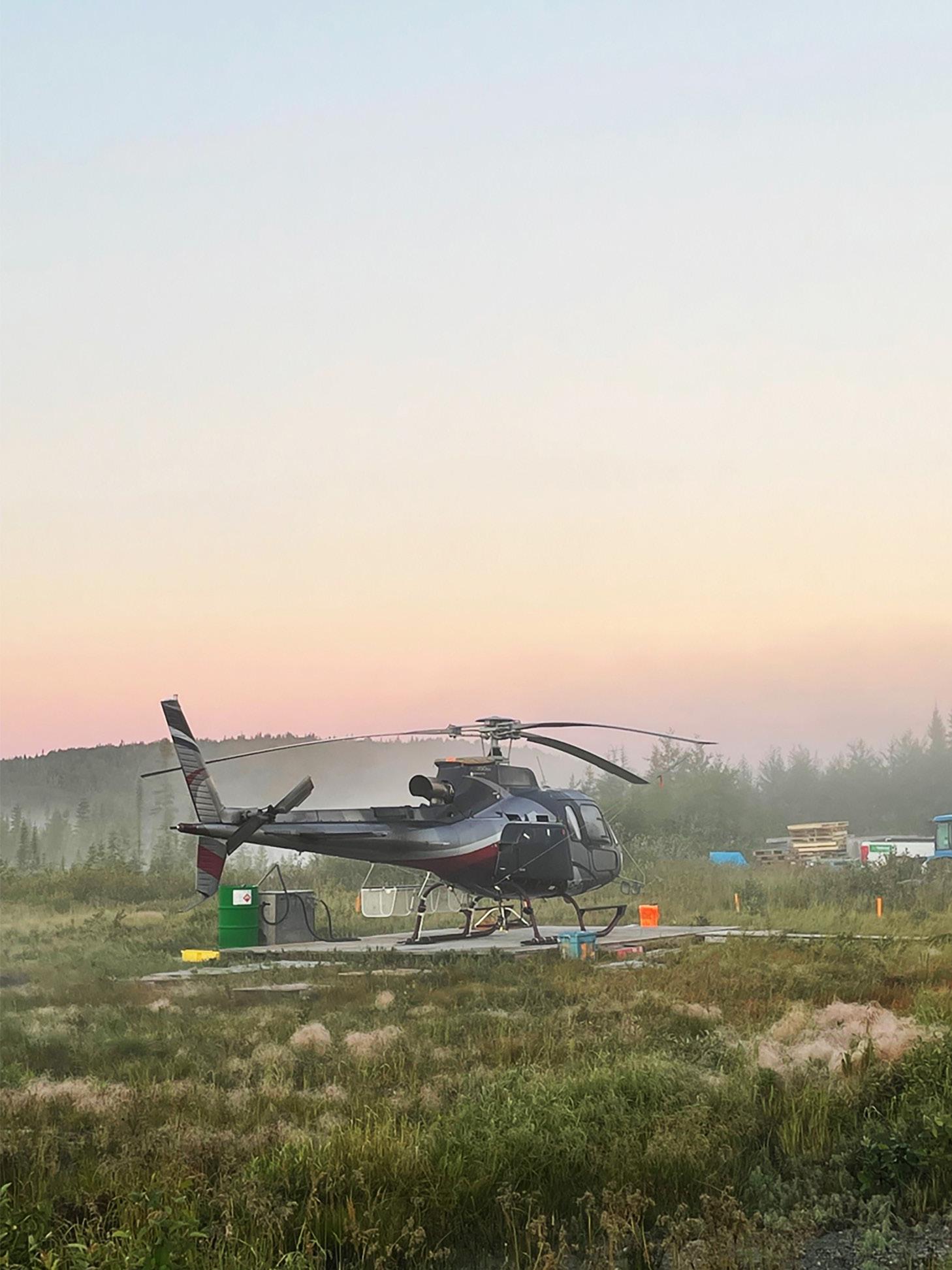
PDAC was proud to support the Nunavik Abandoned Mineral Exploration Sites
Restoration Project and the Abandoned Exploration Sites
Clean-Up Eeyou Istchee
James Bay Project through financial contributions.
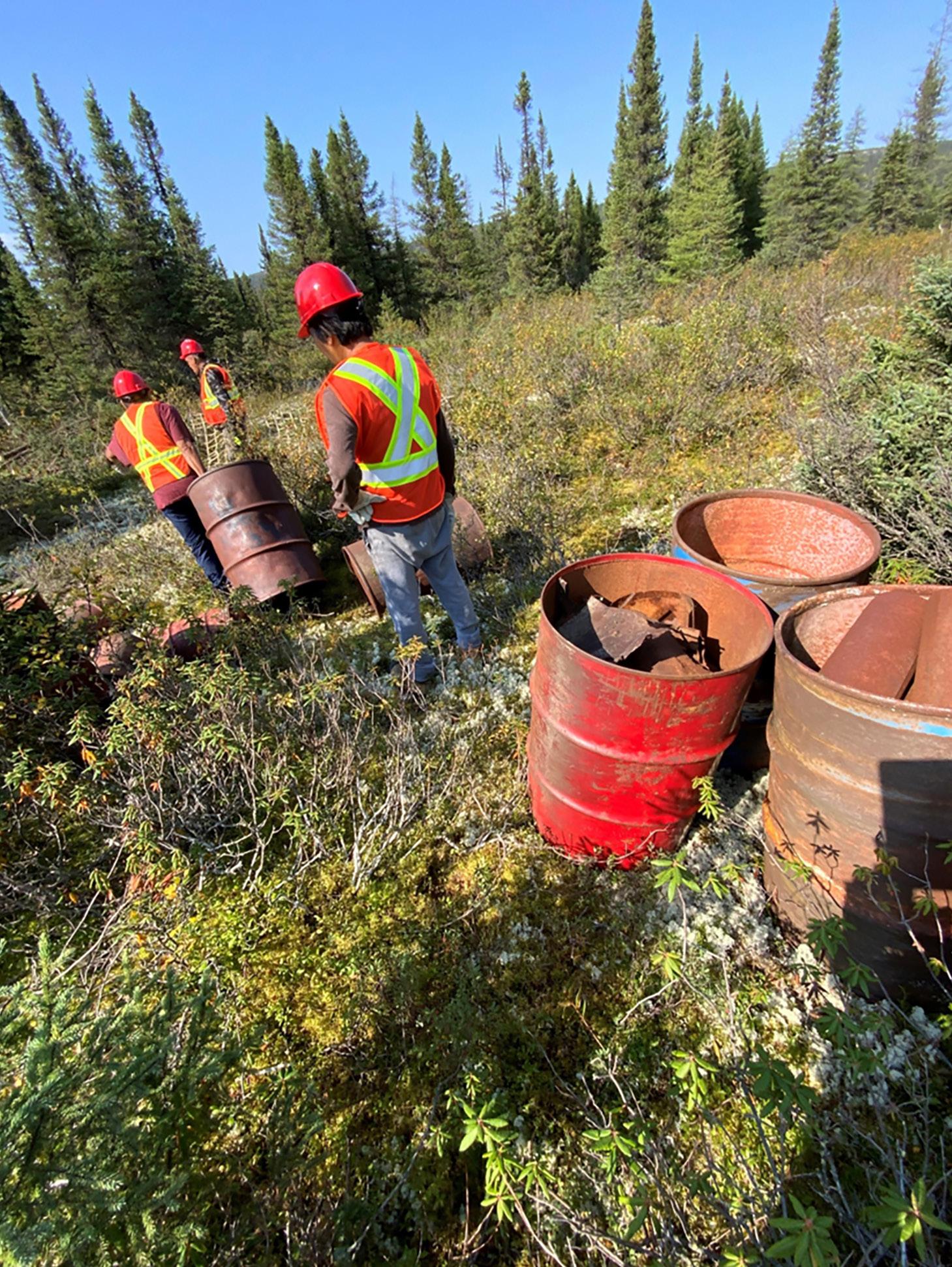
The success of this collaboration underscores the opportunity for the mineral exploration sector to continue building strong, community-based partnerships.
Eeyou-Istchee James Bay regional government and the mining industry signed an $11 million agreement in 2018 to improve the affected areas. The provincial funds were allocated from the Ministère des Ressources naturelles et des Forêts , and with an additional $300,000 contribution from the Fonds Restor-Action Cree (FRAC) – a mining industry group committed to helping clean up abandoned sites, who are also a part ner in the reclamation project.
In 2020, this four-party initiative set out to begin work that would clean the territories of the affected communities, and set an example for ESG best practices for the industry. Like the Nunavik project, however, this effort was met with unexpected challenges that delayed the project from beginning. The Covid pandemic forced the first delay, and then, in 2023, the major forest fires across northern Canada delayed the project even further.
It wasn't until 2024 that the initiative was able to start working on the largest site (John Rupert's trapline). Overseen by Adario Masty, Project Coordinator from the Cree Nation Government, the cleanup of the abandoned exploration camp left on the Rupert family's traditional hunting grounds will ensure that wildlife can return and thrive in the area, making it a sustainable region for future generations.
Representatives from the Fonds Restor-Action group presented this year at PDAC's convention in Toronto. As part of the Sustainability programming, the group led a session titled "A clean slate: Collaborative cleanup for mineral exploration sites," that engaged attendees and gave an update on the initiative. T he session included speakers Normand Champigny, Québec Precious Metals Corp, Fonds Restor-Action Cree, Bryan Atkinson, Fury Gold Mines Ltd., David Bradley, Forage RJLL Drilling, Adario Masty, Cree Nation Government, and Aurora Maria Hernandez, Cree Nation Government.
The speakers shared case studies from the project, and presented data that showed of the 500 sites initially identified, 64 have been
cleaned or do not require a followup, and more are in progress.
The Abandoned Exploration Sites Clean-Up Eeyou Istchee James Bay project is slated to be active until 2029, and in addition to the positive environmental impact it will have, it will also be a significant economic benefit for the Cree communities of the region. The project represents a decade of full-time employment for local workers, as well as long-term partnerships with the industry and government that will benefit the Indigenous communities into the future.
This strong collaboration between the parties involved is also a message to the mineral exploration sector – that becoming proactive land stewards and partners with Indigenous communities should be standard practice for all projects.
While today there exists legislation and bylaws governing exploration activity and mine site cleanup, both the Nunavik Abandoned Mineral Exploration Sites Restoration Project and the Abandoned Exploration Sites Clean-Up Eeyou Istchee James Bay initiative show the short and long-term benefits of companies going beyond the minimum sustainability requirements.
As Director, Fonds Restor-Action Cree André Gaumond states, "This remarkable initiative will restore sites that were abandoned decades ago. It marks a concrete gesture to leave a better environment for future generations."
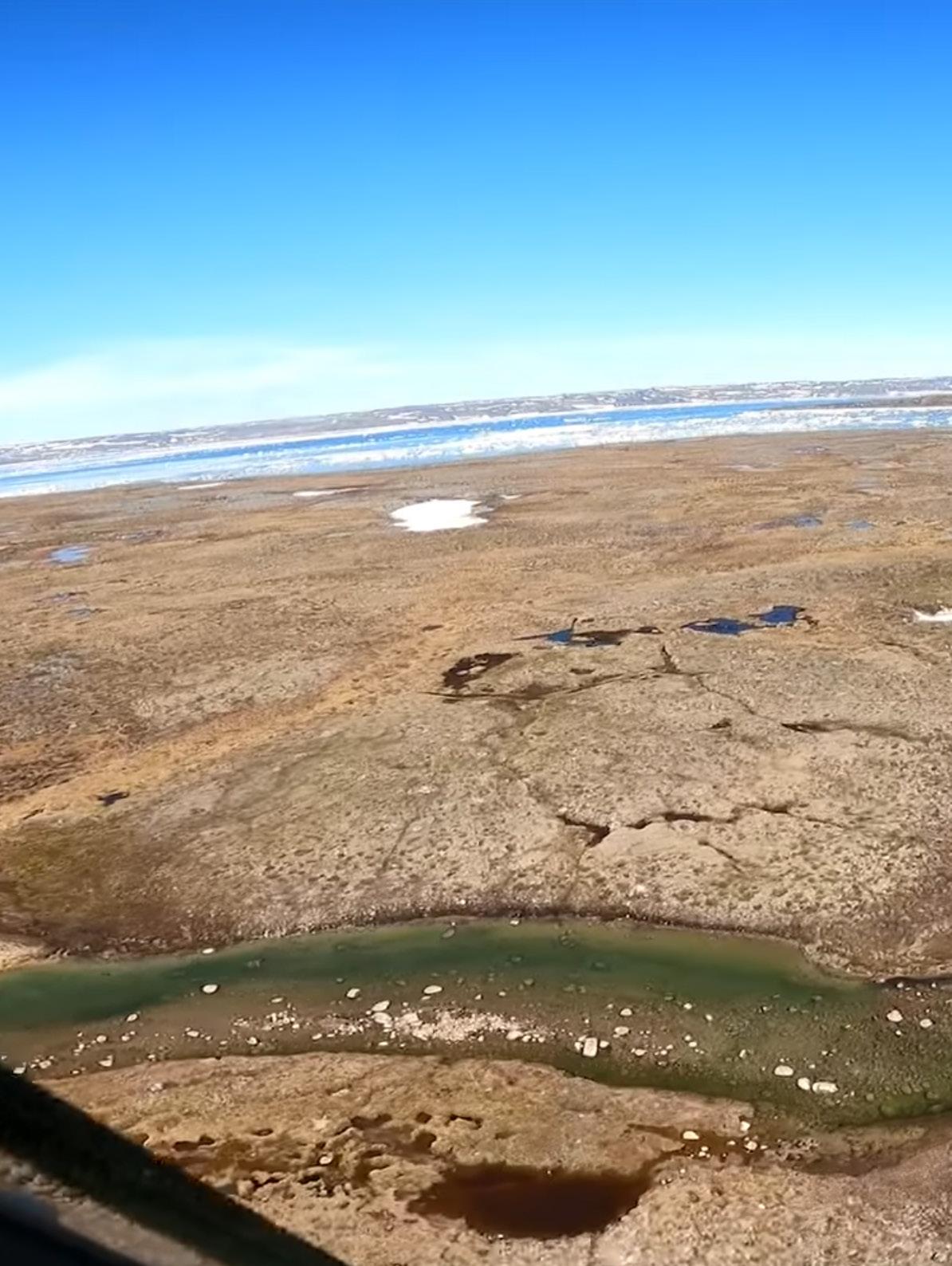
It is not just about what we see on the ground today, but also about ensuring our industry has a net positive impact for future generations of people, flora fauna, and the land.
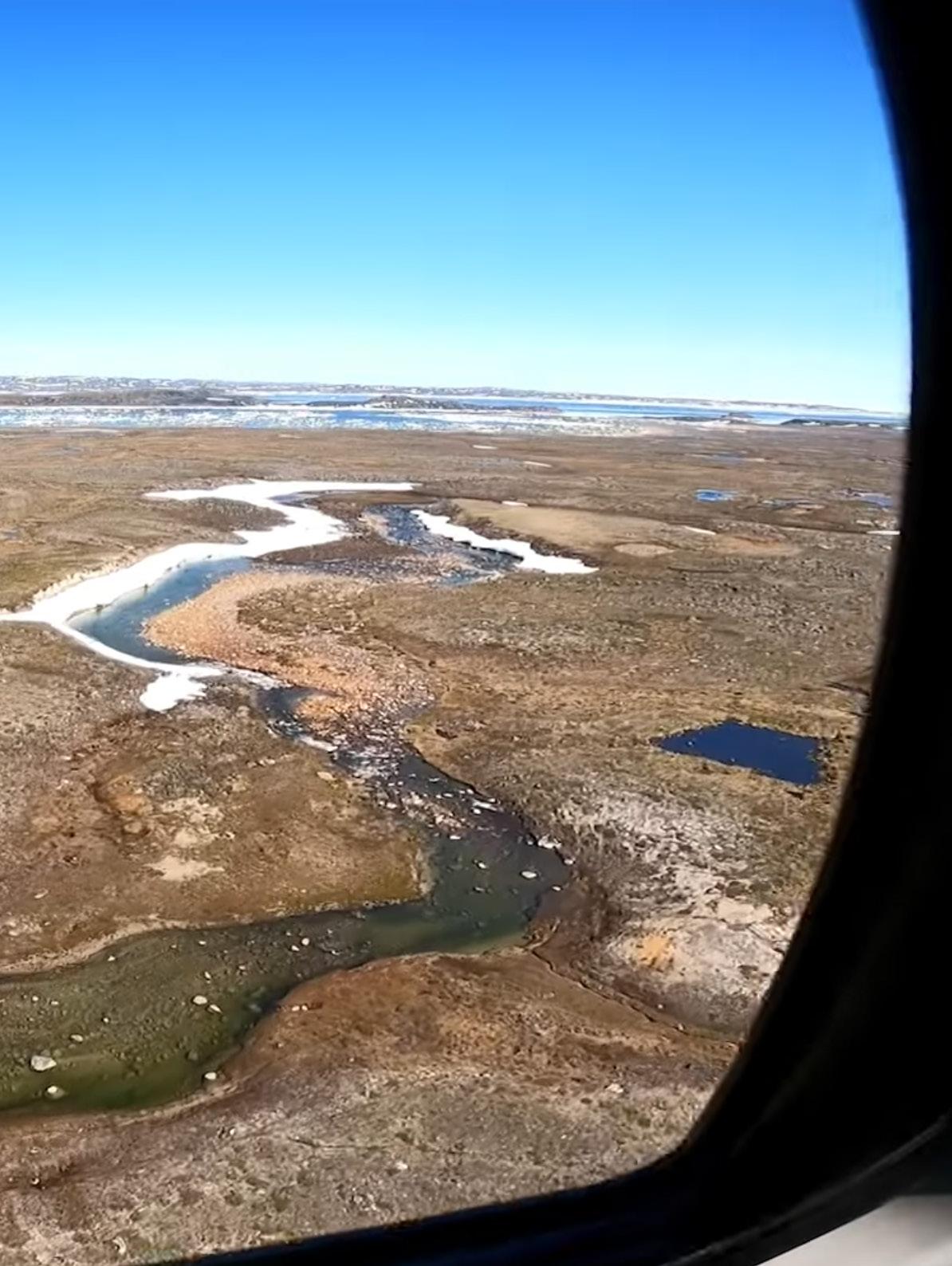
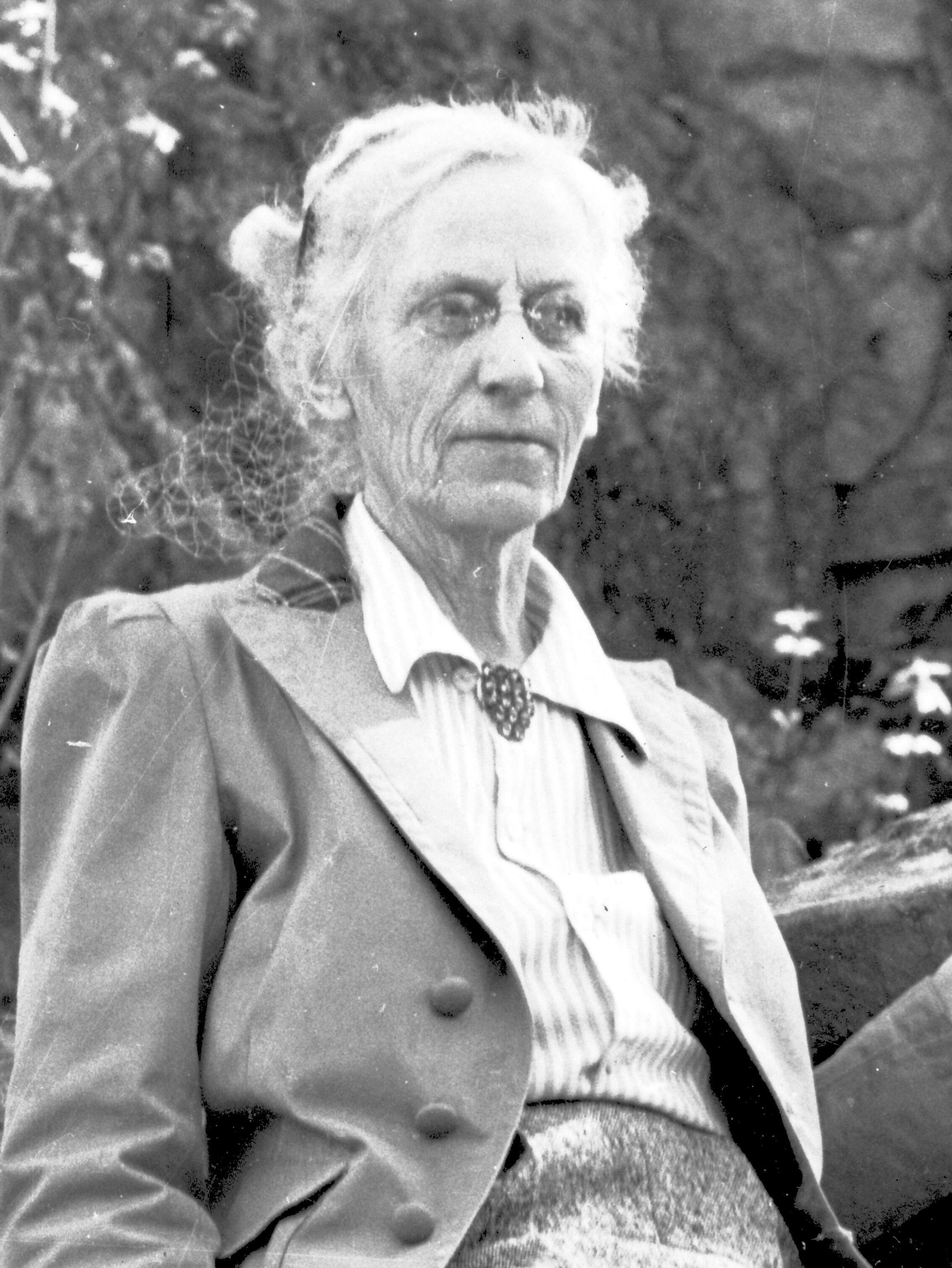
CANADA'S FIRST FEMALE GEOLOGIST
Over a century ago, Dr. Alice Evelyn Wilson overcame illness and blazed through cultural challenges to earn national and global recognition – paving the way for women to enter the field of geology.

On August 26, 1881, in Cobourg, Ontario, Alice Evelyn Wilson was born into an academically inclined household. With her grandfather, William Kingston, head of the Mathematics and Geology Department of Victoria University, her father, Dr. John Wilson a Victoria College professor of classics at the University of Toronto, a brother who was a geologist and a second brother a mathematician, it was all but certain her path would lead to academia.
During this time period, however, “academia” for women commonly meant being placed in classrooms as a teacher – not heads of departments, specialists in their field. Alice's family upbringing also included the great outdoors in northern Ontario – camping, canoeing, and collecting fossils – so from an early age her career pursuit was not one that would keep her indoors for long.
She began studying languages and history at Victoria College in Toronto, however before completing her last year, her life-long bout with anemia became severe. She was forced to leave her studies with an incomplete Honours Bachelor of Arts. It took years to recover from her condition, however her passion for palaeontology and established skillset collecting fossils during her youth earned her a position in the Mineralogy Division at the University of Toronto Museum. With this position and educational background, Alice qualified to work for the Geological Survey of Canada (GSC), and in 1909 was given a role as a clerk in the invertebrate palaeontology section at the Victoria Memorial Museum in Ottawa. There, she worked under Percy Raymond – the GSC’s chief palaeontologist who recognized the importance of Alice being the first woman to be employed in a professional capacity by the GSC and advocated for her advancement. Impressed by Alice's detailed work cataloguing and labelling collections, and her knowledge of languages, Percy approached her to translate a textbook of palaeontology from German to English. He also encouraged Alice to finish her degree while continuing to work at the GSC, and in 1911 she completed her studies and was granted a permanent position.
Alice sought to continue advancing her career, and in 1915 applied for paid leave from the GSC to achieve her doctorate. Her male colleagues had applied for the same leave and were granted it, however, Alice was not approved. The GSC would continue to reject her application for the next ten years. During that decade, Alice did important work and made great contributions to the field. Along with Percy, she published an article on a newly discovered species of brachiopod, paid for
her own trip to New York to study comparative anatomy and marine biology, and joined the Canadian Women’s Army Corps during World War I.
At the end of the war – after proving her strength to her colleagues, and academic abilities to the GSC – she continued to be rejected for paid leave to complete her post-graduate work. Then in 1926, the Canadian Federation of University Women (CFUW) awarded Alice a scholarship to pay for her doctorate studies. Unfortunately, the GSC further denied Alice leave to accept the scholarship. This led the CFUW to lobby the highest levels in the federal government for Alice, and she was eventually granted academic leave by the GSC. So in 1929 – at the age of 49 – Alice graduated from the University of Chicago with a doctorate in geology.
Even with a doctorate, Alice was met with hesitation by her colleagues to be acknowledged as an equal. For example, it wasn’t until 1940 before she was promoted by the GSC even to associate geologist – seen as more of a supporting designation than a full “geologist”. However, this denial of professional recognition did not stop Alice from creating outstanding work in the field.
As the GSC’s policy was not to allow women to travel with male colleagues for remote surveys (the GSC did not stop barring women from conducting field work until 1970) she used her experiences of remote camping and travelling in northern Ontario as a child to her benefit, and did solo trips into the Ottawa-St. Lawrence Valley. At the time, this was an unstudied geological area, but Alice persevered on her own deep into the region on foot, by bicycle, and when the GSC denied to supply her with a vehicle (even though vehicles were supplied for her male colleagues), she bought her own car to complete the assignment.
In the end, Alice’s research and cataloguing of both the geology and fossil record in the region were unprecedented, and the results of her fieldwork was published by the GSC in 1946. This was the first major geological publication about the area, and remains to this day a distinguished source –used as a reference base around the world.
Following this publication, Alice continued to create respected studies of the stratigraphy of Ontario and Québec, and completed important research on invertebrate fossils throughout Canada. Her work on the National Type Collection of fossils during this time is still an internationally recognized collection. And in 1935, Alice was chosen by the British government to become a Member of the Order of the British Empire for her accomplishments as a woman in federal service. Alice’s decades-long achievements also earned her eventual recognition nationally – she was one of the first two women elected as Fellows of the Royal Canadian Geographical Society, the first female Fellow of the Royal Society of Canada, and the very first Canadian woman to be admitted to the Geological Society of America. Ottawa’s Carleton University formally recognized her as a geologist and conferred on her an honourary degree in 1960. With all of this, the GSC finally gave Alice the recognition she deserved, and named after her the Alice Wilson Hall in their Ottawa headquarters. In 1991, the Royal Society of Canada established the Alice Wilson Awards for emerging women scholars, and she was inducted into the Canadian Science and Engineering Hall of Fame in 2005.
Aside from the designations and honours, Alice more importantly created a large body of work that was foundational to study of certain geographical regions of Canada, and to the understanding of invertebrate palaeontology. This included authoring 50 scientific papers, as well as reference maps for over 14,000 square kilometres of the OttawaSt. Lawrence Lowlands. She also published an endearing children’s textbook on geology ( The Earth Beneath our Feet ), and was a popular lecturer in Palaeontology at Carleton, where she became known by the students as “the rock doctor.”
After this incredible career, Dr. Alice Wilson died in 1964 at 83 years old. She spent all of her professional time at the GSC in Ottawa, and in fact, had only left her offices there a few months before her death. She left behind a transformational legacy that paved the way for women to excel in the field of geology.
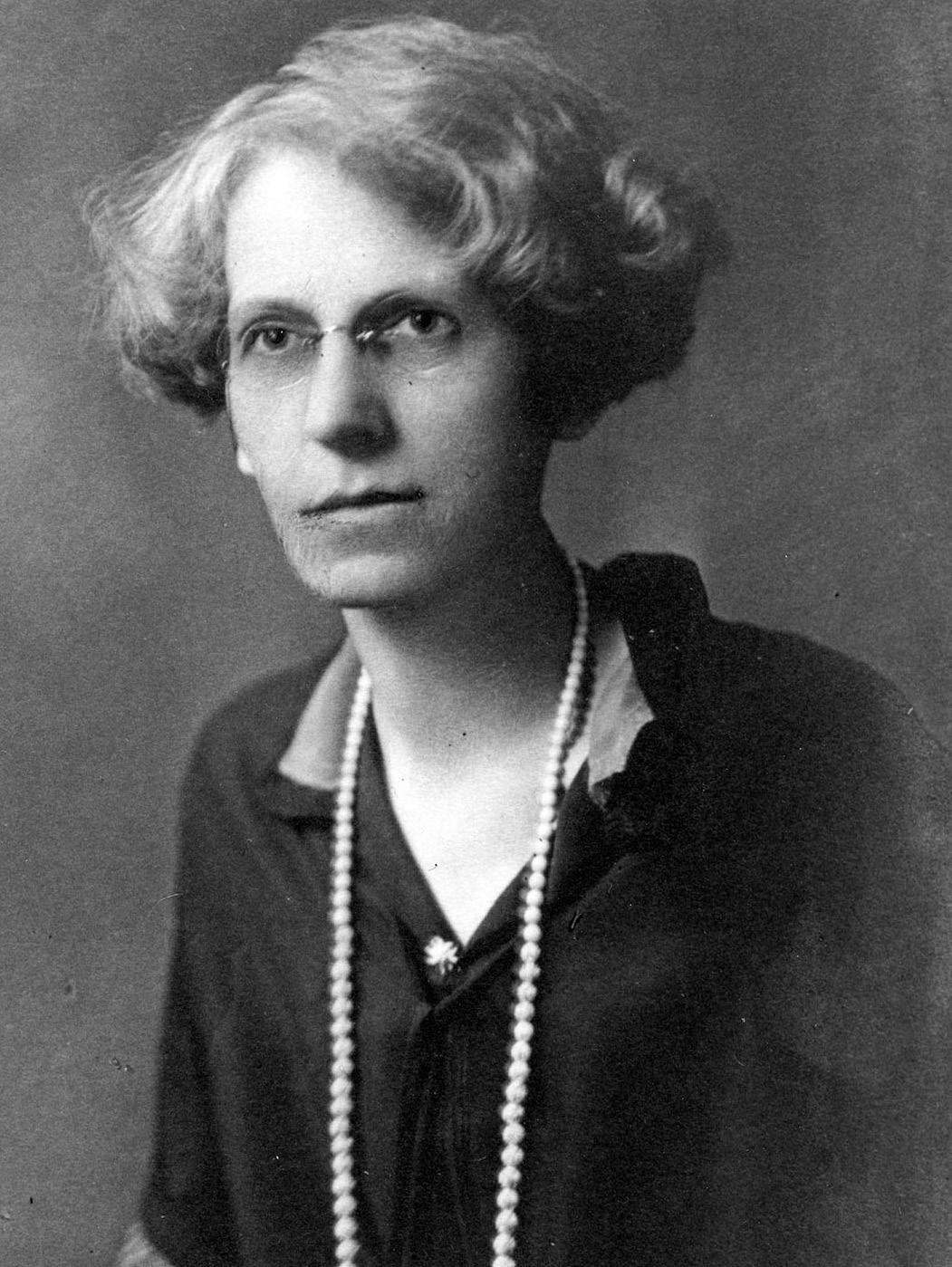
With reference to further field work of the more strenuous type, I would like to point out that while not heavily built, I am muscularly very strong, and from earliest childhood have been accustomed to an out-of-door life.

Karen Rees PRESIDENT
Scott Parsons FIRST VICE PRESIDENT
Conrad Dix SECOND VICE PRESIDENT
Rosario Astuvilca-Rojas INCLUSIVE MINING
Charles Beaudry ORE GROUP
Kurt Breede SCOTIABANK
MaryAnn Crichton HATCH LTD.
Conrad Dix AGNICO EAGLE
Lana Eagle CONSULTANT
Siri Genik BRIDGE©
David Harquail FRANCO-NEVADA CORPORATION
Mary Louise Hill LAKEHEAD UNIVERSITY
Roger Lemaitre HOMELAND URANIUM CORP.
Jessie Liu-Ernsting FIREFLY METALS
Terry Lynch POWER METALLIC MINES INC.
Lisa McDonald EXECUTIVE DIRECTOR
Maria Milanova SECRETARY
James Lusby TREASURER
Gordon Maxwell GJM MINING
Stuart McCracken TECK RESOURCES LIMITED
David Murray RESOURCEFUL GEOSCIENCE SOLUTIONS
Scott Parsons ALAMOS GOLD
Valerie Pascale MODERN CORE
Karen Rees INDEPENDENT CONSULTANT AND DIRECTOR
Keith Spence GLOBAL MINING CAPITAL CORP.
Rob Stevens PAKAWAU GEOMANAGEMENT INC.
Jeff Swinoga EXPLOITS DISCOVERY CORP.
Kerem Usenmez VOLTA METALS LTD.
Mary-Carmen Vera
Valerie Wilson SLR CONSULTING (CANADA) LTD.
Ariya Andrighetti MANAGER, CONVENTION
Alexandra Armstrong ANALYST, INDIGENOUS & REGULATORY AFFAIRS
Scott Barber SENIOR MANAGER, COMMUNICATIONS
Gillian Blakey COORDINATOR, CONVENTION EXHIBITS
Amy Buchanan MANAGER, CONVENTION EXHIBITS
Lynn Bodwell CONVENTION MARKETING LEAD
C urtis Byron WEB COORDINATOR , COMMUNICATIONS
Shanti Chary DATABASE COORDINATOR
Christy Clough COORDINATOR, CONVENTION
Michael D’Amelio COORDINATOR, CONVENTION PROGRAMMING
Sandra Doig COORDINATOR, MEMBERSHIP
Louise Healion OFFICE ASSISTANT
Lynda Joyet SENIOR MANAGER, CONVENTION EVENTS & SPONSORSHIP
Madina Kaytmazova MANAGER, IT & ADMINISTRATION
Sonali Khatokar COORDINATOR, CONVENTION PROGRAMMING
Jeff Killeen DIRECTOR, POLICY & PROGRAMS
Nicole Kulp ANALYST, SUSTAINABILITY
Amit Kumaria MANAGER, BUSINESS DEVELOPMENT & STRATEGIC PARTNERSHIPS
Joan Marilyn Leslie CHIEF ACCOUNTANT
Romika Leslie COORDINATOR, SPONSORSHIP
Florence MacLeod MANAGER, MEMBER ENGAGEMENT & OUTREACH
R an Maoz ANALYST, TAX POLICY & CAPITAL MARKETS
Lisa McDonald EXECUTIVE DIRECTOR
Krishana Michaud MANAGER, STUDENT & EARLY CAREER PROGRAM
Maria Avramova Milanova SECRETARY, DIRECTOR, OPERATIONS & HUMAN RESOURCES
Andrea Murdoch EXECUTIVE ASSISTANT
Alissa Nardini COORDINATOR, CONVENTION EXHIBITS
Sarah Nazar MANAGER, CONVENTION PROGRAMMING
Marion Oliver ANALYST, CRITICAL MINERALS, GEOSCIENCE & INNOVATION, HEALTH & SAFETY
Maureen Owens COORDINATOR, CONVENTION PROGRAMMING
Addison Pennie COORDINATOR, STUDENT & EARLY CAREER PROGRAM
Nicole Sampson DIRECTOR, CONVENTION
Steve Shapka ANALYST, GOVERNMENT RELATIONS
Andy Stanleigh PUBLICATIONS EDITOR & DESIGNER
Kulpreet Thukral COORDINATOR, MEMBERSHIP
Patricia Tucci COORDINATOR, CONVENTION EVENTS & SPONSORSHIP
Petrona Tulloch STAFF ACCOUNTANT
Stefanie Wolf MANAGER, CONVENTION OPERATIONS
Alex Zhoravovich COORDINATOR, COMMUNICATIONS
